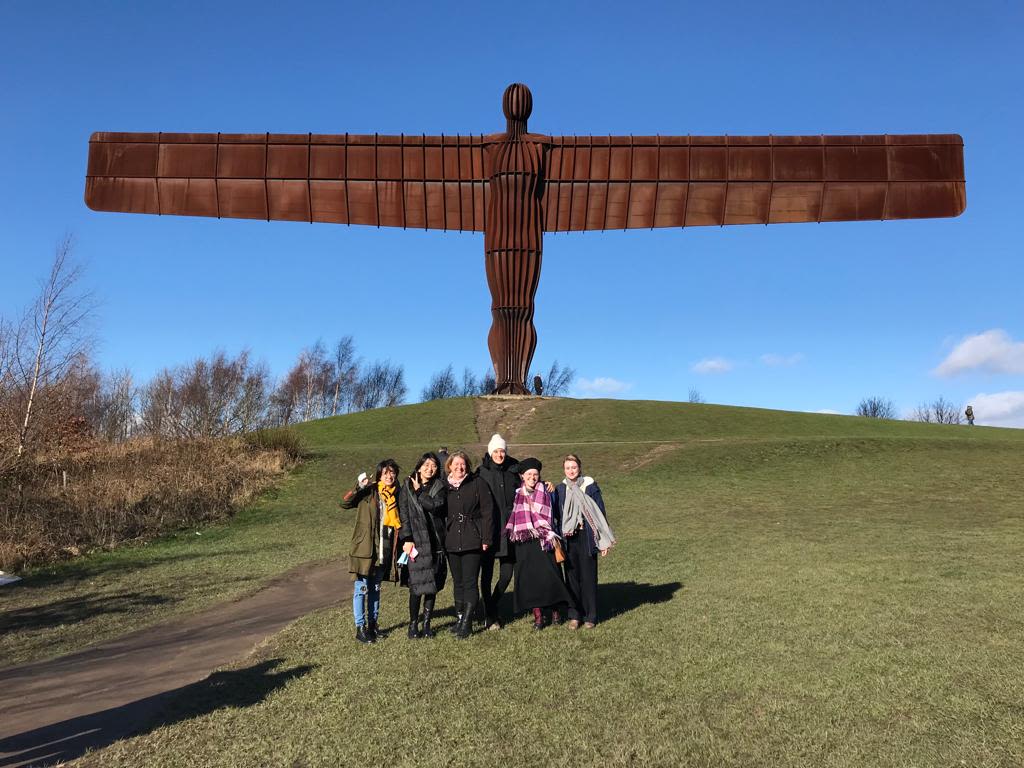Enchanted Treasures
Russian Folk Art in the Kirill Sokolov Collection
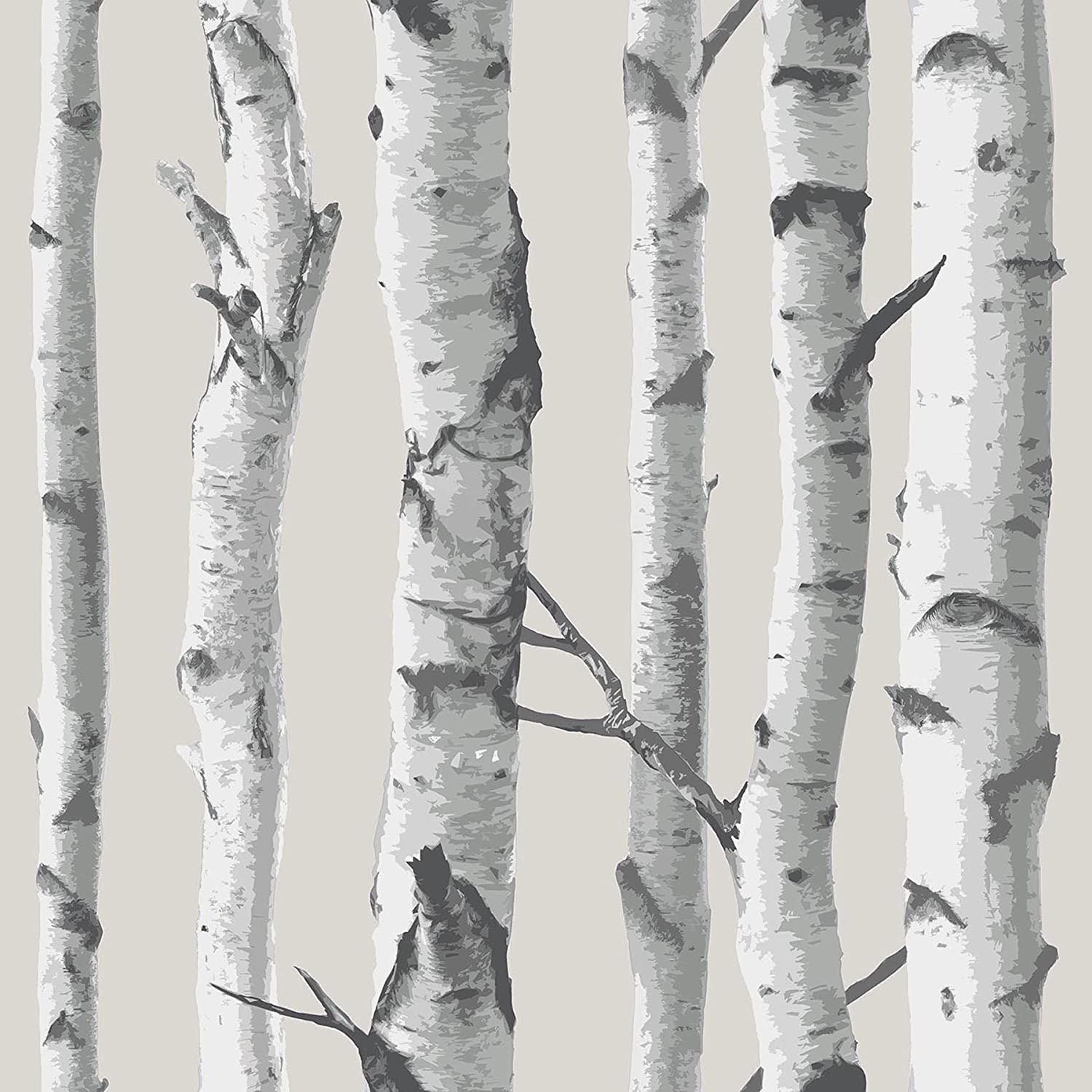
Kirill Sokolov
(1930-2004)
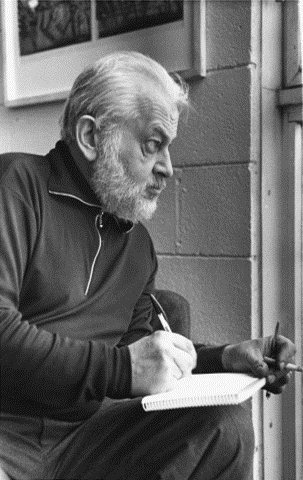
Photograph of Kirill Sokolov sketching taken by David Watson.
Kirill Sokolov was a Russian artist who moved to the UK in 1974.
Following a devastating house fire in 1981 that destroyed many of Sokolov’s works, his family moved to Durham where his wife, Avril, worked at the university.
In their Durham home, Sokolov painted the furniture and walls in folk art style, imitating rural Russian homes. The house was also decorated with folk art objects collected in Russia, many of which are now housed in the Oriental Museum.
Sokolov maintained his connection to Russia with frequent visits after 1990 following the perestroika movement, continuing to grow his collection.
Although Kirill died in 2004, his wife Avril and daughter Irina continue to celebrate his work and legacy wanting to educate everyone about Russia and its culture.
We had the pleasure of interviewing Avril and Irina as part of this exhibition.

Photograph of Kirill Sokolov sketching taken by David Watson.
Photograph of Kirill Sokolov sketching taken by David Watson.
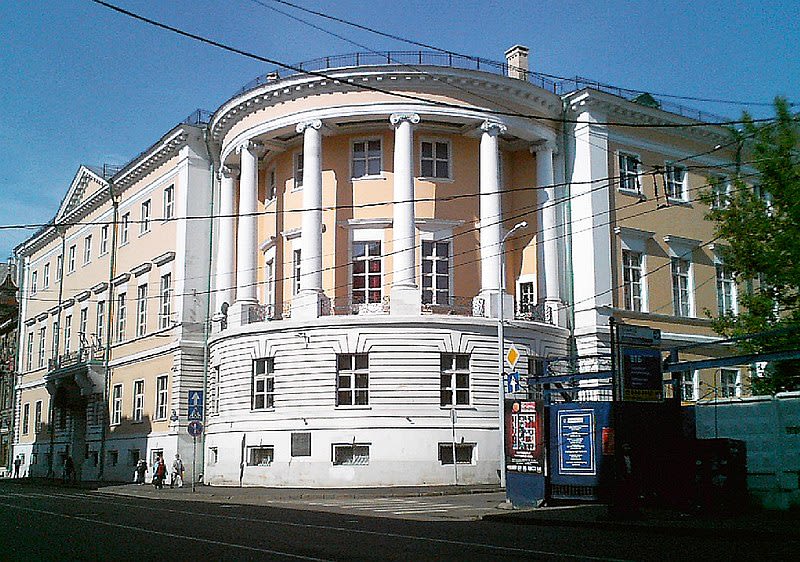
Surikov Institute by Vladimir OKC. From Wikimedia Commons.
Surikov Institute by Vladimir OKC. From Wikimedia Commons.

From the World Festival of Youth and Students Collection, ARCH01667, International Institute of Social History, Amsterdam.
From the World Festival of Youth and Students Collection, ARCH01667, International Institute of Social History, Amsterdam.
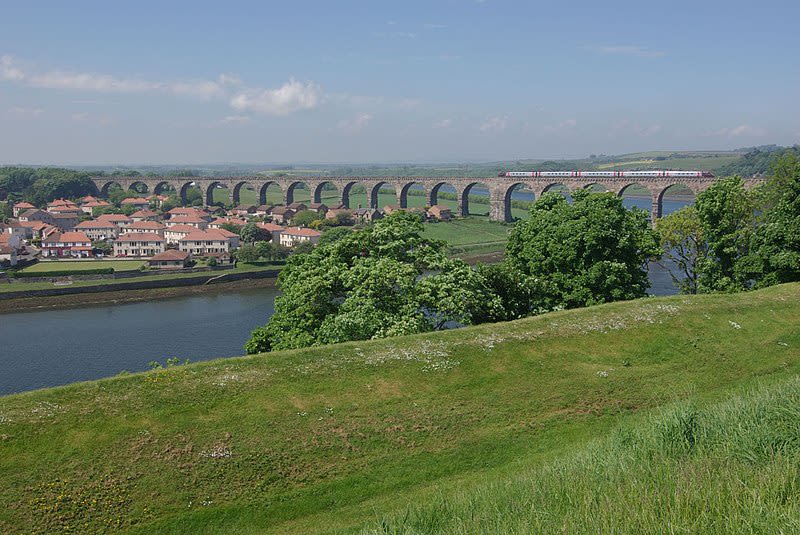
River Tweed, Berwick upon Tweed by Stephen McKay,. From Wikimedia Commons.
River Tweed, Berwick upon Tweed by Stephen McKay,. From Wikimedia Commons.

Self Portrait of Kirill Sokolov. From The Sutton Gallery.
Self Portrait of Kirill Sokolov. From The Sutton Gallery.
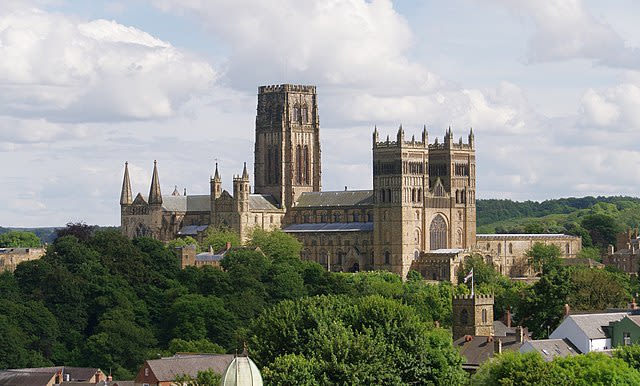
Photograph of Durham Cathedral. From Wikimedia Commons.
Photograph of Durham Cathedral. From Wikimedia Commons.
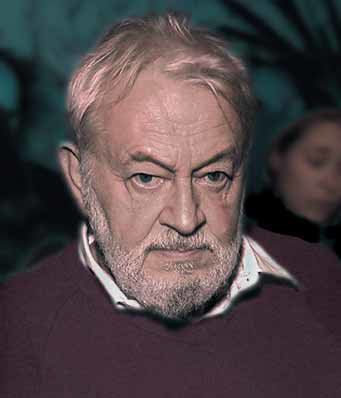
Kirill Sokolov. From The Tretyakov Gallery Magazine, https://www.tretyakovgallerymagazine.com/articles/3-2005-08/kirill-sokolov-never-emigre
Kirill Sokolov. From The Tretyakov Gallery Magazine, https://www.tretyakovgallerymagazine.com/articles/3-2005-08/kirill-sokolov-never-emigre
Timeline of Kirill Sokolov - Russian Artist
Born 27th September, 1930
1930 - Kirill Sokolov was born in Moscow
Born to an aristocratic mother (Irina Konstantinovna Kirshbaum 1906-1981) and architect father (Konstantin Mikhailovich Sokolov 1900-1972). He became a painter, sculptor, printmaker and stage designer, spanning a range of media and art forms.
1942 - Admitted to Special School for Art, Moscow
Sokolov chose this school as it gave student ration cards, as well as teaching art.
Kirill's father was arrested 1945-1950
His father was sent to the Soviet special camps for five years. Kirill witnessed his father's arrest and said that it taught him once and for all, to know fear.
1950

Surikov Institute by Vladimir OKC. From Wikimedia Commons.
1950 - Enrolled at the Surikov Institute
Studying at the Faculty of Graphic Art, becoming fascinated by engraving and privately studied, Picasso’s work, Abstract Expressionism and 20th Century Russian Avant-garde, making him a subversive influence, as all western art was strictly censored.
1952 - Married Ariadna Aveseenko
They had a son Fedor in 1958 but later divorced in 1963.

From the World Festival of Youth and Students Collection, ARCH01667, International Institute of Social History, Amsterdam.
1957 - Graduated from Surikov Institute
At the International Festival Exhibition in Moscow, Sokolov exhibited a series of linocuts illustrating Elsa Triolet’s novels. This was his first public work.
Between 1964 -1974 Sokolov illustrated more than 50 books
Sokolov also painted constantly but did not show or sell his work as a painter.
Met Avril Pyman, and they married in 1963
Avril Pyman, a research student was in Russia as a British Council Scholar to study Alexander Blok, a Russian poet who supported the Russian Revolution. They married, with Khrushchev’s permission in 1963. Their daughter Irina was born in 1965.
1974
1974 - Left Russia to live in England
In 1974 Sokolov made the most difficult decision of his life, driving across the whole of Europe in an old Land Rover, to emigrate to England. Despite leaving Russia, Sokolov would always reflect his homeland in his work.

River Tweed, Berwick upon Tweed by Stephen McKay,. From Wikimedia Commons.
1974-1981 - Living in Berwick-upon-Tweed, England
Sokolov's English improved helping him live and work in the UK. He felt it important to educate people he met about Russia and its culture. He began to become known in local art circles and internationally by becoming co-editor of the art journal, ‘Leonardo’ and a member of the Society of Graphic Fine Art.

Self Portrait of Kirill Sokolov. From The Sutton Gallery.
1981 - Fire destroys his home and works
This is a seminal moment in his work as he had struggled in the UK, did not like the country, and he suffered from depression. But after the fire he went back into the still-warm ruins and was inspired by it. He had lost everything and had to reinvent himself and build a new life.

Photograph of Durham Cathedral. From Wikimedia Commons.
1980s-2004 - Lived in Durham
They set up home in Durham, with Avril working at Durham University Sokolov painted tables, chairs, chests, screens, and whole rooms within the house in Russian Folk Art style. While continuing to paint, his reputation and admiration for his work grows, leading to national and international exhibits.
1990
1990 - Sokolov was able to return to the USSR
He held an exhibition at the Academy of Arts, Riga, Latvia. From then on he visited every year, as Avril continues to do today.

Kirill Sokolov. From The Tretyakov Gallery Magazine, https://www.tretyakovgallerymagazine.com/articles/3-2005-08/kirill-sokolov-never-emigre
1980-2004 - Sokolov's exhibitions are held worldwide
Sokolov continued to create artwork until his death, ranging from painting, sculpture, to silk-screen printing and collage.
Spring 2004 - Last exhibition
"In memory of Alexsandr Blok" at the Blok Museum, St. Petersburg. Exhibition of "Faust" prints at Perm Art Museum.
Died May 2004
Sokolov is survived by his wife Avril and daughter Irina. His ashes were returned to Russia.
Sokolov’s works are on display around Durham University and continue to be exhibited worldwide.
The Sokolov Family in Pictures
We had the pleasure of meeting and interviewing Avril Sokolov, the wife of Kirill and his daughter, Irina who both live in Durham. They shared fascinating stories about Kirill's love of collecting objects and the stories behind his collection of Russian folk art.
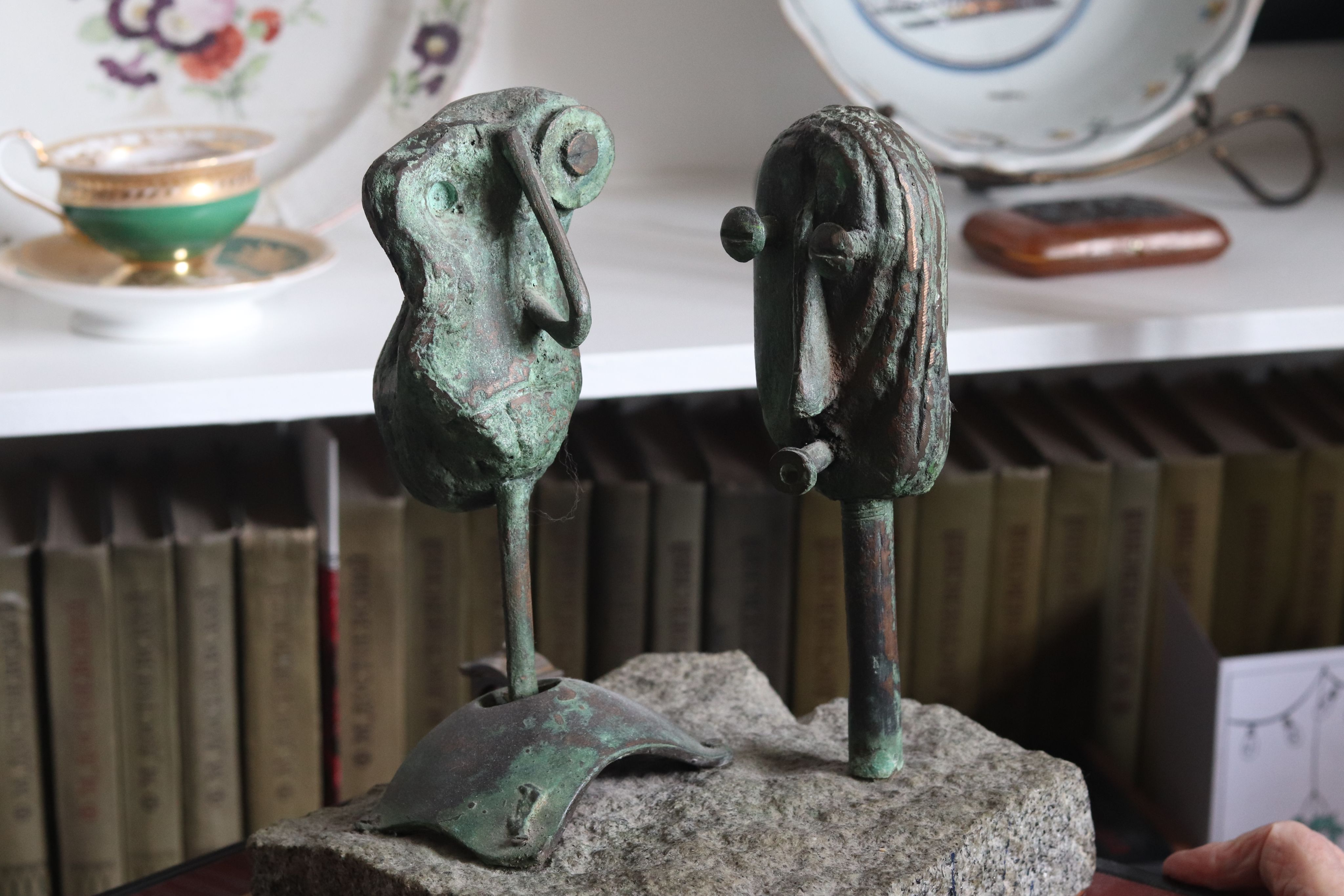
Sculpture by Kirill Sokolov made from everyday items. Photographed by Siqi Yang.
Sculpture by Kirill Sokolov made from everyday items. Photographed by Siqi Yang.
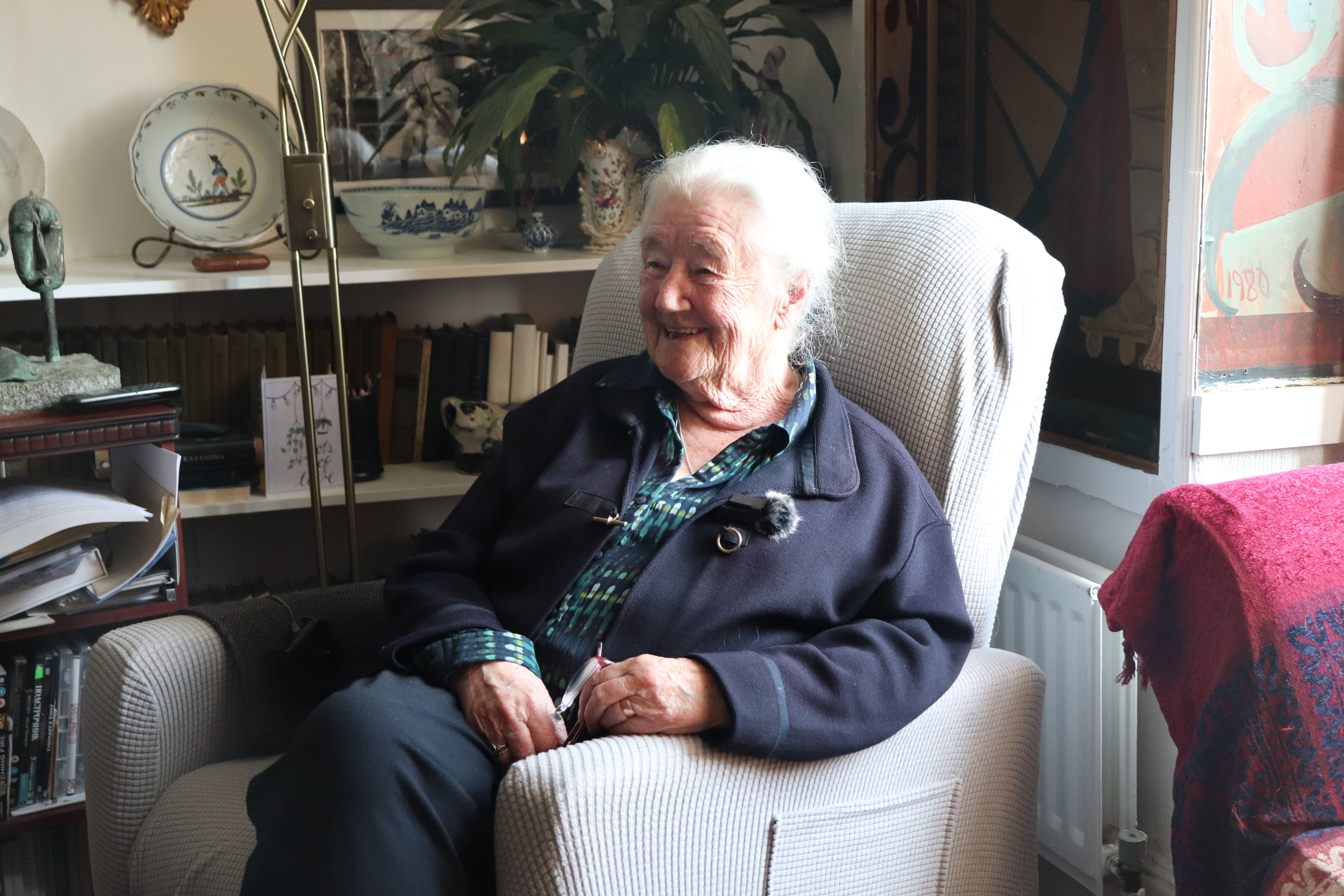
Photograph of Avril Sokolov at home, taking part in an interview about the Sokolov collection, Spring 2022. Photographed by Siqi Yang.
Photograph of Avril Sokolov at home, taking part in an interview about the Sokolov collection, Spring 2022. Photographed by Siqi Yang.
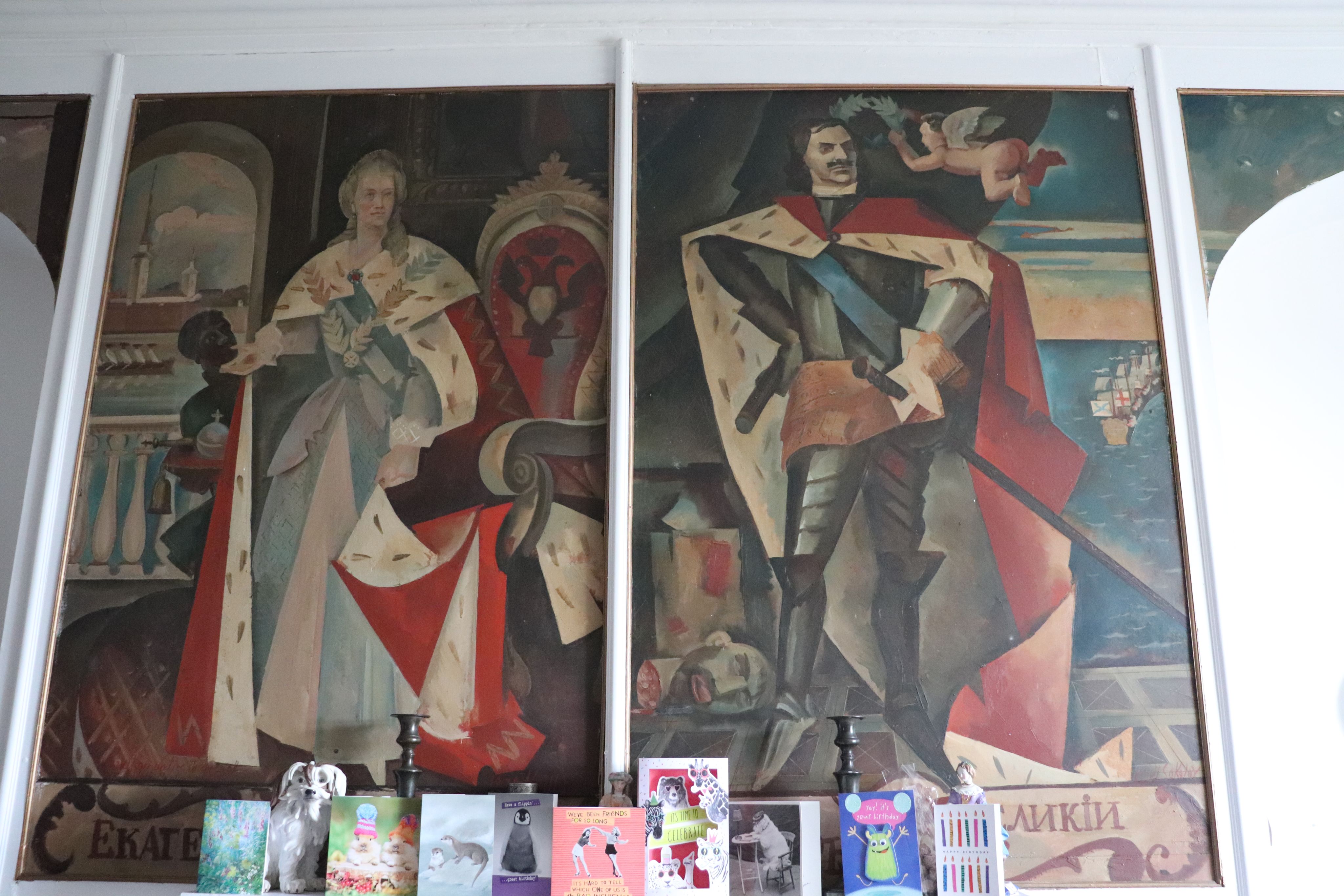
Painting of Peter and Catherine the Great by Kirill Sokolov on the living room wall. Photographed by Siqi Yang.
Painting of Peter and Catherine the Great by Kirill Sokolov on the living room wall. Photographed by Siqi Yang.
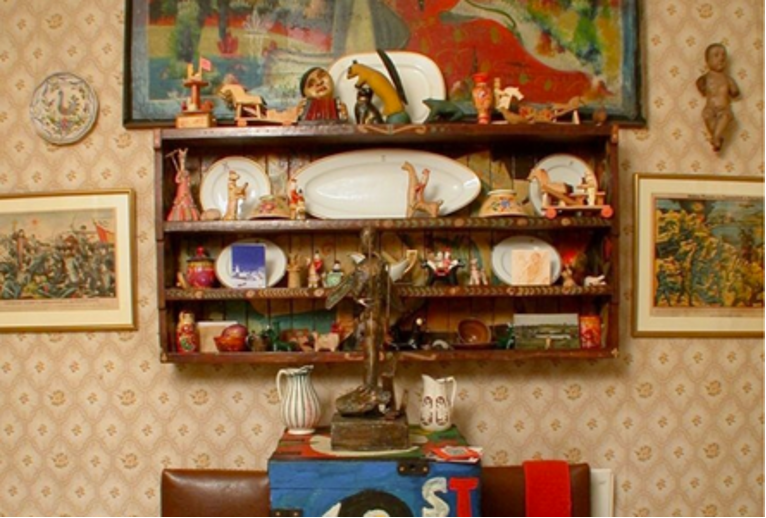
Photograph of some of the Sokolov collection displayed in the kitchen of the Sokolov's home. Photographed by Anthony Parton around 2004.
Photograph of some of the Sokolov collection displayed in the kitchen of the Sokolov's home. Photographed by Anthony Parton around 2004.
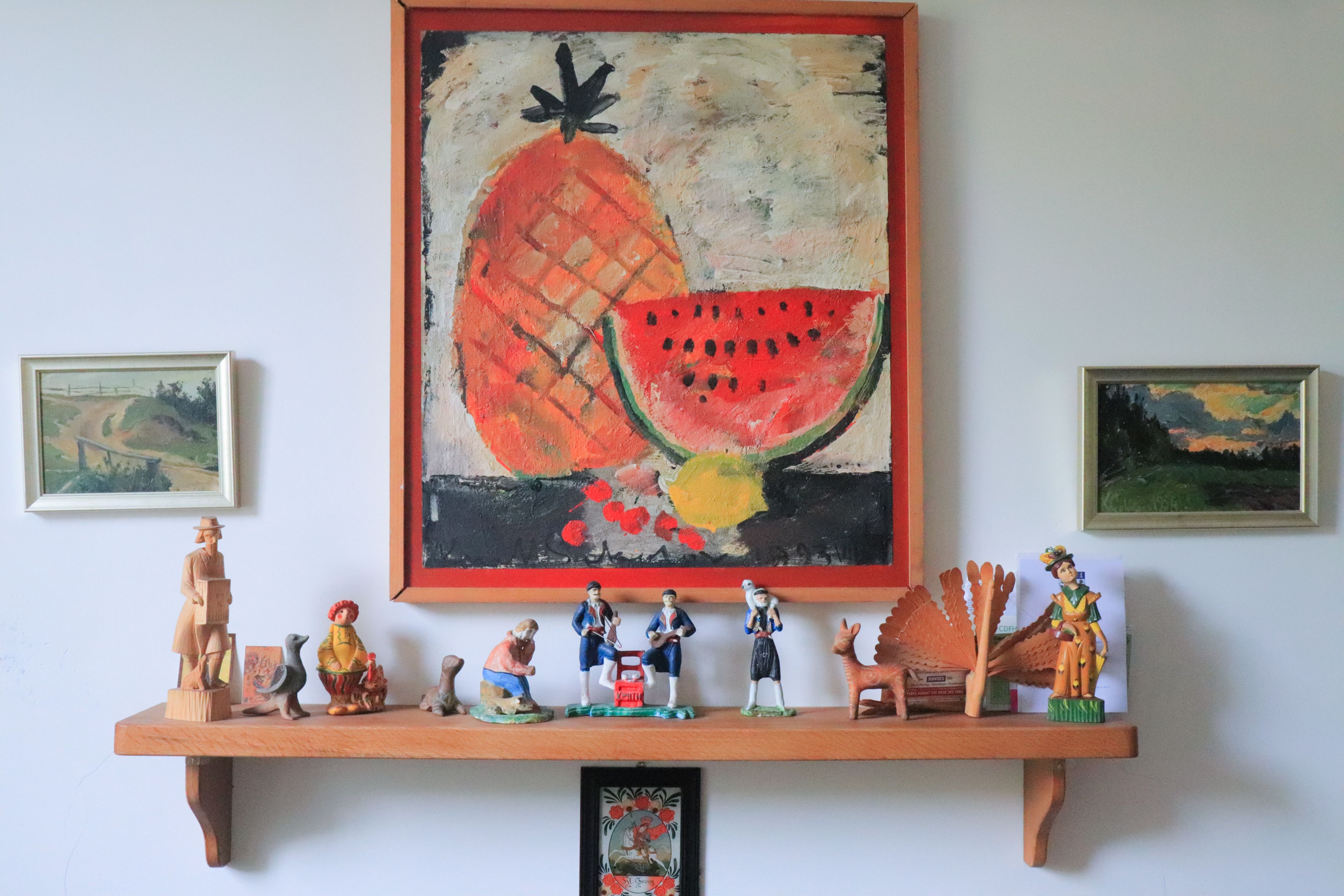
Photograph of paintings and figures in the kitchen of the Sokolov family, Spring 2022. Photographed by Siqi Yang.
Photograph of paintings and figures in the kitchen of the Sokolov family, Spring 2022. Photographed by Siqi Yang.
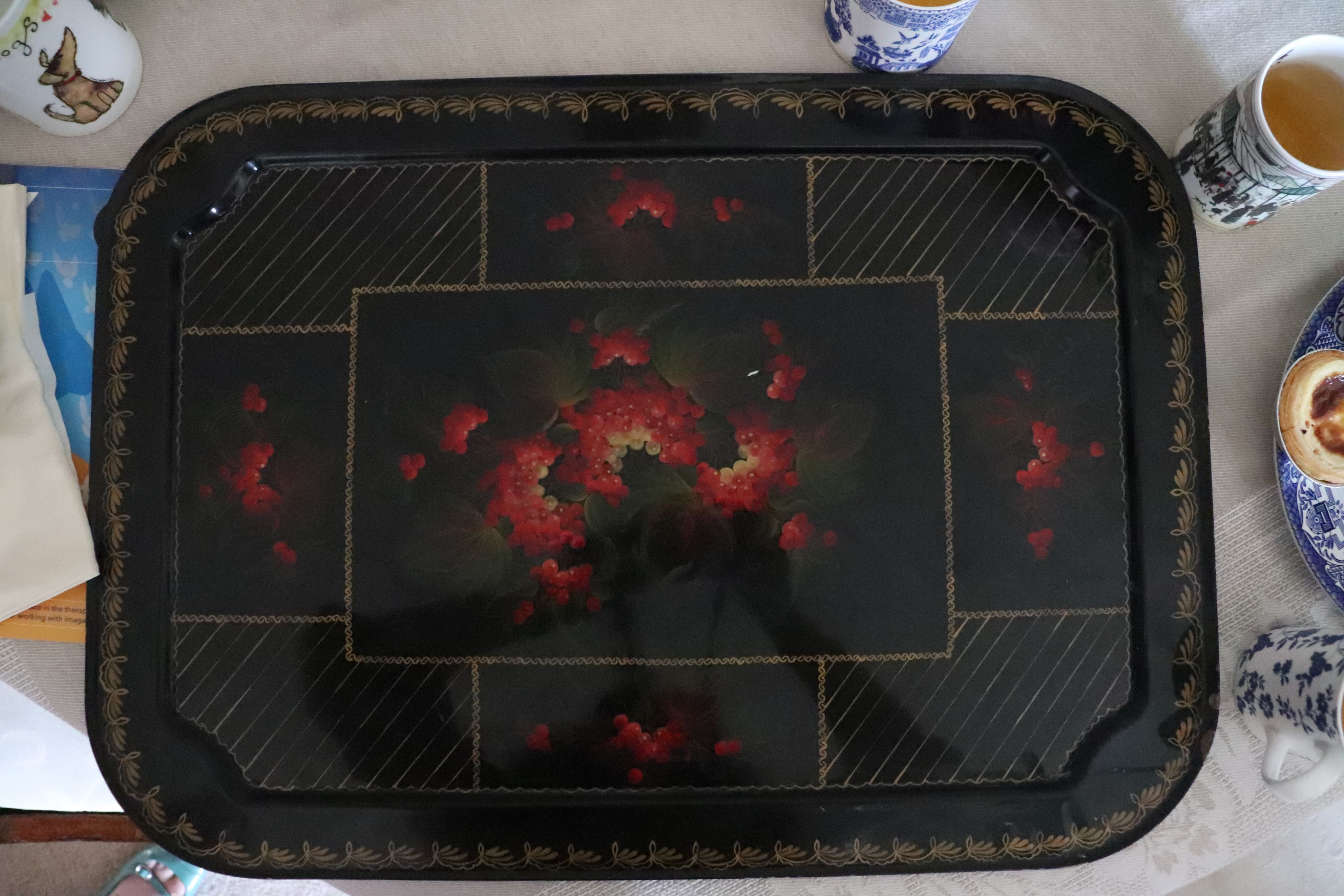
Photograph of a Zhostovo tray used in the household for serving food and drink. Photographed by Siqi Yang.
Photograph of a Zhostovo tray used in the household for serving food and drink. Photographed by Siqi Yang.
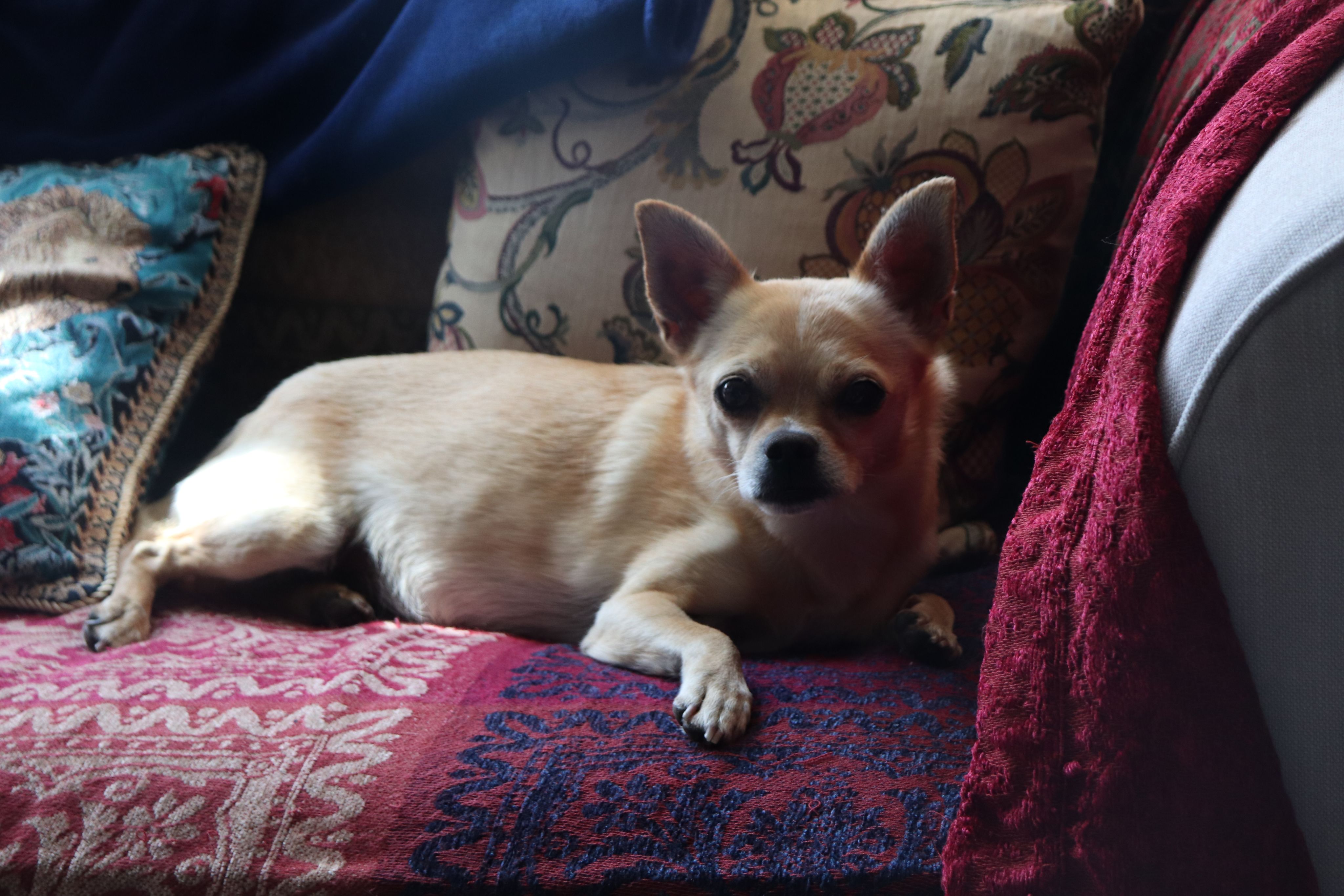
Photograph of the Sokolov's dog Ollie laying on the sofa, Spring 2022. Photographed by Siqi Yang.
Photograph of the Sokolov's dog Ollie laying on the sofa, Spring 2022. Photographed by Siqi Yang.
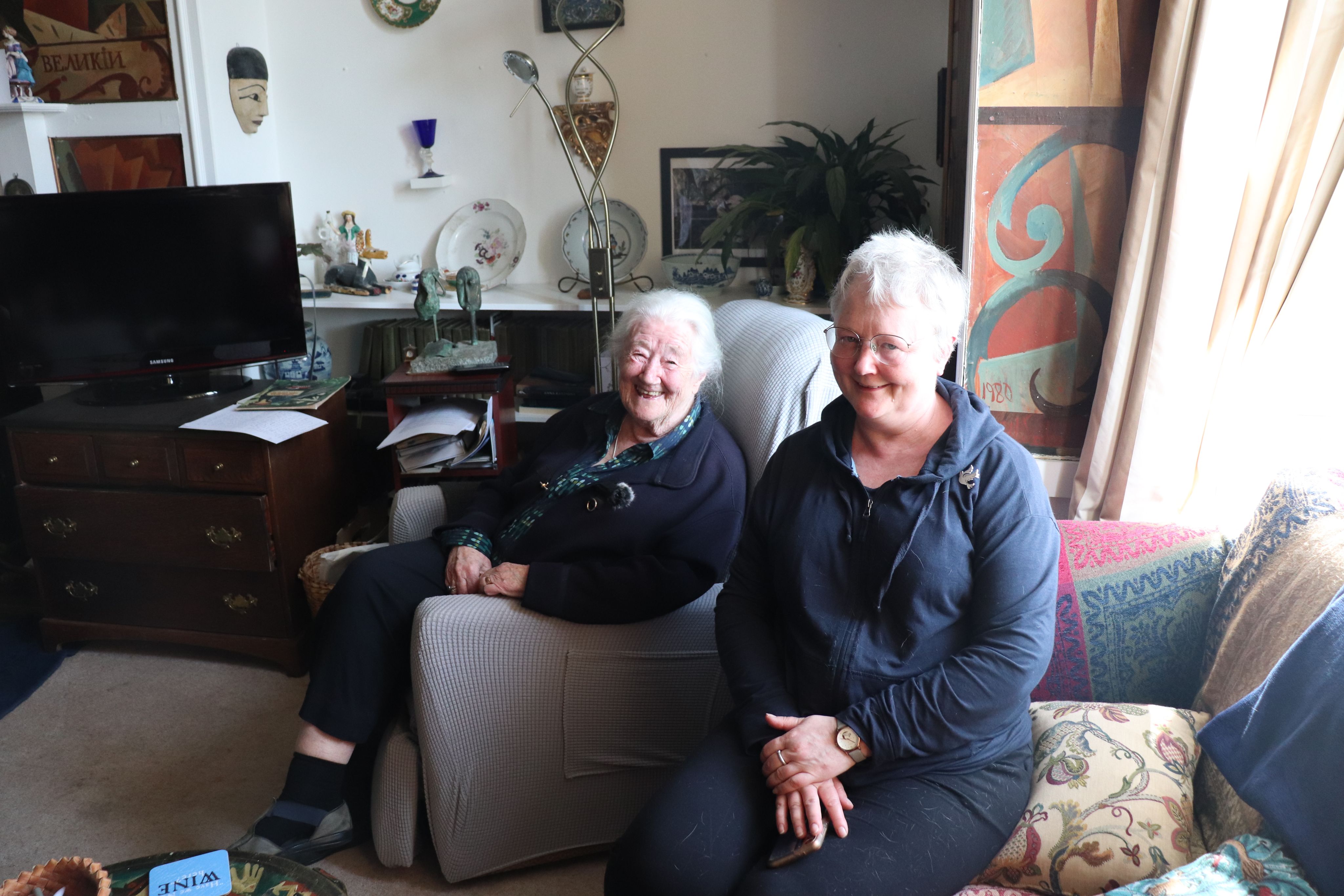
Photograph of Avril and Irina Sokolov taking part in an interview about the Sokolov collection, Spring 2022. Photographed by Siqi Yang.
Photograph of Avril and Irina Sokolov taking part in an interview about the Sokolov collection, Spring 2022. Photographed by Siqi Yang.
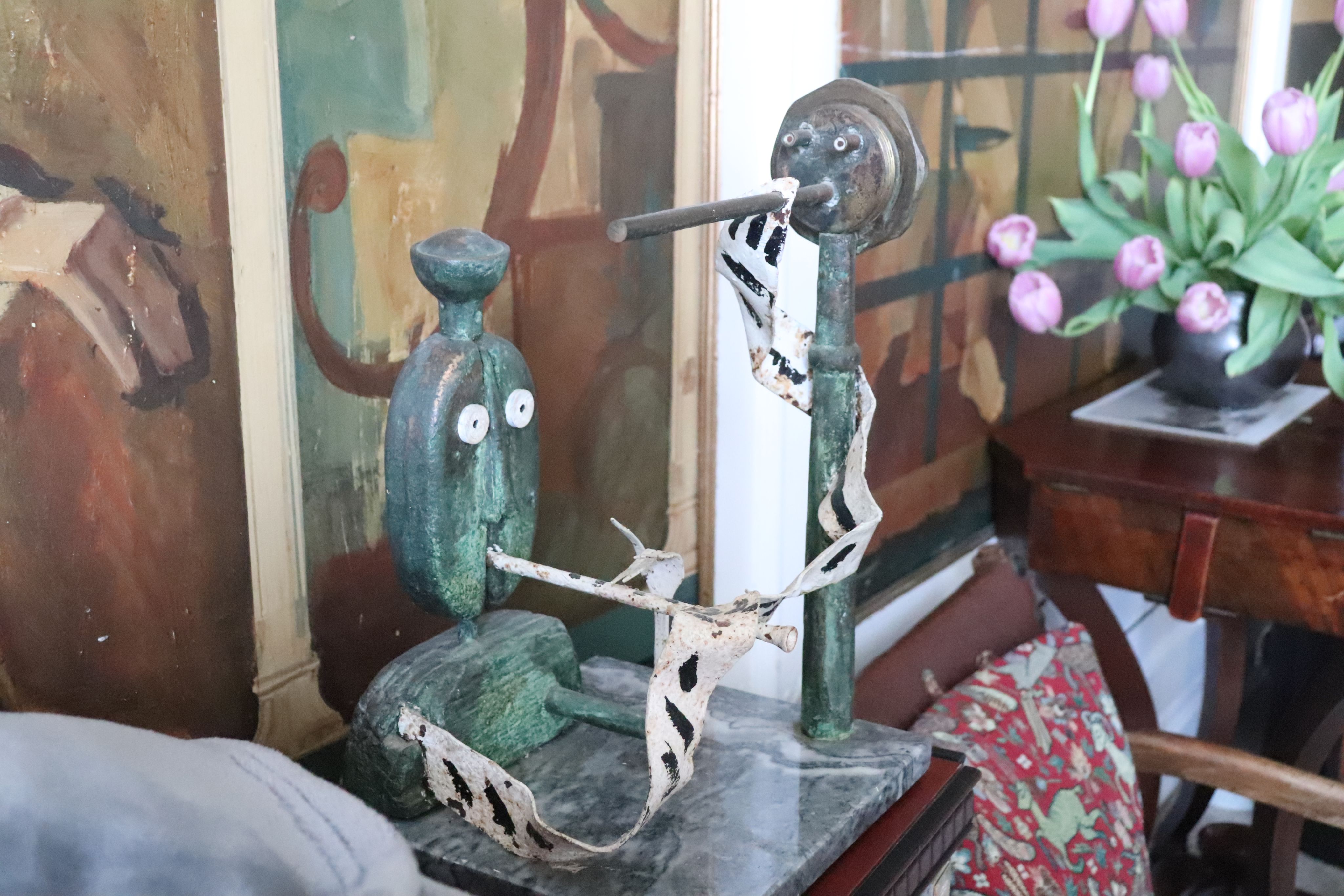
Sculpture by Kirill Sokolov playing a flute. The sculpture is made from everyday items, with hands made from forks. Photographed by Siqi Yang.
Sculpture by Kirill Sokolov playing a flute. The sculpture is made from everyday items, with hands made from forks. Photographed by Siqi Yang.
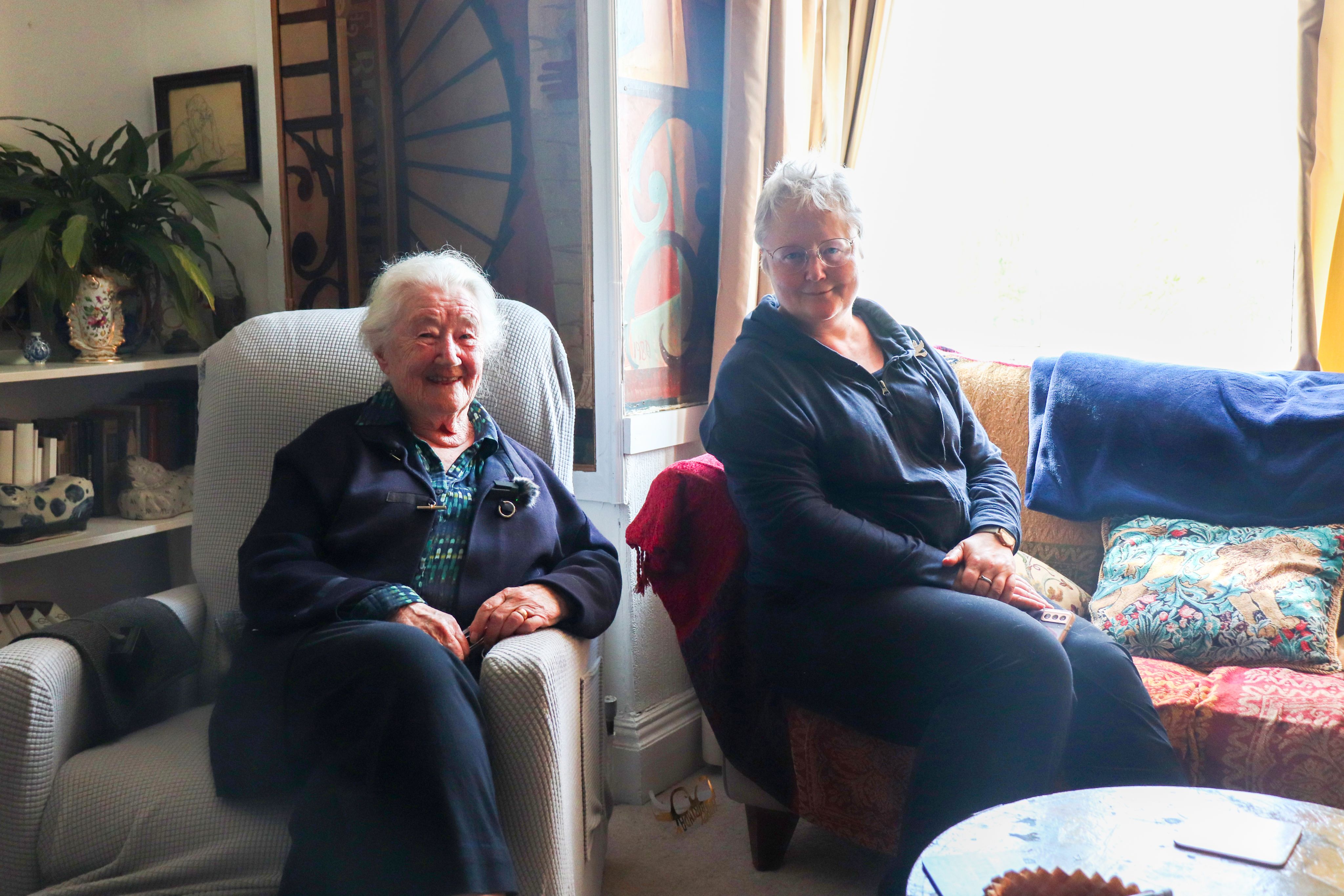
Photograph of Avril and Irina Sokolov taken during the interview on the Sokolov collection, Spring 2022. Photographed by Siqi Yang.
Photograph of Avril and Irina Sokolov taken during the interview on the Sokolov collection, Spring 2022. Photographed by Siqi Yang.
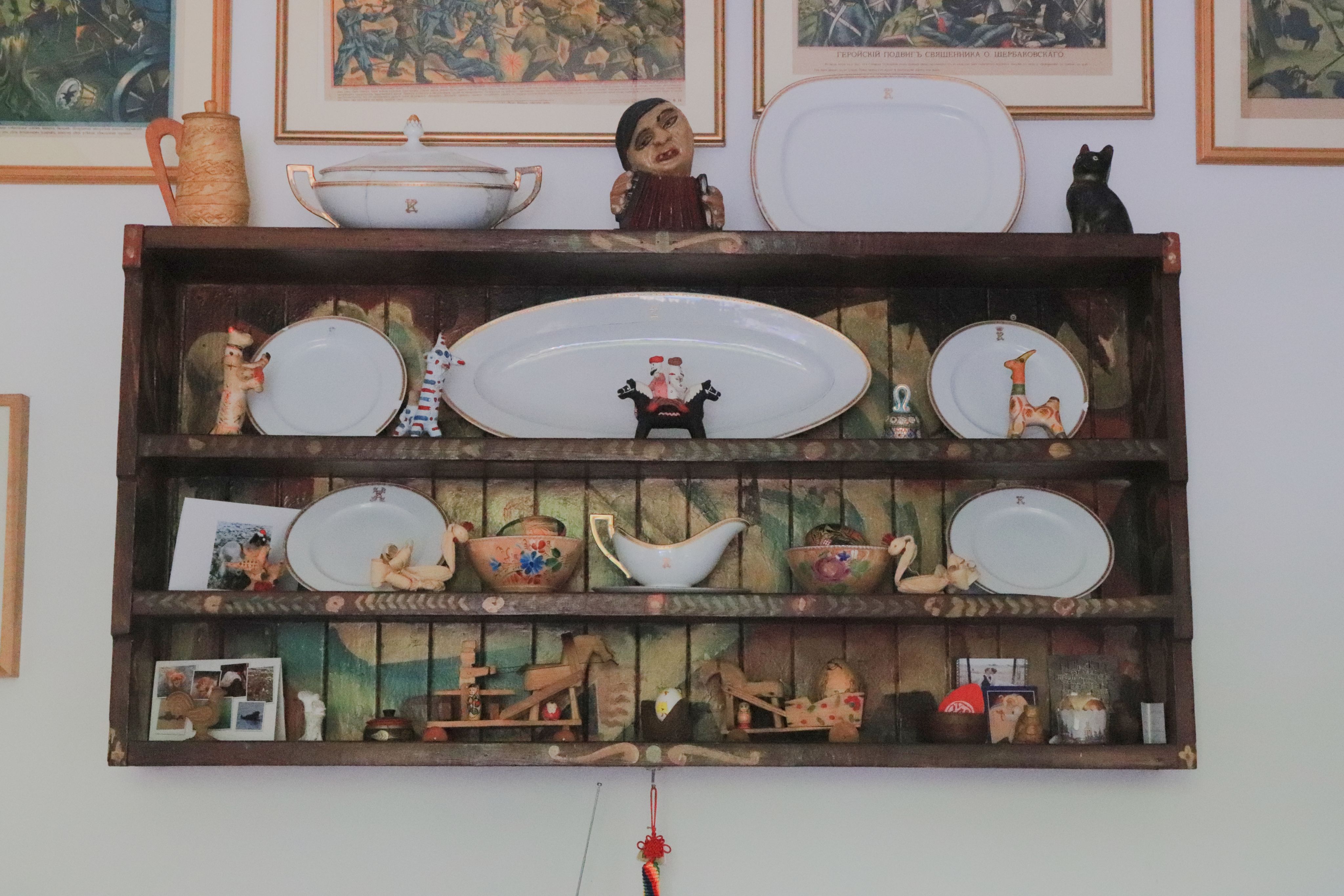
Photograph of some of the Sokolov collection displayed in the kitchen of the Sokolov's home, Spring 2022. Photographed by Siqi Yang.
Photograph of some of the Sokolov collection displayed in the kitchen of the Sokolov's home, Spring 2022. Photographed by Siqi Yang.
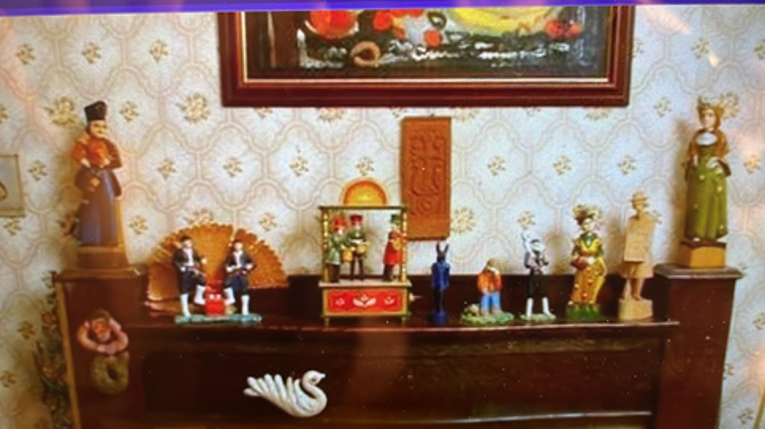
Photograph of some of the Sokolov collection displayed in the kitchen of Sokolov's home. Some of them were donated to Oriental Museum. Photographed by Anthony Parton around 2004.
Photograph of some of the Sokolov collection displayed in the kitchen of Sokolov's home. Some of them were donated to Oriental Museum. Photographed by Anthony Parton around 2004.
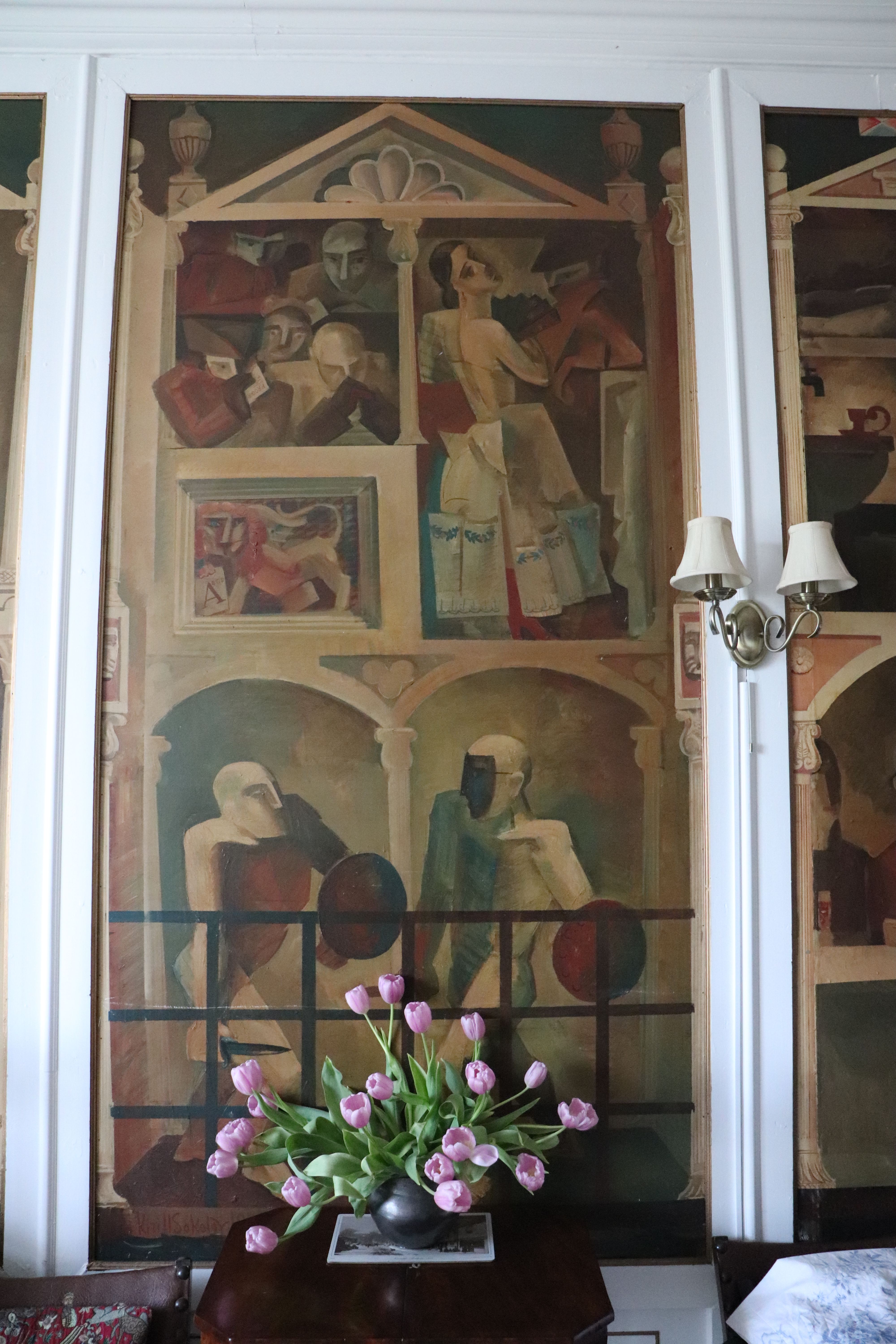
Photograph of wall painting for an exhibition in Hatton Gallery by Kirill Sokolov on the living room wall. Photographed by Siqi Yang.
Photograph of wall painting for an exhibition in Hatton Gallery by Kirill Sokolov on the living room wall. Photographed by Siqi Yang.
Why the cock crows three times? - A Russian folk tale
Avril Sokolov and Irina Sokolov talk about Kirill's paintings in their home.
If you want to see the full interview with the Sokolov family, please go to Explore Further...

Birch tray decorated with patterns. From Sokolov Collection DUROM.2015.15
What is Russian Folk Art?
Folk art is defined as arts and crafts made by people to be used daily. The artists are usually unknown, and wares need to be affordable and useful. Examples include birch wood containers, lacquer spoons and clay whistles.
Russian folk art was created in villages. By 1890, around 7.5 million villagers in Russia worked in craft industries from their homes.
Families made folk art in line with the agricultural cycle. Families made crafts during the winter when the land could not be worked.
Alongside making folk art in the home, many of the pieces were used in the household. A lot of Russian folk art appears in household utensils for storing, preparing and serving food. Each village had a different style, creating distinctive household items.
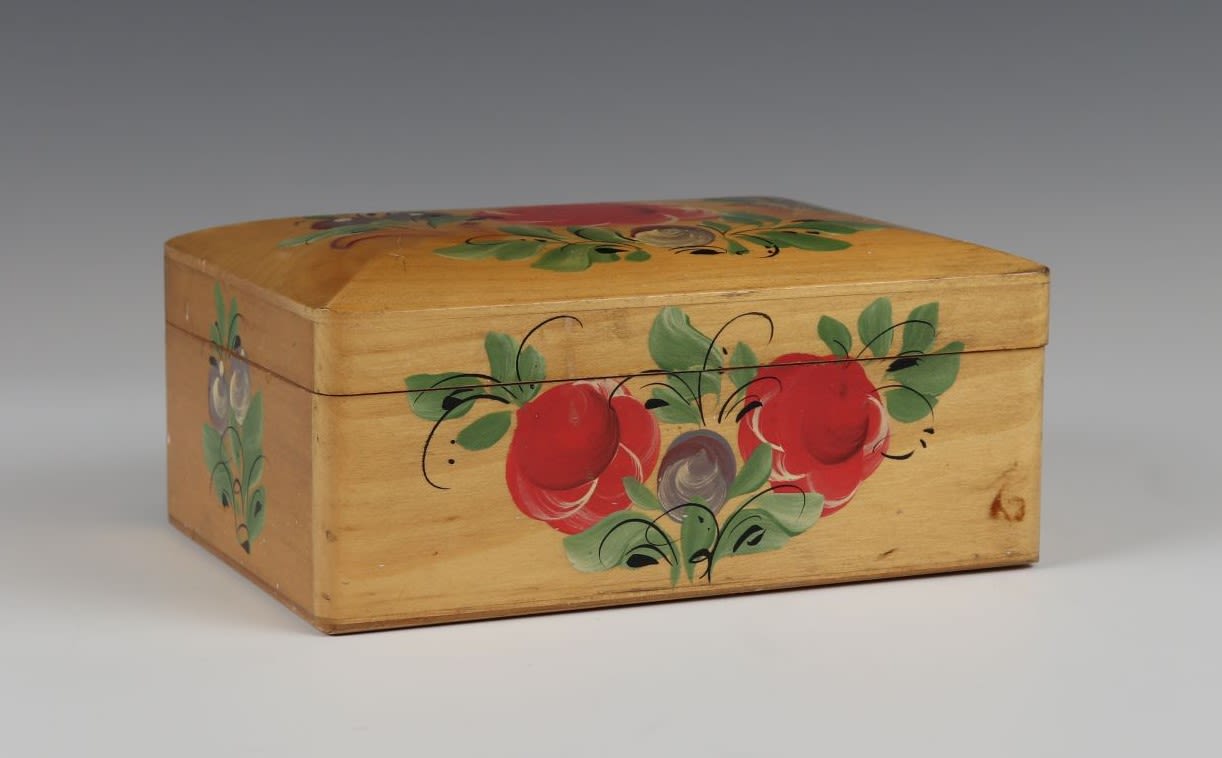
Wooden sewing box with Russian folk art designs. From Sokolov family.
This collection includes Russian folk art made in Western Russia, with skills and styles passed down through generations.
The Russian folk art from the Sokolov Collection is useful, affordable and beautiful. Like these examples.
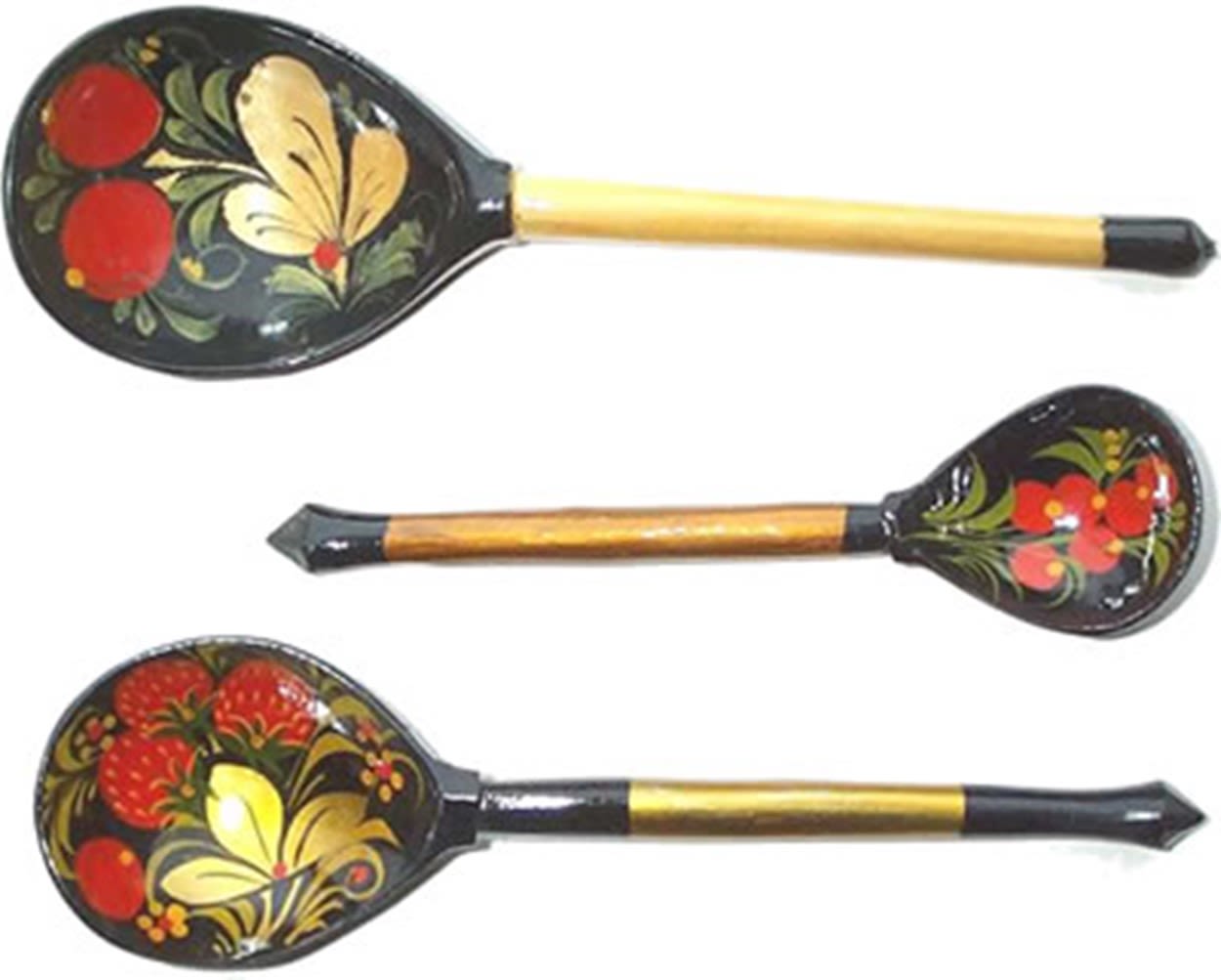
Wooden and lacquered household utensils. From Wikimedia Commons
These wooden and lacquered household utensils were commonly decorated with geometric motifs, flowers and fruit inspired by the surrounding landscape. Families painted designs passed down through the generations and added new patterns to these household objects.
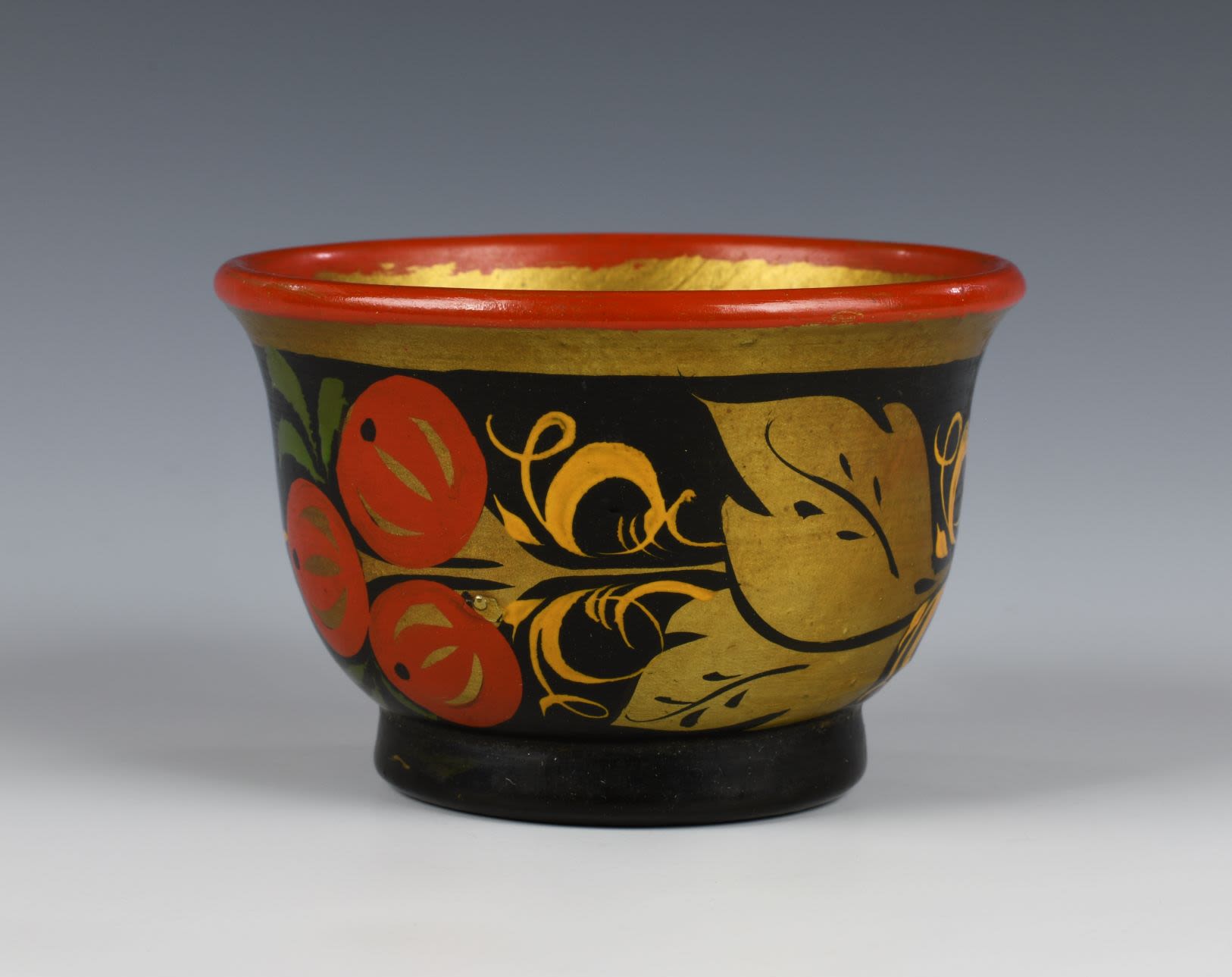
Wooden and lacquered bowl decorated with leaves and fruit. From Sokolov Collection DUROM.2015.8.

Birch tray decorated with patterns. From Sokolov Collection DUROM.2015.15
Birch tray decorated with patterns. From Sokolov Collection DUROM.2015.15

Wooden sewing box with Russian folk art designs. From Sokolov family.
Wooden sewing box with Russian folk art designs. From Sokolov family.

Wooden and lacquered household utensils. From Wikimedia Commons
Wooden and lacquered household utensils. From Wikimedia Commons

Wooden and lacquered bowl decorated with leaves and fruit. From Sokolov Collection DUROM.2015.8.
Wooden and lacquered bowl decorated with leaves and fruit. From Sokolov Collection DUROM.2015.8.
Russian folk art in context
'Folk art embodies both the creative experience of individual artists and the traditions and values held by their communities'
Russian folk art is generational, as its traditional designs and skillful craft were constantly inherited and reshaped by families. Community is a key component of Russian folk art, with crafts reflecting shared ideas on which decoration best coincides with the function of household objects.
Russian folk art began with Russian villages and their families making folk art during the winter when they could not farm. Villagers, artisans and traders exchanged art, wares and influences, sharing motifs across the many regions.
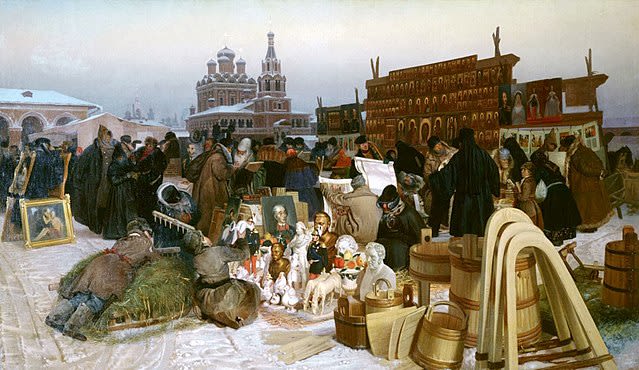
Painting of a traditional Russian fair in the 1800s. At this time fairs selling folk art and goods were the mainstay of the rural economy. Notice the Russian icons for sale. From Wikimedia Commons.
Russian people maintained a range of beliefs and practices, combining Orthodox Christian practice alongside beliefs in the forces of nature and folk customs, tales and traditions.
The Russian Empire, under the Tsars, promoted a universal Russian identity, celebrated by the culture of the time, uniting the different ethnic groups and indigenous peoples of Russia. Under the Tsars, there was an increase in nationalist sentiment and official economic support of Russian folk art and village industries.

Photo of Russian villagers in traditional clothing, 1900-1920. Notice the sticks on which flax or wool is wound for spinning called a distaff. From Wikimedia Commons.
This photograph is a depiction of traditional Russian way of life. Although the photograph is posed, it is useful in showing aspects of Russian folk art including their clothing, the furnishing around them and their distaffs.
Household crafts including textiles, utensils, and wooden tools and toys continued to be made by villagers in the late nineteenth century. They combined established Russian folk art designs with individual artistic expression.
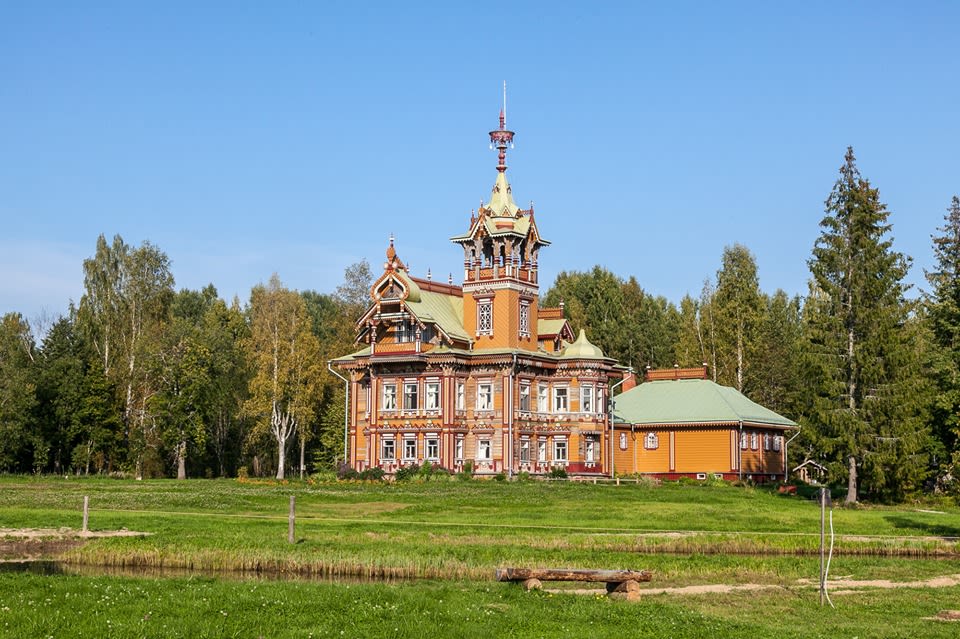
The Abramtsevo Estate, built on the outskirts of Moscow in 1876. The estate became a centre for artists interested in producing traditional Russian folk art. From Wikimedia Commons.
The Abramtsevo Estate
The value of Russian folk art for communities and as a creative experience is demonstrated by the revival of Russian folk art in the late 1860s-1870s.
A prominent site for the revival of Russian Folk Art was the Abramtsevo estate, which was built on the outskirts of Moscow in 1876. Established by entrepreneur Savva Mamontov and his philanthropist wife, Elizabeth Mamontov, the Abramtsevo estate became a centre for artists interested in producing traditional Russian folk art.
Elena Polenova
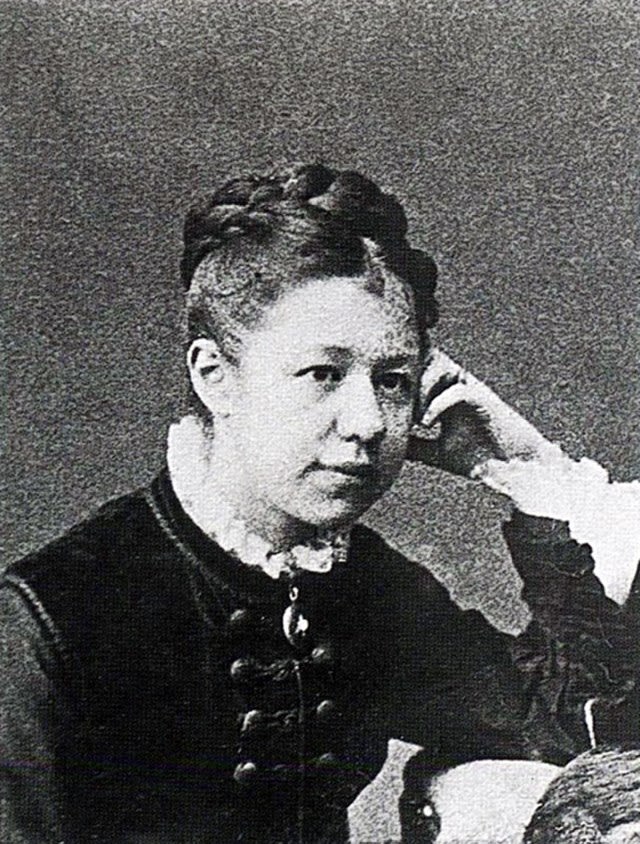
Elana Polenova was an important figure in the revival of Russian folk art in the late 1800s. From Wikimedia Commons.
Elana Polenova was an important figure in the revival of Russian folk art in the late 1800s. From Wikimedia Commons.
An important figure in the revival of Russian Folk Art during the late 1800s was painter and furniture designer, Elena Polenova. Polenova created over a hundred furniture designs, including wooden cabinets and chairs. These were inspired by the lives of local villagers alongside the natural environment, including flora and fauna.

Birch wall cabinet made by artist Elena Polenova around the 1880s. © Victoria and Albert Museum, London.
In 1885, Polenova was made director of the carpentry workshop in Abramtsevo. Under her leadership, villagers made her furniture which was sold to boutiques in Moscow.
Russian folk art, the Russian Revolution and its place in the Soviet Union
In 1917, the Russian Revolution saw the villagers and workers of Russia rise up against Tsar Nicholas II and his Empire due to lack of food.
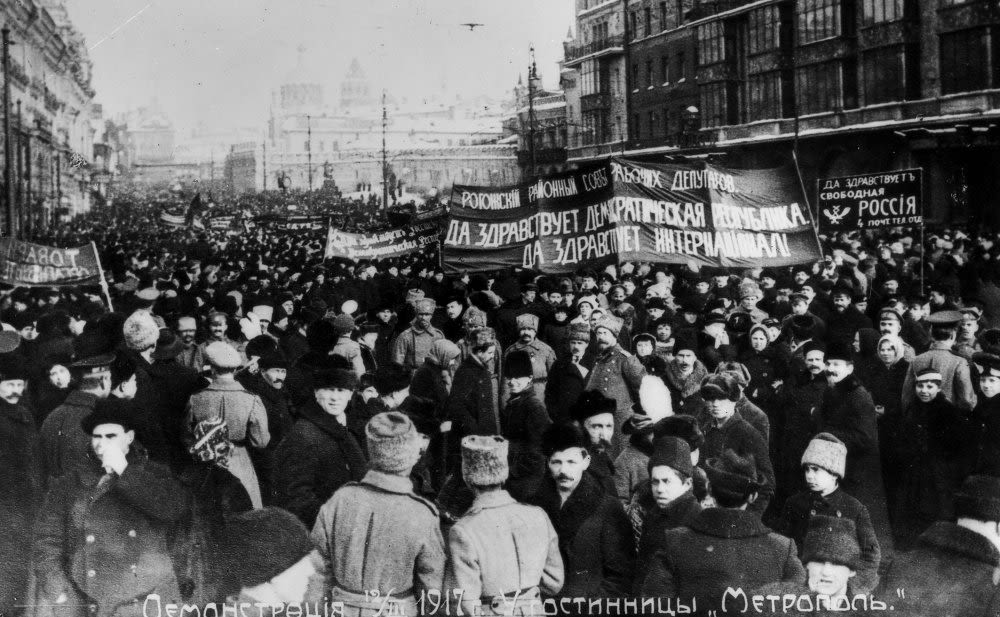
Photograph of the Russian Revolution taken in 1917. From Wikimedia Commons.
Photograph of the Russian Revolution taken in 1917. From Wikimedia Commons.
'Folk art proved vital to Soviet culture in ways that earlier generations of artists never imagined.'

Poster by Vladimir Lebedev, ROSTA, 1920. From Alison Hilton, Russian Folk Art (1995).
Following this chaotic period, the USSR formed in 1922 under the Communist Party. During the Soviet Union, folk art was used to promote Communist ideas. For example, aspects of Russian folk art including its distinctive floral designs, were incorporated into Communist propaganda advertising trains and steamboats to villagers. By using Russian folk art traditionally made by villagers, the state could promote Communism to rural villagers less familiar with this political ideology.
Before the revolution, around 100 schools taught folk art to villagers between 1902-1910. However, during the Soviet Period, schools teaching traditional Russian folk art became widespread through the regions of the USSR. Between 1917-1930, around 40,000 people were involved in projects creating Russian folk art.
The strong community ties prevalent in folk art also coincided with the Communist ideology that art should be for everyone in Russia. In 1918, free art schools and studios were provided for village residents and workers to develop their artistic skills through creating traditional Russian folk art.
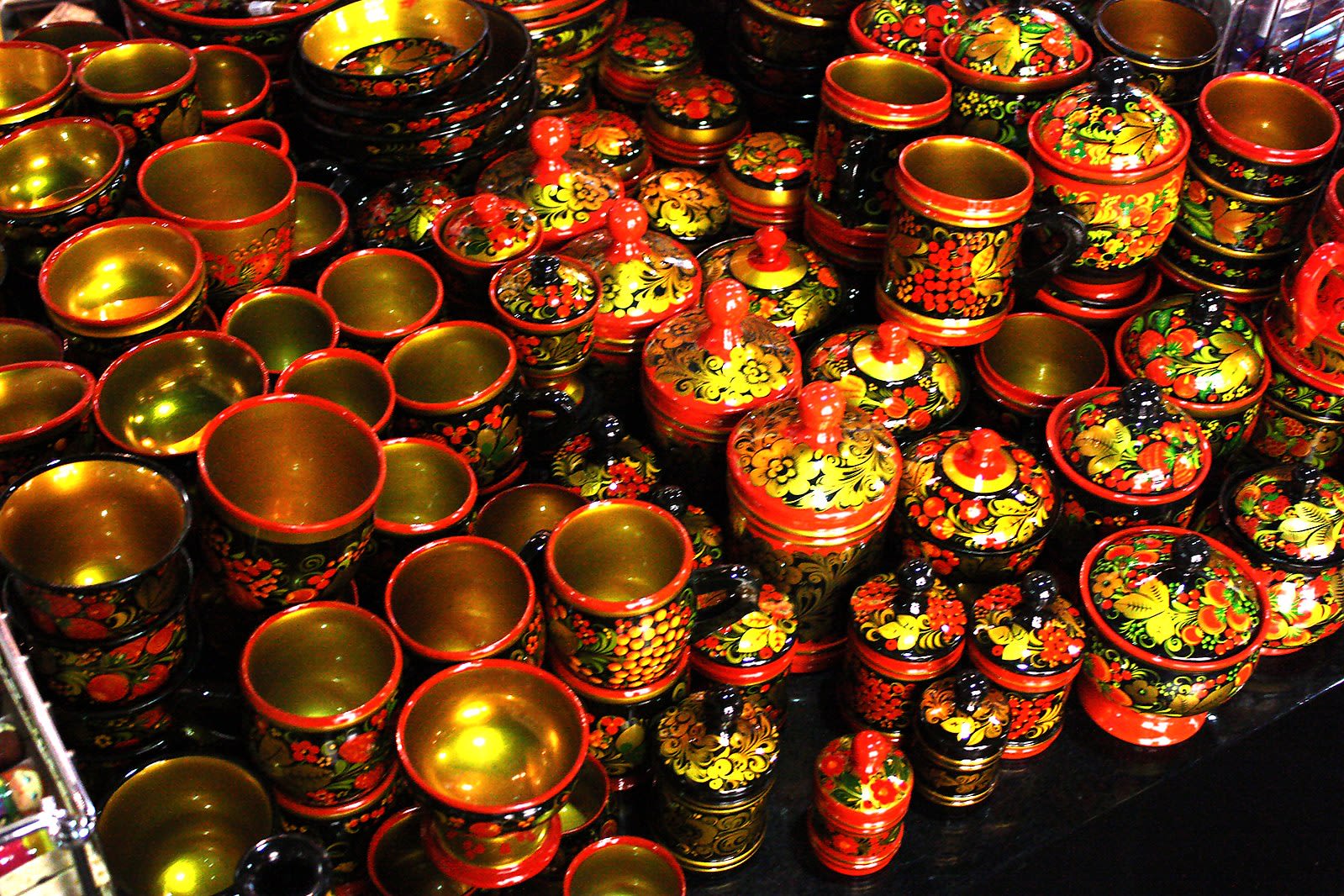
Khokhloma containers photographed by Politikaner. From Wikimeida Commons.
During the 1920-30s, craftspeople established cooperatives and workshops making Khokhloma crafts. However, it was not until the 1960s that Khokhloma crafts were produced on an industrial scale, with the building of a factory in Khokhloma and Semenov. These factories produced a variety of tableware items and utensils to sell to the growing tourist markets in Russia.
According to historians Vladmir Tatlin and Alexander Rodchenko, 'The artist was essentially in the service of proletarian society, that his art must not only be beautiful but useful.'
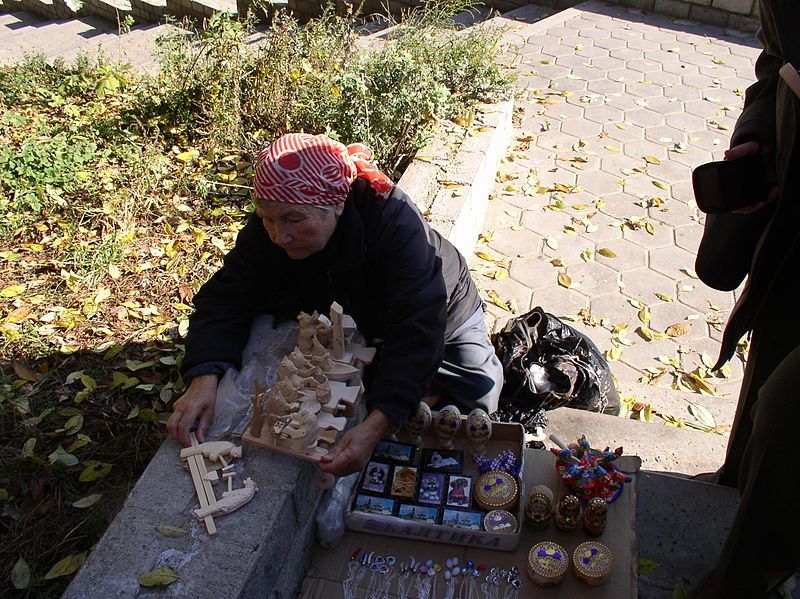
Photograph of Sergiev Posad, a toy merchant, selling Bogorodskoe toys. Form Wikimedia Commons.
The Bogorodskoe cooperative was established for creating wooden folk art. Workshops which specialised in making traditional Russian folk art, including the Zhostovo pattern, also flourished throughout the twentieth century. These Russian folk art workshops produced a variety of tableware items and utensils to sell to the growing tourist markets in Russia.
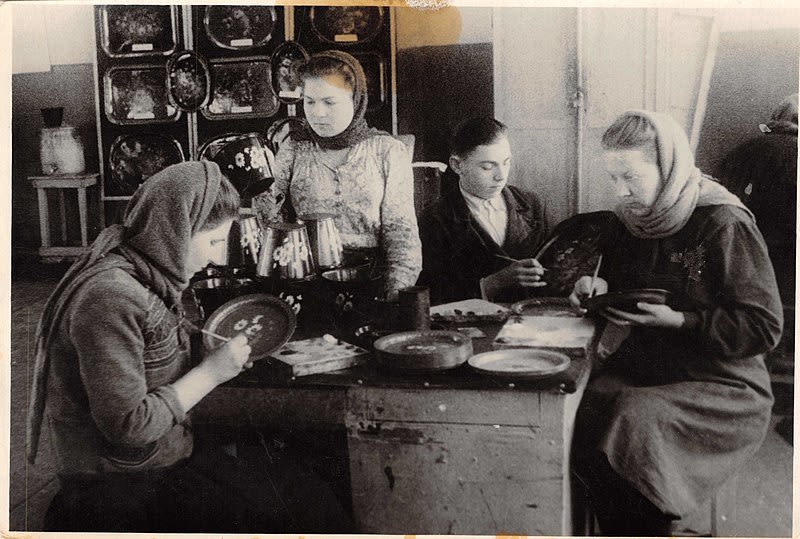
Photograph of workshop in Russia making Zhostovo trays. From Wikimedia Commons.
Photograph of workshop in Russia making Zhostovo trays. From Wikimedia Commons.
Rather than just engaging villagers in producing Russian folk art, Russian folk art continued to be a source of income for the working population of Russia. Importantly, the increasing adoption of established Russian folk art crafts was a way to construct an idea of national identity in Russia whilst creating a new social order under the Soviet Union.
Objects from the Sokolov Collection created during the Soviet era include a Balkhar jug (DUROM.2015.97) and a Dymkovo cow (DUROM.2015.45)

Photograph of Maslenitsa festival, St Petersburg, February 2018. From Wikimedia Commons.
By the 1980s, Russia experienced Perestroika ('restructuring' in Russian), designed to improve the economy and change the political structure. For the people of Russia, festivals such as Maslenitsa were now celebrated officially as the age of religious censorship was slowly overthrown. Many Russians returned to openly practising Christianity.
In 1991 the Russian Federation was established, allowing western influences and bringing an end to censorship and religious restrictions. Objects from the Sokolov Collection created after the Soviet era include a Fedoseyevo toy (DUROM.2015.49) and a mechanical Bogorodskoe toy (DUROM.2015.50)
Russians are proud to share their cultural heritage which has survived the conquering Russian Empire, the influential Soviet Union and the contracted Russian Federation. In the post-Soviet era, the tourist market expanded to help Russians keep unique and valuable monuments of Russian culture and history.
Russian folk art continues to be made by villagers. These folk art skills continue to be celebrated today, such as with Zhostovo trays.
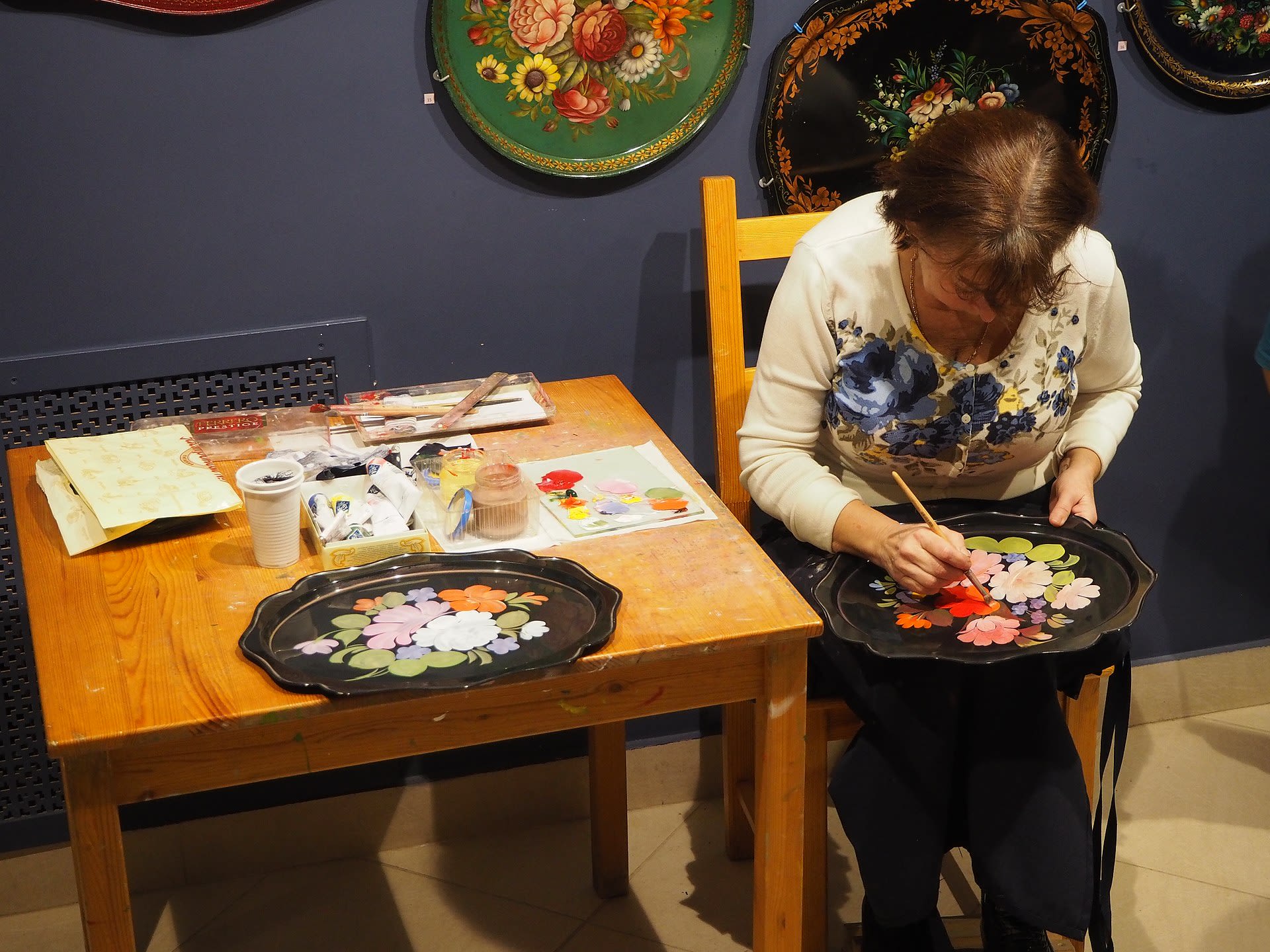
Photograph of modern Zhostovo tray. From Wikimedia Commons.
Photograph of modern Zhostovo tray. From Wikimedia Commons.
Kirill Sokolov's legacy is to share his Russian cultural heritage through his work and folk art collection.

Painting of a traditional Russian fair in the 1800s. At this time fairs selling folk art and goods were the mainstay of the rural economy. Notice the Russian icons for sale. From Wikimedia Commons.
Painting of a traditional Russian fair in the 1800s. At this time fairs selling folk art and goods were the mainstay of the rural economy. Notice the Russian icons for sale. From Wikimedia Commons.

Photo of Russian villagers in traditional clothing, 1900-1920. Notice the sticks on which flax or wool is wound for spinning called a distaff. From Wikimedia Commons.
Photo of Russian villagers in traditional clothing, 1900-1920. Notice the sticks on which flax or wool is wound for spinning called a distaff. From Wikimedia Commons.

The Abramtsevo Estate, built on the outskirts of Moscow in 1876. The estate became a centre for artists interested in producing traditional Russian folk art. From Wikimedia Commons.
The Abramtsevo Estate, built on the outskirts of Moscow in 1876. The estate became a centre for artists interested in producing traditional Russian folk art. From Wikimedia Commons.

Birch wall cabinet made by artist Elena Polenova around the 1880s. © Victoria and Albert Museum, London.
Birch wall cabinet made by artist Elena Polenova around the 1880s. © Victoria and Albert Museum, London.

Poster by Vladimir Lebedev, ROSTA, 1920. From Alison Hilton, Russian Folk Art (1995).
Poster by Vladimir Lebedev, ROSTA, 1920. From Alison Hilton, Russian Folk Art (1995).

Khokhloma containers photographed by Politikaner. From Wikimeida Commons.
Khokhloma containers photographed by Politikaner. From Wikimeida Commons.

Photograph of Sergiev Posad, a toy merchant, selling Bogorodskoe toys. Form Wikimedia Commons.
Photograph of Sergiev Posad, a toy merchant, selling Bogorodskoe toys. Form Wikimedia Commons.

Photograph of Maslenitsa festival, St Petersburg, February 2018. From Wikimedia Commons.
Photograph of Maslenitsa festival, St Petersburg, February 2018. From Wikimedia Commons.
Click at the bottom right to explore full-screen
This map of Russia shows the oblasts or geographical areas in which the folk art is traditionally created.
Russian folk art from the Sokolov Collection has been created in the west of Russia, taking influences from local materials, traditional skills and folk tales.
''Folk art belongs to communities rather than to individuals, and to many generations rather than to one period.''
Khokhloma folk art, produced in Nizhny Novgorod oblast, had its origins in the 1600s.
Khokhloma folk art is known for painting wood in vivid floral patterns with gold, red and black including berries, fruits, herbs and birds. The gold colour is achieved by heating aluminium to transform its colour and make it withstand heat and frost.
See examples from the Sokolov Collection
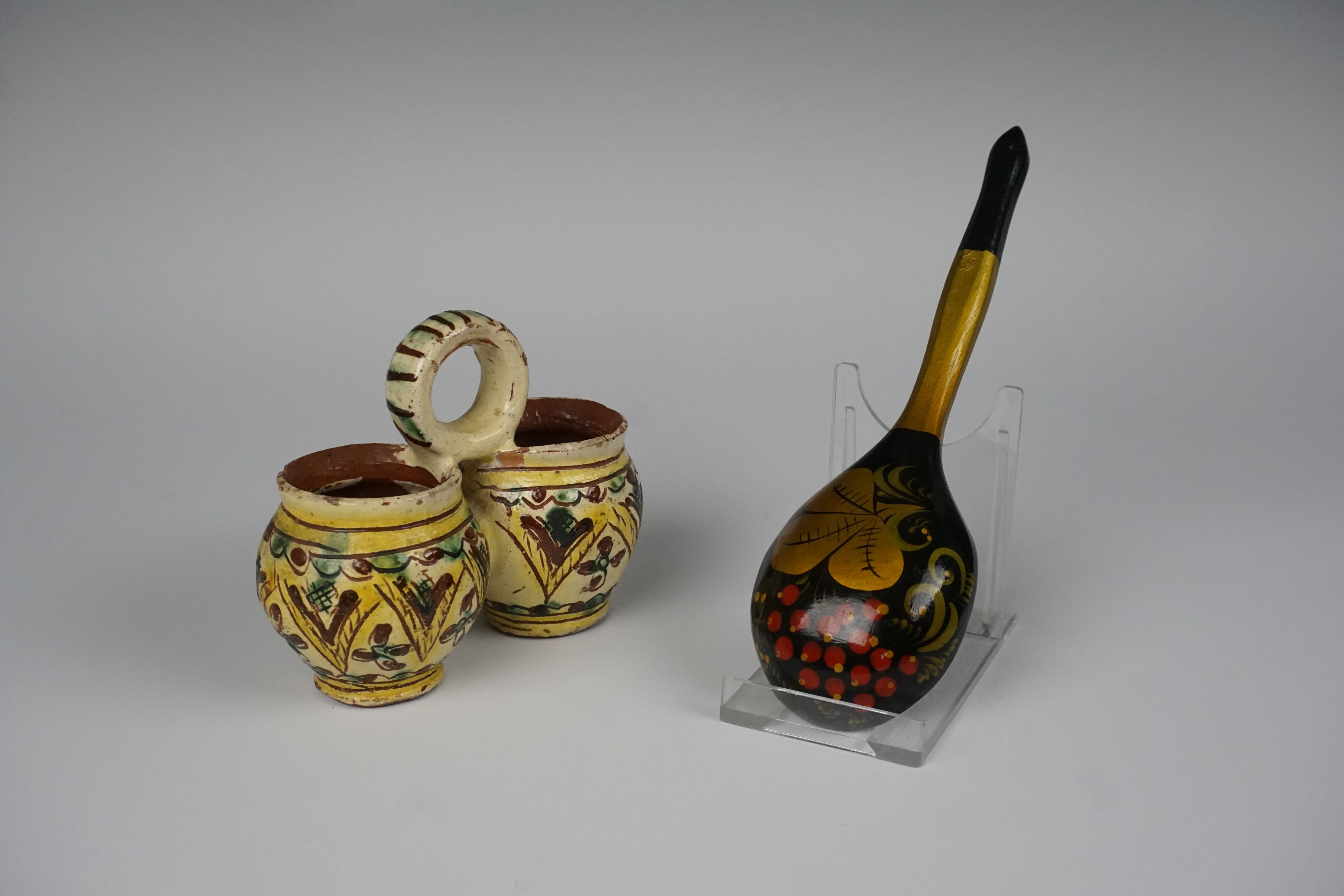
DUROM.2015.21 and DUROM.2015.3
DUROM.2015.21 and DUROM.2015.3
On the left is a salt cellar, two small jars connected with a round handle. Both jars have decorations of wavy patterns which include flowers, leaves, stripes and geometric figures painted under the glaze in green, yellow and brown on a yellow background. The handle has a pattern of green and brown stripes. The interior of the jars is glazed in brown.
A lacquer spoon is on the right with a rounded, highly decorated bowl. It includes rowan berries and 'gold' paint, made from heated aluminium.
Dymkovo folk art was made in Kirov oblast from the 1600s onwards.
Clay toys are famously produced there, sometimes in the form of whistles. The toys include figures of people, animals, or imagined creatures. They are moulded from clay, covered in chalk mixed with milk and painted with a gauche mixed with egg. Supported through the Soviet regime, the art continues even today with new generations of master crafters, predominately women.
See examples from the Sokolov Collection.
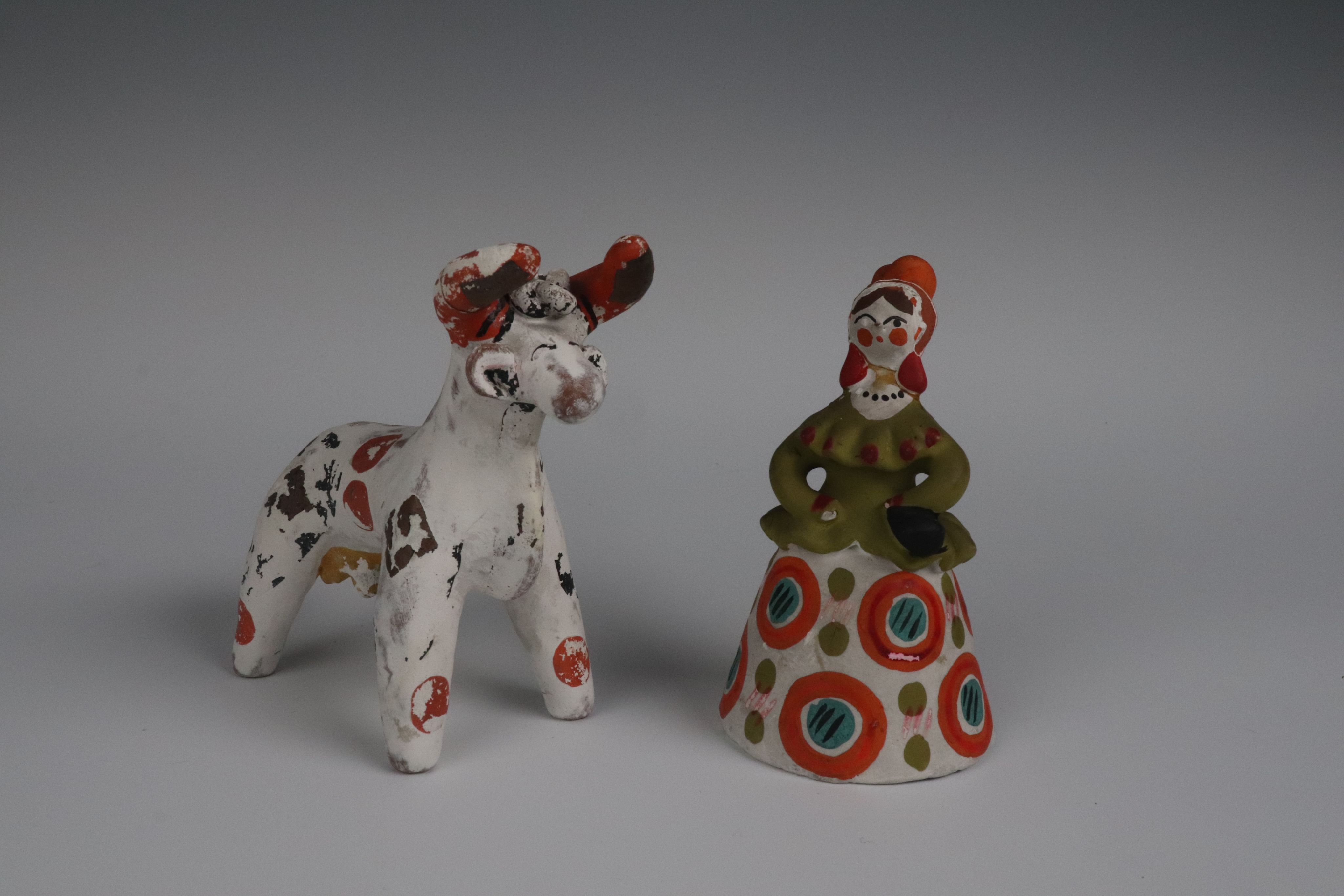
DUROM.2015.45 and DUROM.2015.29
This colourful cow has a proportional body with a long neck and pointed orange horns. The figure is painted in white with patterns of orange circles and black shapes. It is traditionally decorated with now worn square patches of gilt on both horns and four legs. A white paper sticker with a Russian inscription indicates the toy was made in the period 1917 - 1993 in the city of Kirov.
This highly detailed lady wears a green jacket, earrings and a wide hoop skirt decorated with circle and dot patterns. The face features eyebrows, dot-shaped eyes painted in black, a mouth and rounded cheeks painted in orange and brown hair. The interior of the figure is not painted where there is an inscription in Russian 'BARANOVA. G' (БАРАНОВА. Г.), probably indicating the name of the artist.
Fedoseyevo Russian folk art, from the 1800s-1900s, is created in Nizhny Novgorod oblast.
The figures are often created using just an axe and knife, they are simple but well-constructed.
See examples from the Sokolov Collection.
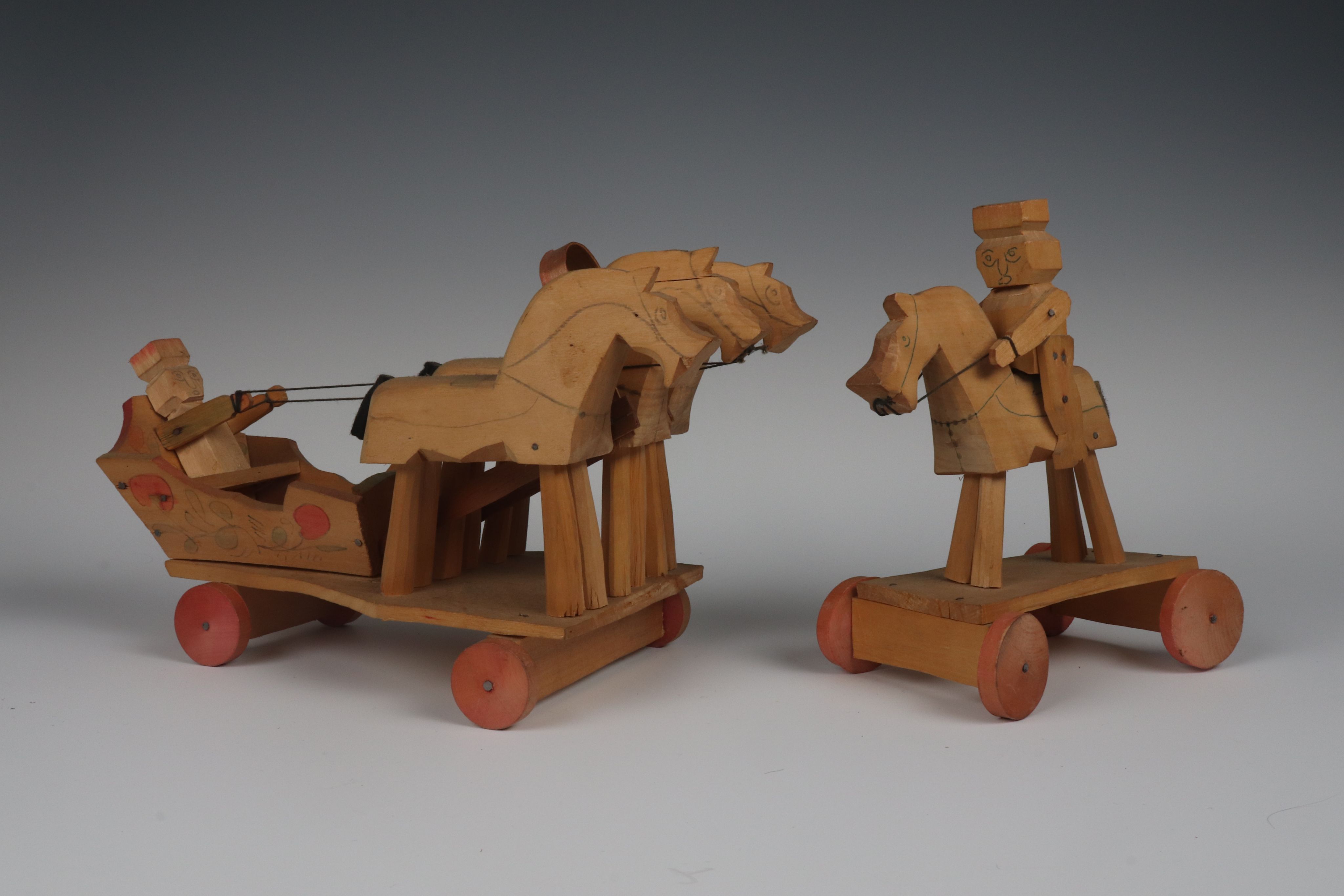
DUROM.2015.48 and DUROM.2015.47
This troika (Russian: тро́йка), on the left, is a traditional Russian sledge drawn by three horses. The rider is carved from wood with three sections for the hat, head, and body but no legs, and is seated on a board. The toy is unpainted except for the driver's face painted in black and the sledge decoration of green leaves and red flowers. It is fastened together with nails.
On the right is a rider and his horse. The rider is made of three sections for hat, head and body with flat arms and legs in his hands he is holding reins. The figures are left unpainted only with rider's face features, horse's eyes and tack drawn with a blue pen.
Balkhar folk art was created in Kabardino-Balkarian, currently an autonomous oblast.
This Balkhar folk art often includes brown coloured clay, from the area, with white geometric decorations on the surface.
See examples from the Sokolov Collection.
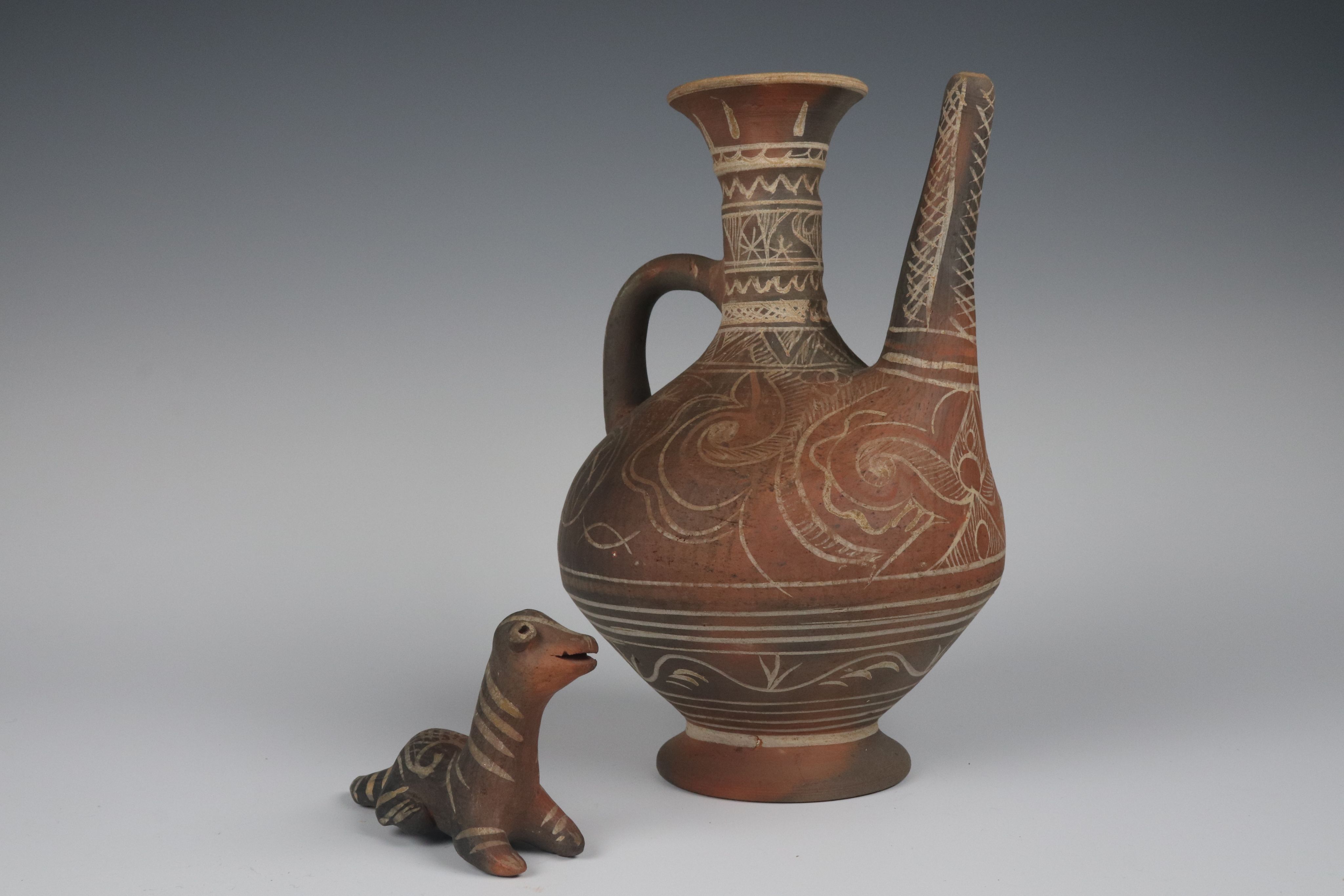
DUROM.2015.96 and DUROM.2015.98
This fantastic creature, on the left, is a bit like a dinosaur. The creature has a narrowing tail like a lizard, a long neck, and small head with an opened muzzle and two protruding round eyes. The toy is left unpainted. The light and the dark brown surface of the clay is decorated with a mixture of floral and geometrical ornaments in white.
On the right is a jug is called a kyunari used for washing and for drinking water. The jug is decorated with traditional Balkhar embellishments in white, some are linear while the upper body comprises a mixture of floral and geometrical like patterns.
Kargopol folk art, one of the oldest forms of folk art developed in the 1800s, was created in Arkangelsk oblast.
Kargopol toys are usually moulded in quite a rough manner from clay, with flat faces and generalized details and clothing, reminiscent of ancient stone sculptures.
See examples from the Sokolov Collection.
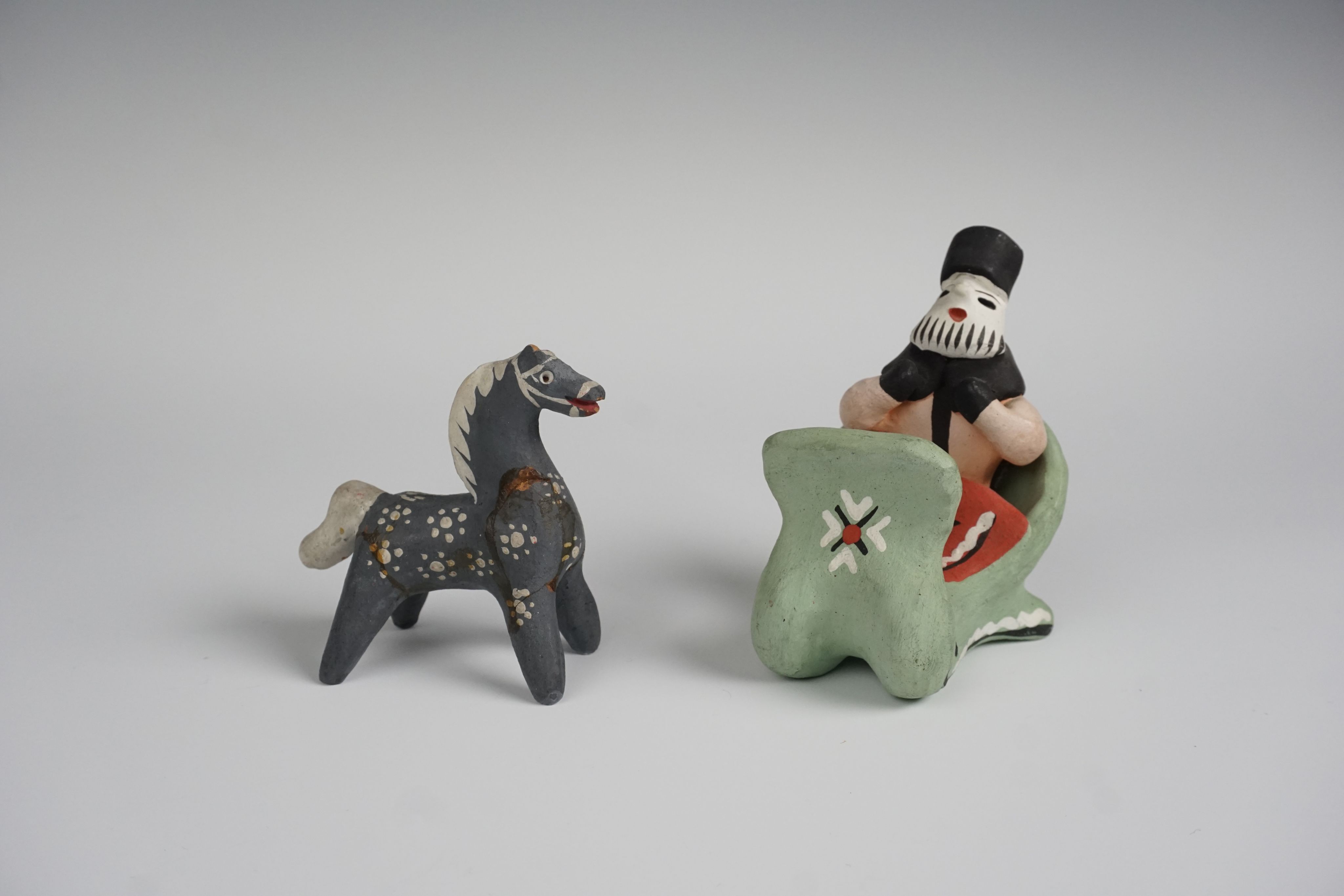
DUROM.2015.39 and DUROM.2015.55
This figure of a man on the right has a traditional broad beard called muzhichok. Red clay is used to sculpt these simple forms, with a flat face and beard, details of his coat and hat added in paint.
On the left, a horse stands on four legs with a long neck and broad tail. It is painted grey and decorated with patterns of circles, with highlights of red inside the mouth and on the ears.
Zhostovo folk art, begun in the early 1800s, is created in Moscow oblast.
This is a traditional type of Russian folk art with detailed hand painting on metal trays.
See the example from the Sokolov Collection
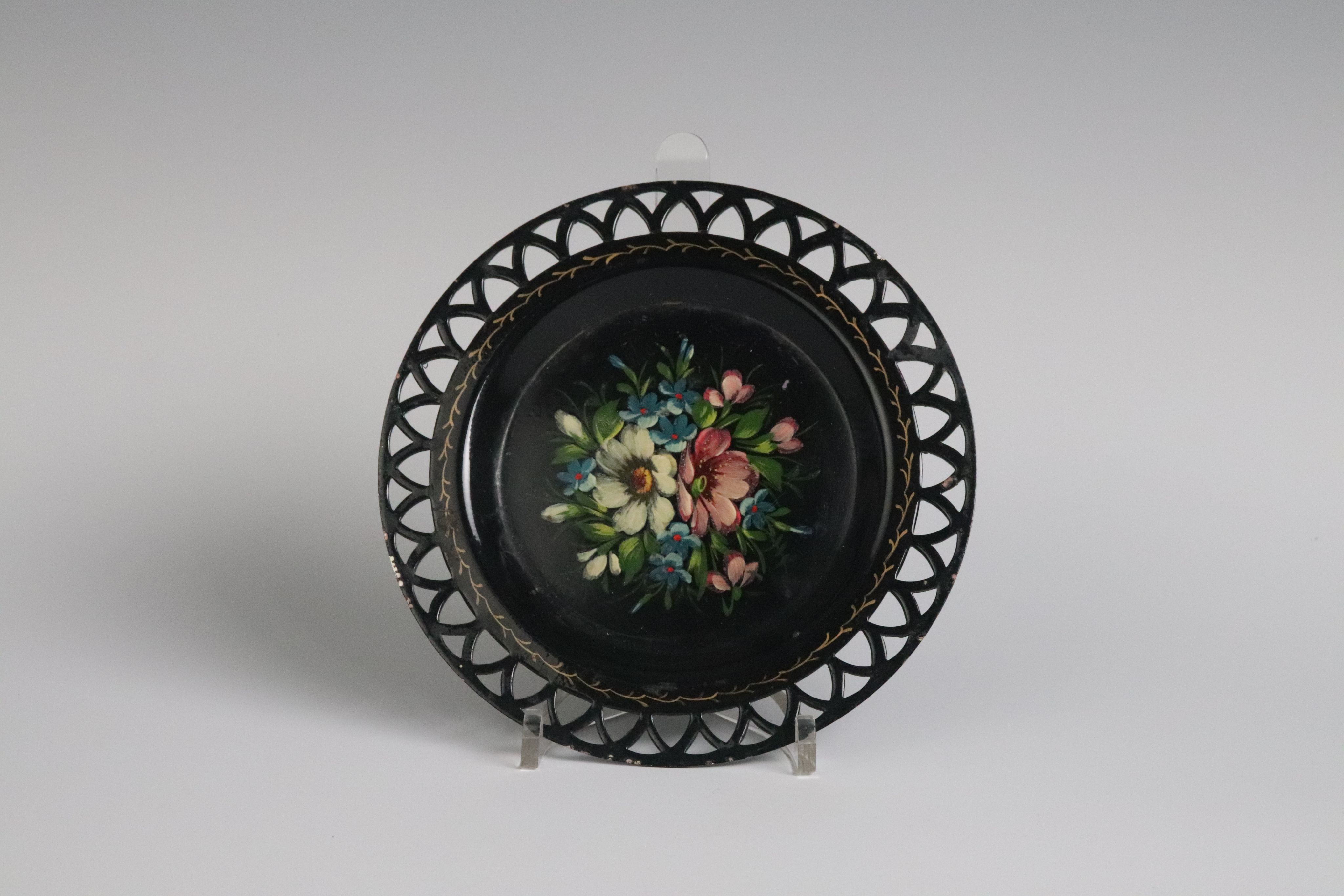
DUROM.2015.14
This circular black lacquer tray with an openwork rim and gold twig-like pattern is decorated with a bouquet of flowers in rich vivid colours of blue, white, red, yellow and pink with green leaves. This is the most widely used motif of the Zhostovo painting. The tray is painted in the traditional manner without using stencils or outlines.
Abashevo folk art made in 1900s is created in Penza (Penzenskaya) oblast.
The figurines from the region have elongated trunks with short legs set wide apart, and long, graceful necks. A dark-green glaze is characteristic of the style. Some details, for example, horns, can be painted in silver or gold.
See examples from the Sokolov Collection
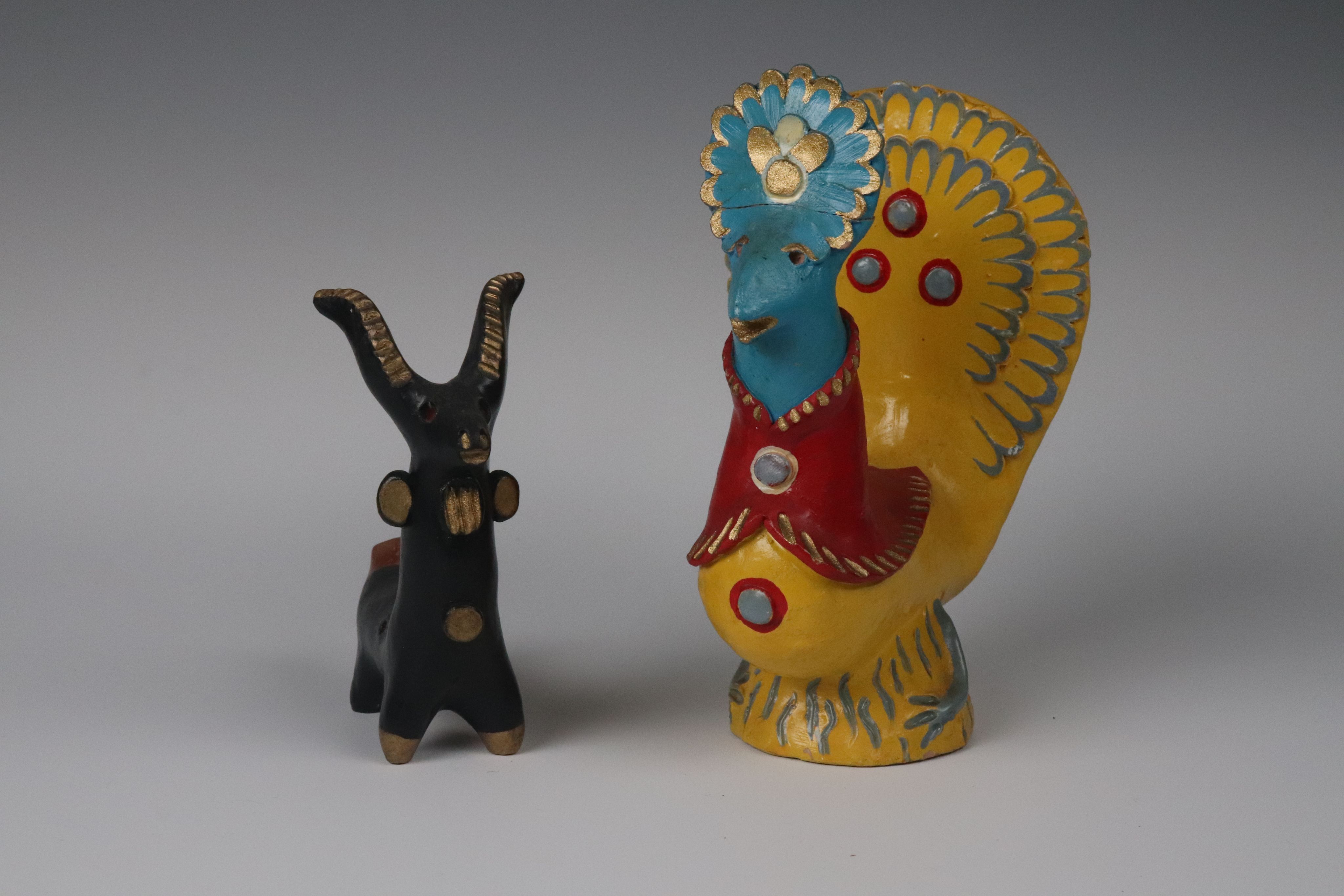
DUROM.2015.75 and DUROM.2015.41
On the left is a goat shaped whistle with long horns, painted black with gold highlights. This toy in the Abashevo style is elegant and detailed with gold.
On the right is an Abashevo toy shaped as a cockerel with a broad and flat displayed tail, and a crown-like blue crest. The cockerel with a peacock tail is highly decorated with gold and silver wavy lines, clawed feet and round grey ornaments.
Birch Bark folk art dates to the early 1800s and is created in Vologda Oblast.
Villagers use birch bark to create toys, building houses, utensils, baskets, and containers, flexible but strong material. The Russian landscape is abundant with birch trees. Russian homes traditionally hold examples of birch bark work.
Birch riddle: ‘As I walked in the forest, I found a tree. This tree has 3 special powers: it lights, cures and cleans.’ (Gilchrist, C. 'Russian Magic-Living Folk Traditions of an Enchanted Landscape')
See examples from the Sokolov Collection
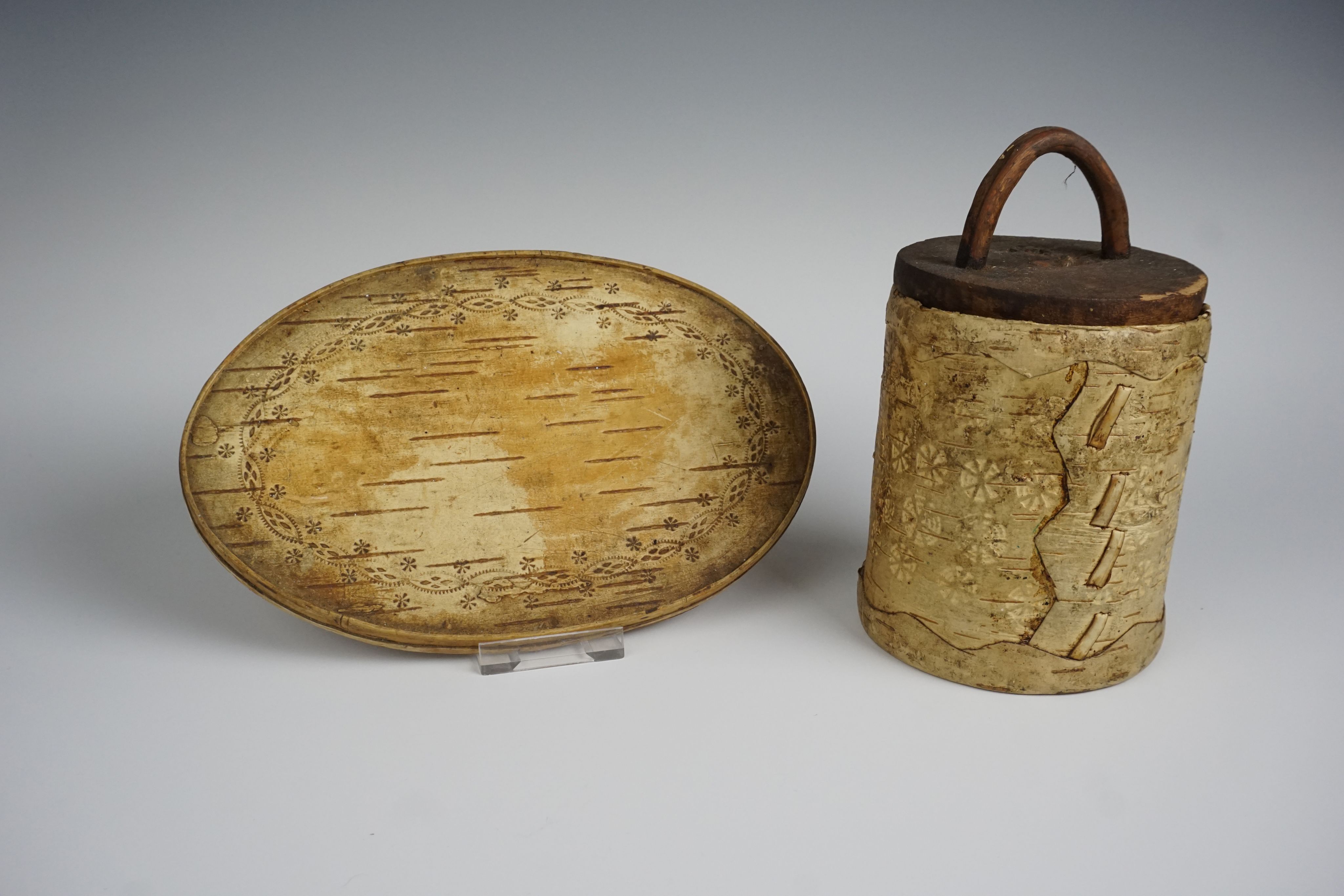
DUROM.2015.15 and DUROM.2015.17
The oval tray on the left has three feet on the back. It is decorated with a garland and geometrical patterns.
On the right is a cylindrical container called tuesok or tues in Russian. It was made by rolling up the birch bark, which is then sewn together using four wide stitches. The wavy edge of the birch can be seen. The exterior is decorated with a round pattern made of embossed triangles. The flat lid is made of solid wood with a semi-circular handle attached.
Zhbannikov folk art from the 1900s is created in the Nizhny Novgorod oblast.
Craftsmen Makar Andreevich Velov (Russian: Макар Андреевич Велов) and Vasiliy Efimovich Dudkin (Russian: Василий Ефимович Дудкин) greatly contributed to the development of Zhbannikov toys, moulding whistles of riders on horses and other characters.
See examples from the Sokolov Collection
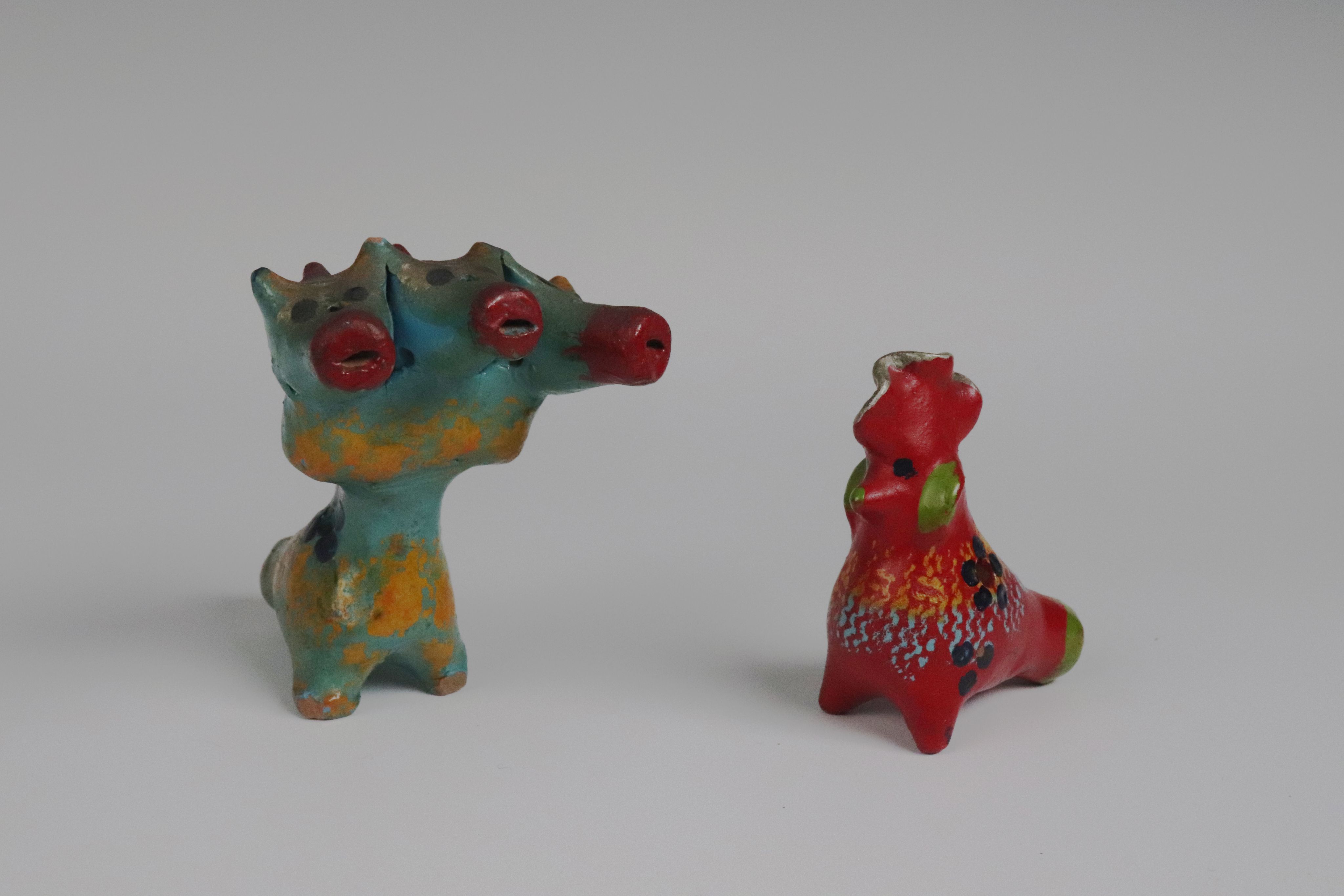
DUROM.2015.33 and DUROM.2015.78
On the left is a traditional Slavic blue dragon which stands on two short front legs; the body is covered with silver dyes. Three heads are shaped on the long tapering neck. Details include small black horns and a red jaw with black rounded eyes and a hole instead of a nose. The back of the dragon is red with six spikes with black tops.
This toy, on the right, looks like a rooster, with lots of stylised details, a small head with a beak, comb and ear lobes decorated with red and green paint. The green tail is shaped as a mouthpiece for the whistle, with two round whistle holes on each side and at the bottom.
Filimonovo folk art, developed in the 1850s, is created in the Tula oblast.
Filimonov toys are quite striking in appearance as they are very original and unusual in form. They have elongated proportions and soft contours, required by the local clay which needs much smoothing to shape without it cracking. This style of folk art is created solely by craftswomen, the skills passed down through the generations.
See examples from the Sokolov Collection
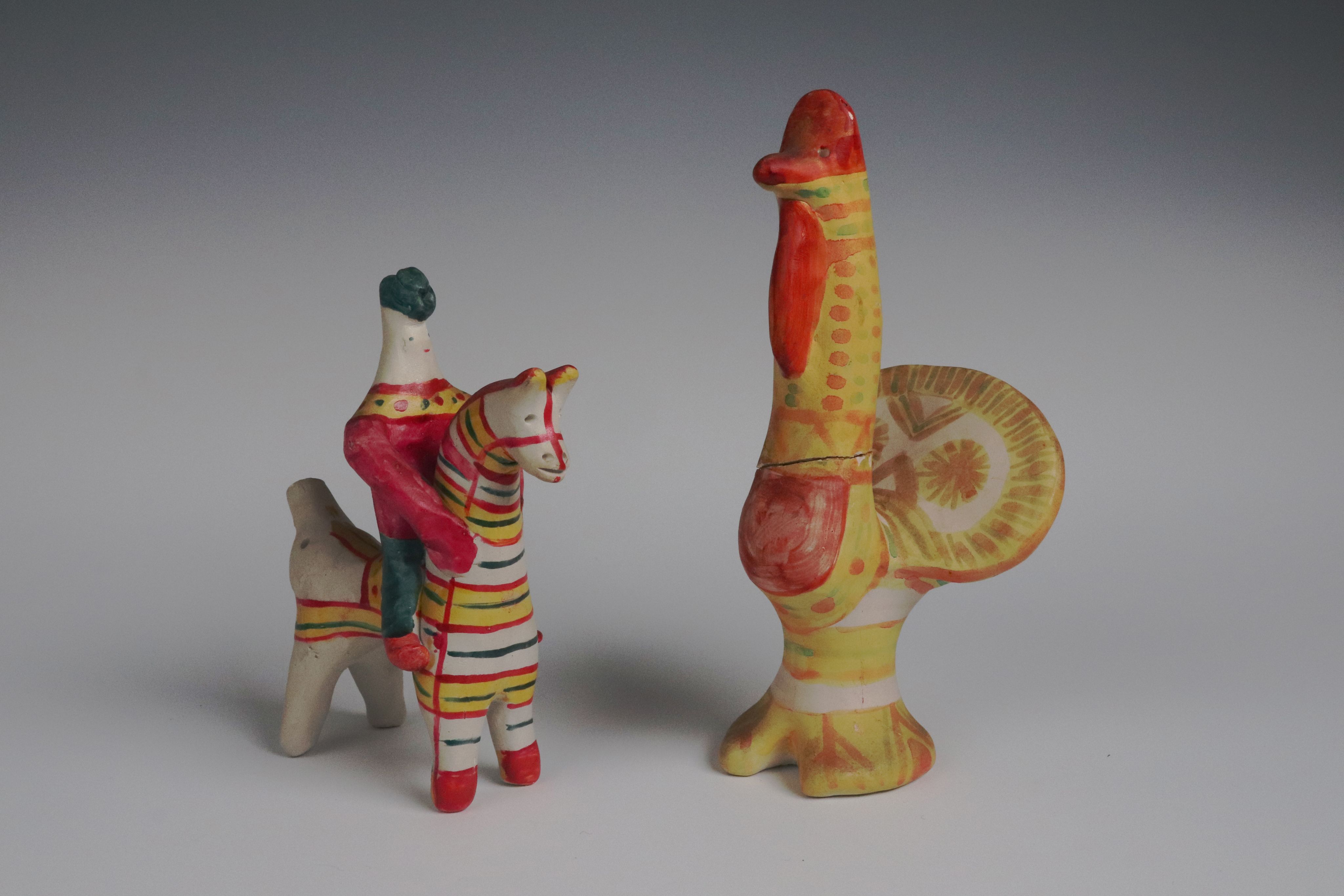
DUROM.2015.57 and DUROM.2015.35
On the left is a clay whistle moulded as a rider on a horse. It has a long neck with a small head, with the rider seated on the back of the horse with short legs and a long body. The man has a green hat and red shirt, and the horse is decorated with horizontal stripes or dots of green, yellow, pink and red.
This turkey whistle, on the right, has a long neck with a small red head and a broad flat tail fan decorated with two symbols of the sun. It is traditionally painted with colourful stripes along the body and neck and decorations of circles, rosettes, triangles, zigzags, and dots.
Romanovo folk art, from the 1800s-1900s, is created in the Lipetck oblast.
Romanovo folk art is used in everyday life for decorative purposes, the objects are to be looked at and enjoyed.
See examples from the Sokolov Collection
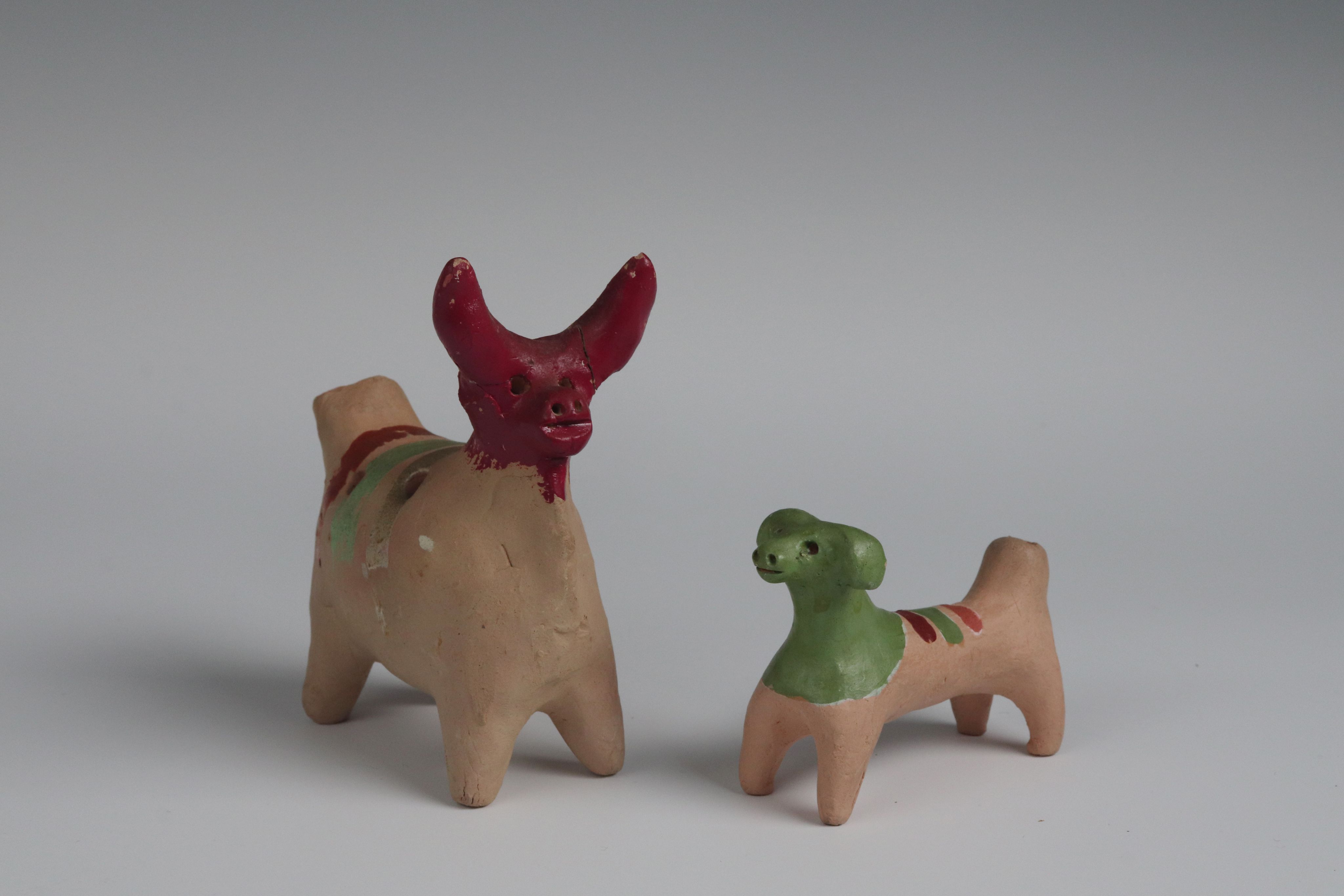
DUROM.2015.84 and DUROM.2015.36
This cow-shaped whistle, on the left, has a large body and four short legs, the tail shaped as a mouthpiece. It has a small head with deeply scratched eyes, shapely horns, and a muzzle. The toy is mostly unpainted except for the head and neck which is coloured dark red, with coloured stripes on the back. The toy is moulded in a rough manner and lacks details.
On the right is a clay whistle which looks like a dog with four long legs and a big, rounded tail, the whistles’ mouthpiece. The toy is mostly unpainted except for stripes on the back, and head and neck which are coloured green. The face with 'v' shaped ears and small details are barely marked.
Bogorodskoe folk art, starting from the 1600s-1700s, is created in the Moscow oblast.
Bogorodskoe folk art started with toys to entertain. Bogorodeskoe carvers have always been distinguished by their neat characteristics and artistic perfection. The art form was supported by the Soviet government as it presented no ideological threat, incorporating folktale and historical themes. They are still produced today in more topical forms.
See examples from the Sokolov Collection
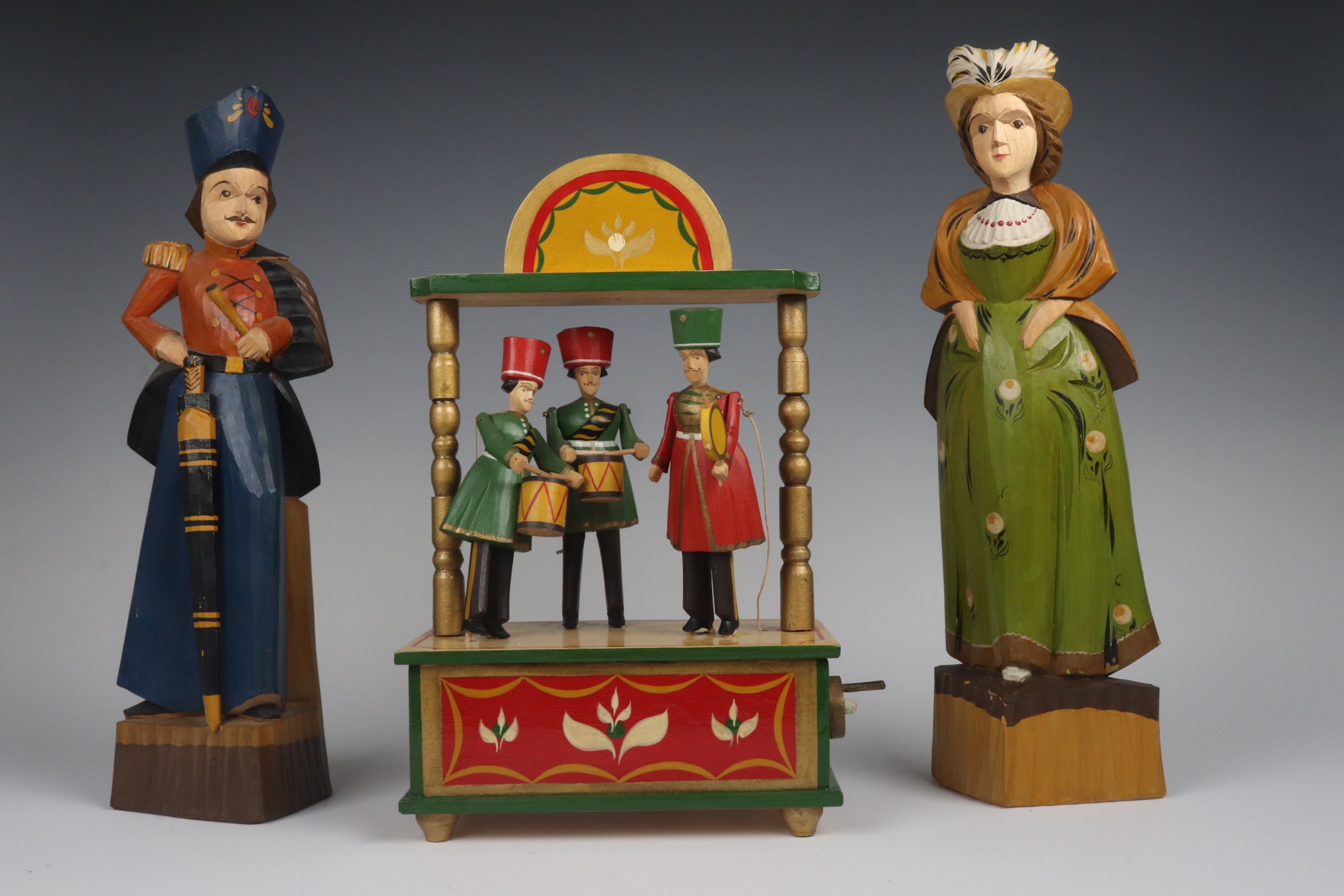
DUROM.2015.51/50/52
In the middle is a mechanical toy with three military officers playing musical instruments, with a hidden mechanism inside. The highly detailed soldiers with instruments, two with drums and drumsticks, the figure on the left in red military uniform is holding a round yellow object, which may be a tamborine.
On either side are carved figures of a Hussar, horseman, on the left and a lady on the right, showing their importance by standing tall and proud. Notice all the detailed decoration in his uniform and the feathers in her hat.
Belyov folk art has been created since the 1600s-1700s in the Tula oblast.
Belyov folk art was revived in the 1900s by I.A. Ivanov, a Russian artist. They are usually decorative and amusing figures in pastel shades.
See examples from the Sokolov Collection
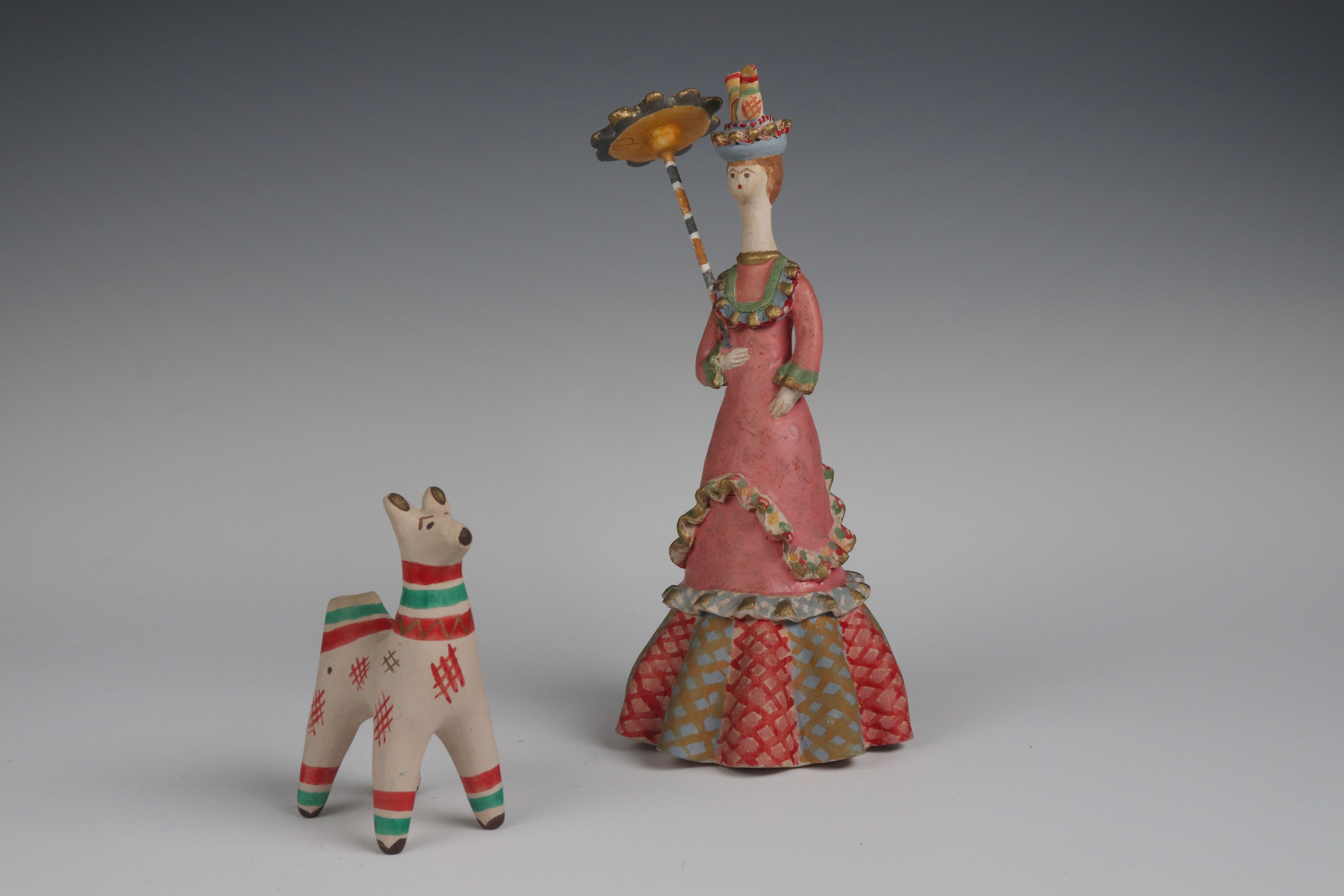
DUROM.2015.66 and DUROM.2015.82
On the left is a moulded clay whistle, which could be a dog, standing on four long legs with a proportional body with a long neck, head and two pointed ears. The wide tail is shaped as a mouthpiece of the whistle. The toy is left unpainted but with colourful decorations of stripes in red, green, and red on the neck, legs and tail and rhombus patterns in red and gold on the body.
This fine lady, on the right, is shown as graceful and elegant with a pattern of lace around the skirt. On her extravagant hat is a bird whistle, showing her to be from the countryside. This toy is highly decorated in pastel colours.
Torzhok folk art, started in the 1800s-1890s, is created in the Tver oblast.
The figures, often chickens and birds, are covered in scales, which are then painted with bright colours against an unpainted background of red-and-brown clay.
See example from the Sokolov Collection
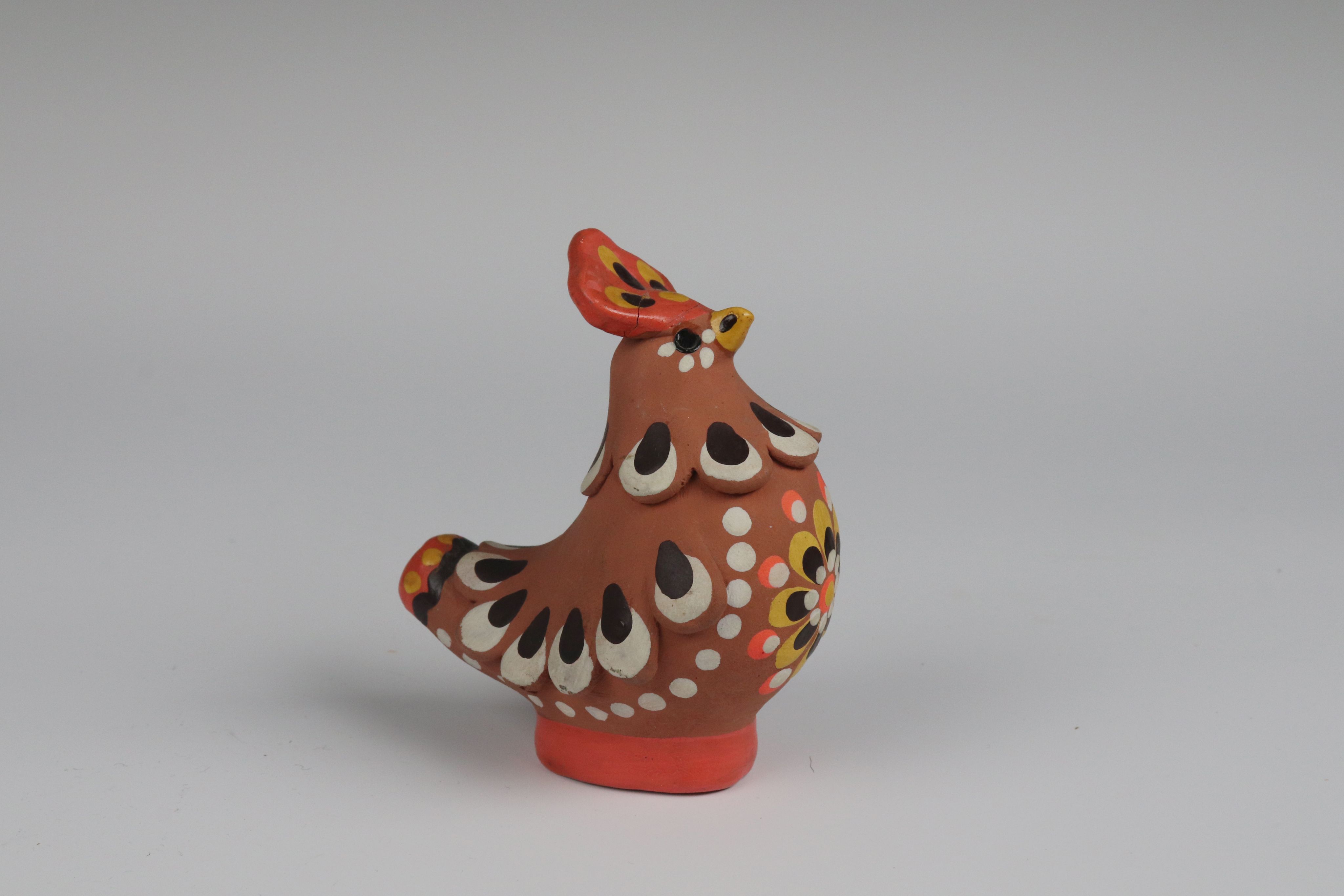
DUROM.2015.81
This clay whistle is a chicken, painted with colourful relief feathers and an elongated tail as a mouthpiece for the whistle with two holes. Details include a yellow beak and a big comb with scratched eyes on each side. Decorated with brown and yellow dots and on the breast, the area is a sun-like ornament in dots of orange, yellow, white, and brown.
See more Enchanted Treasures below in our gallery ...
"We have to create, it is the only thing louder than destruction."
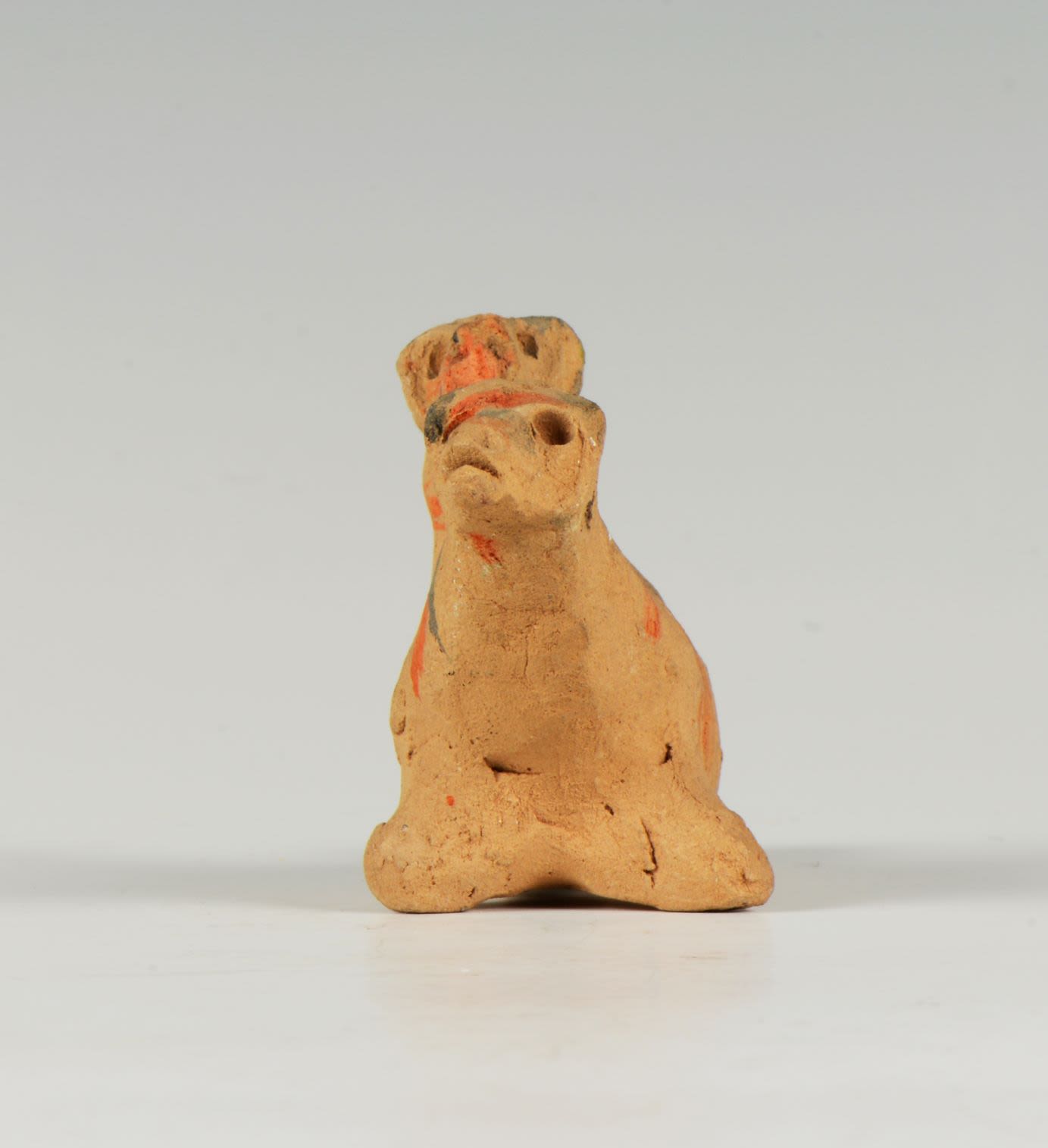
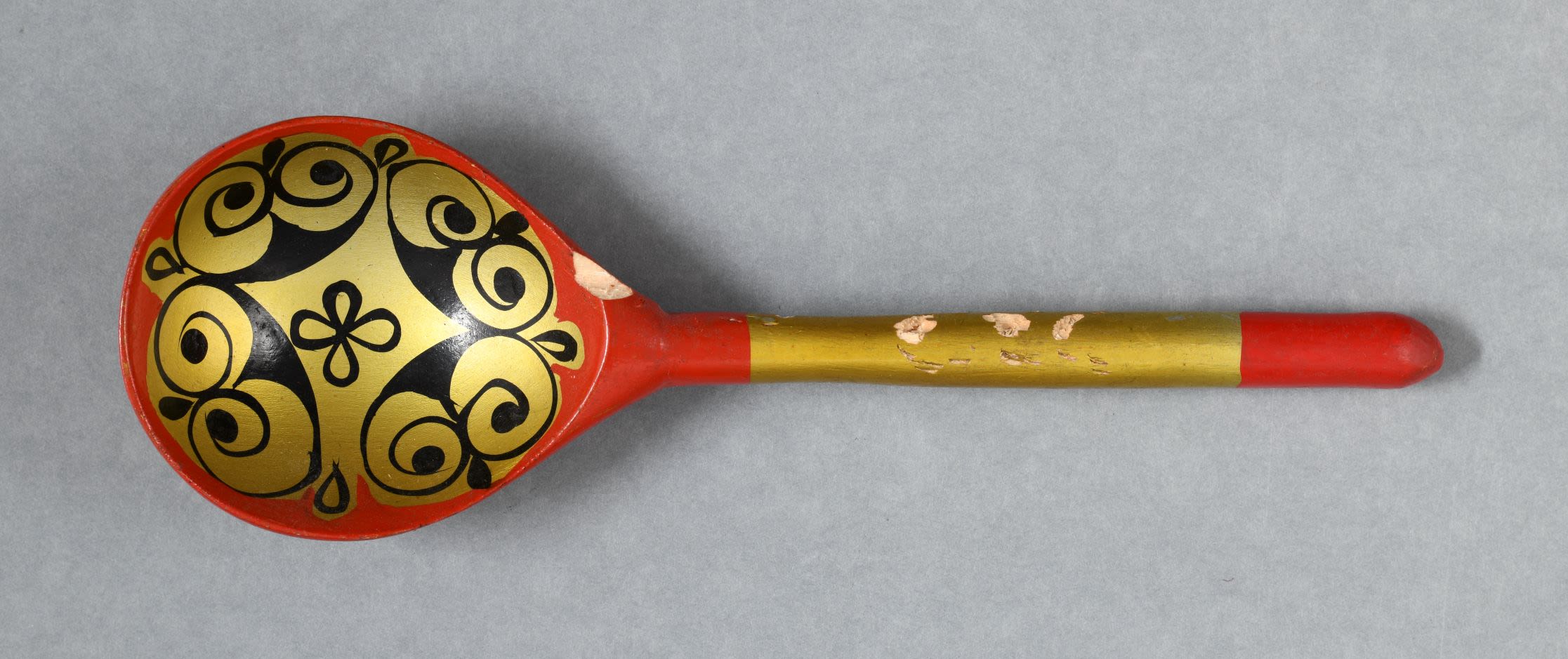
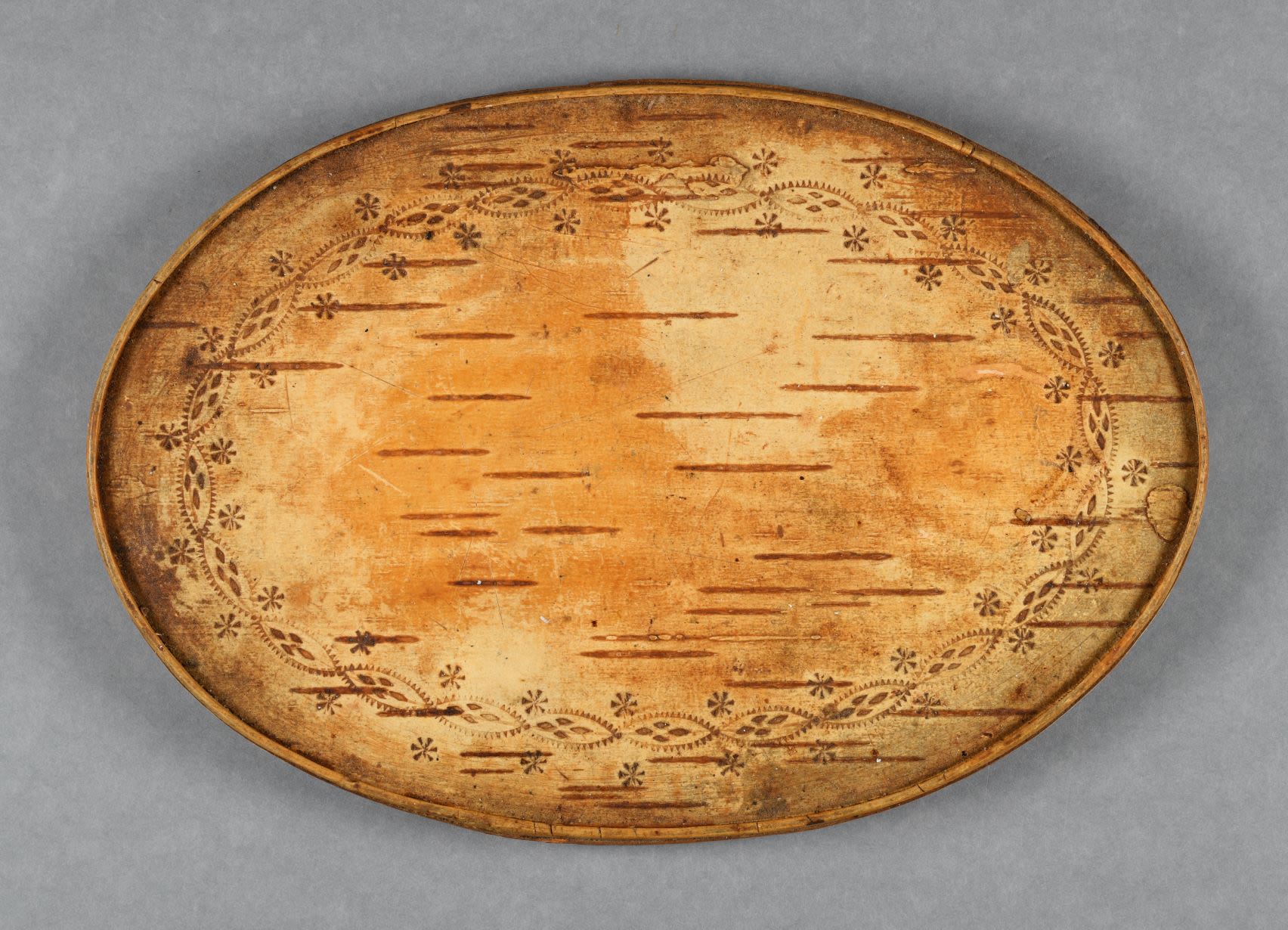
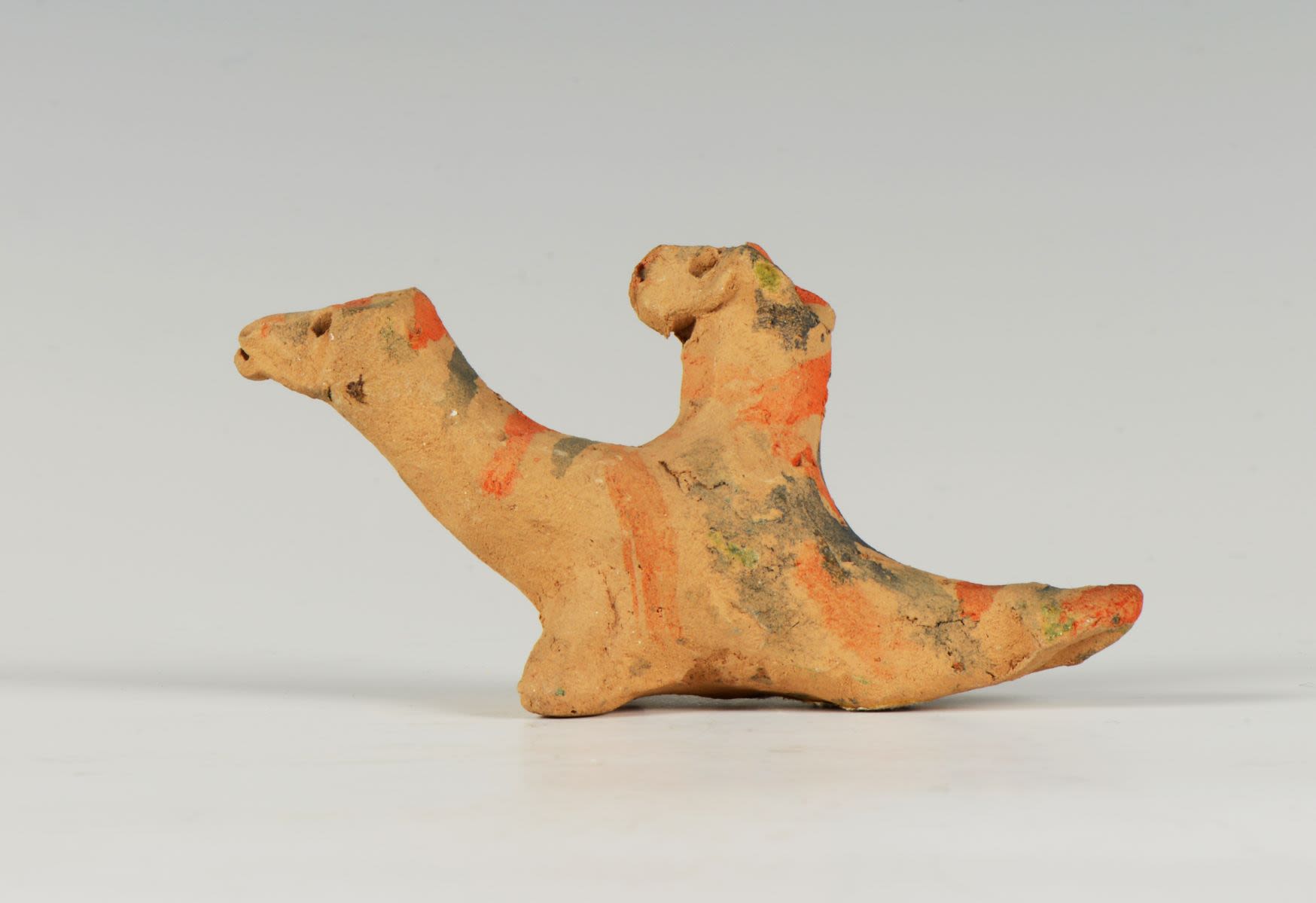
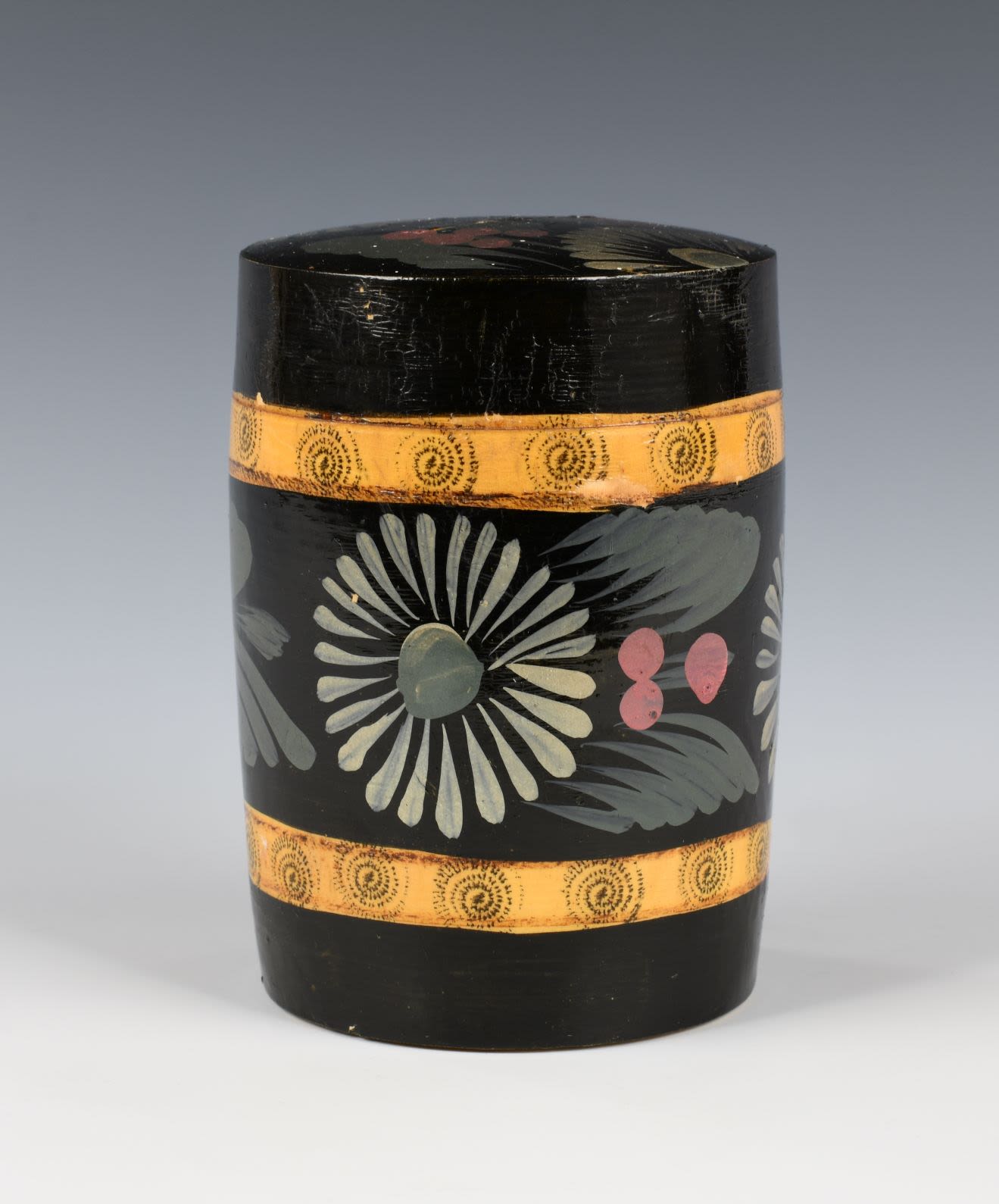
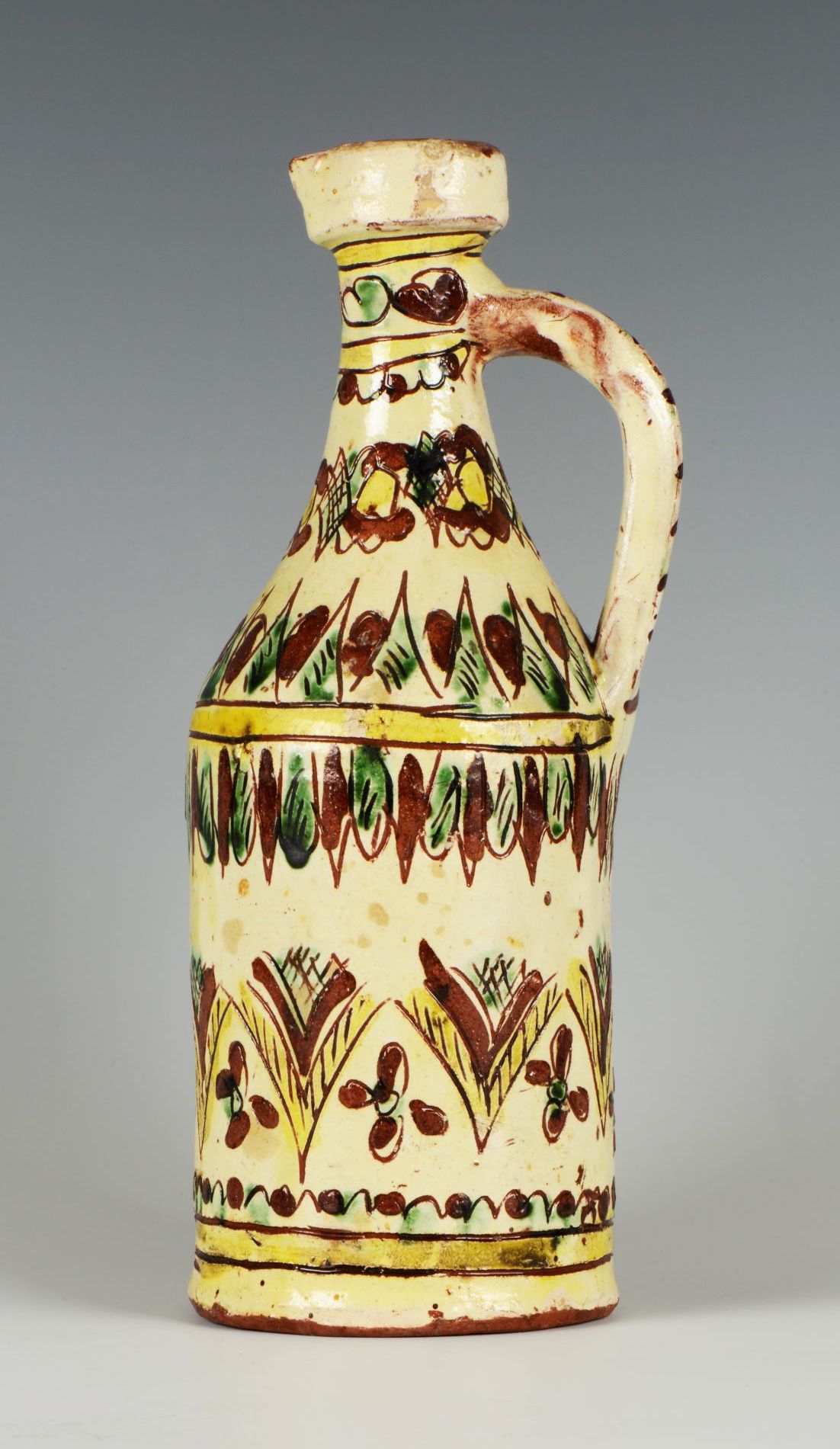
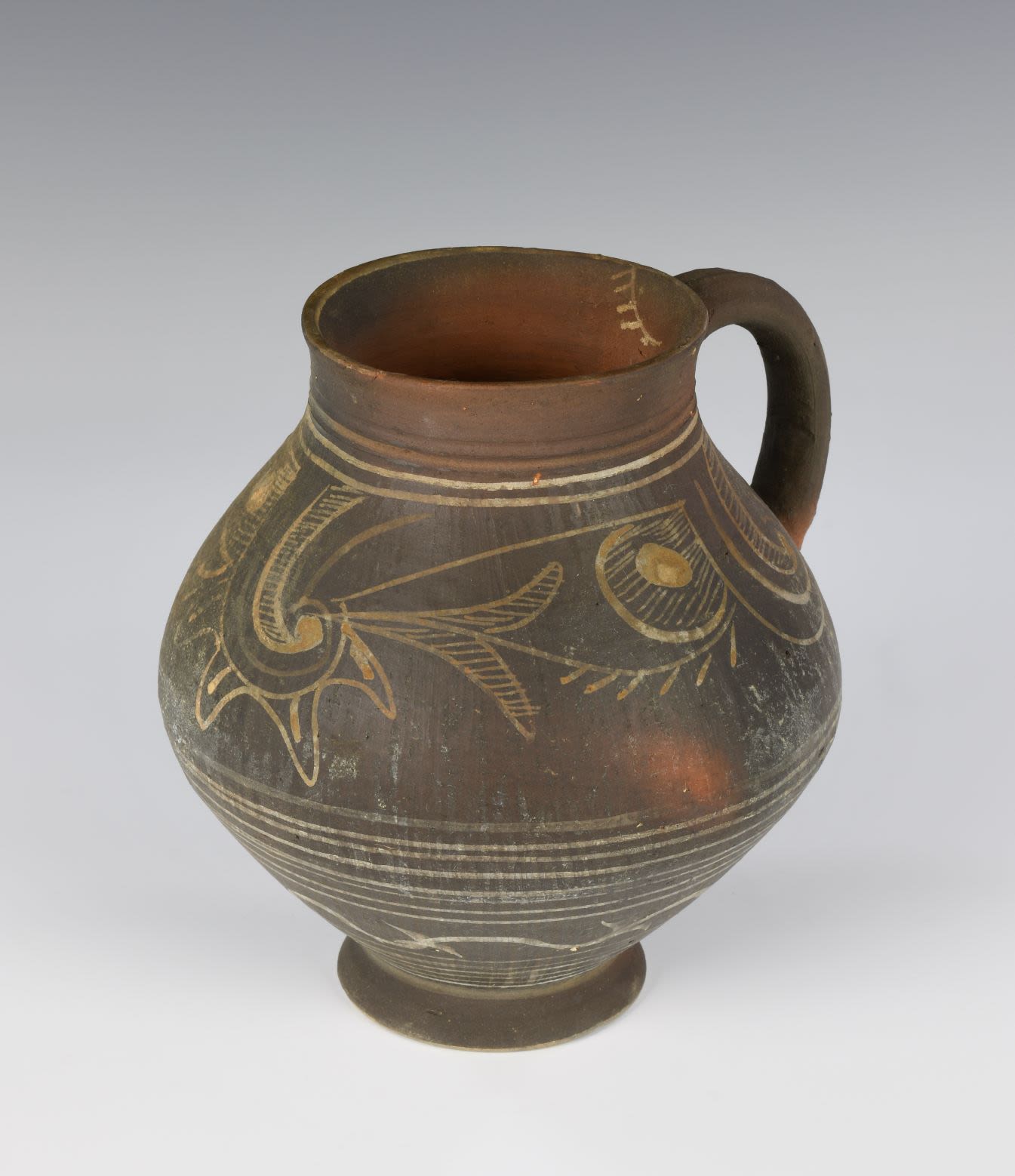
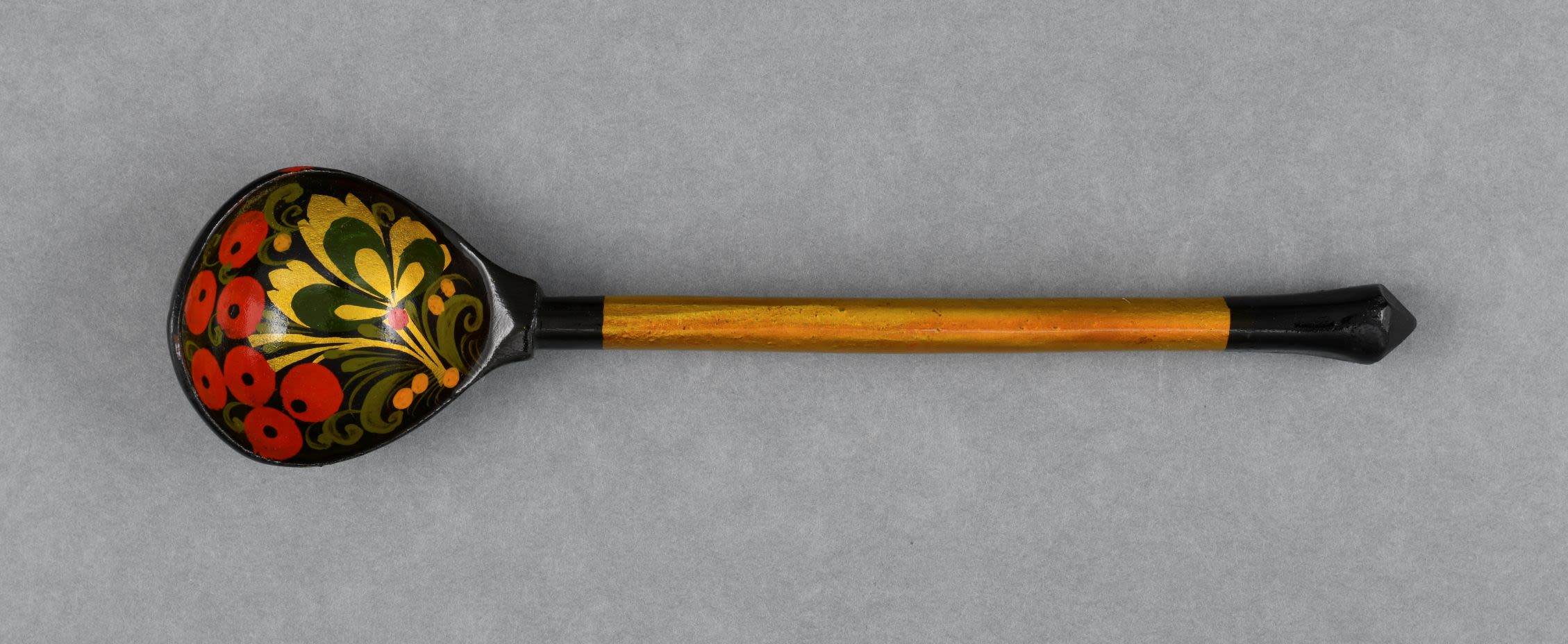
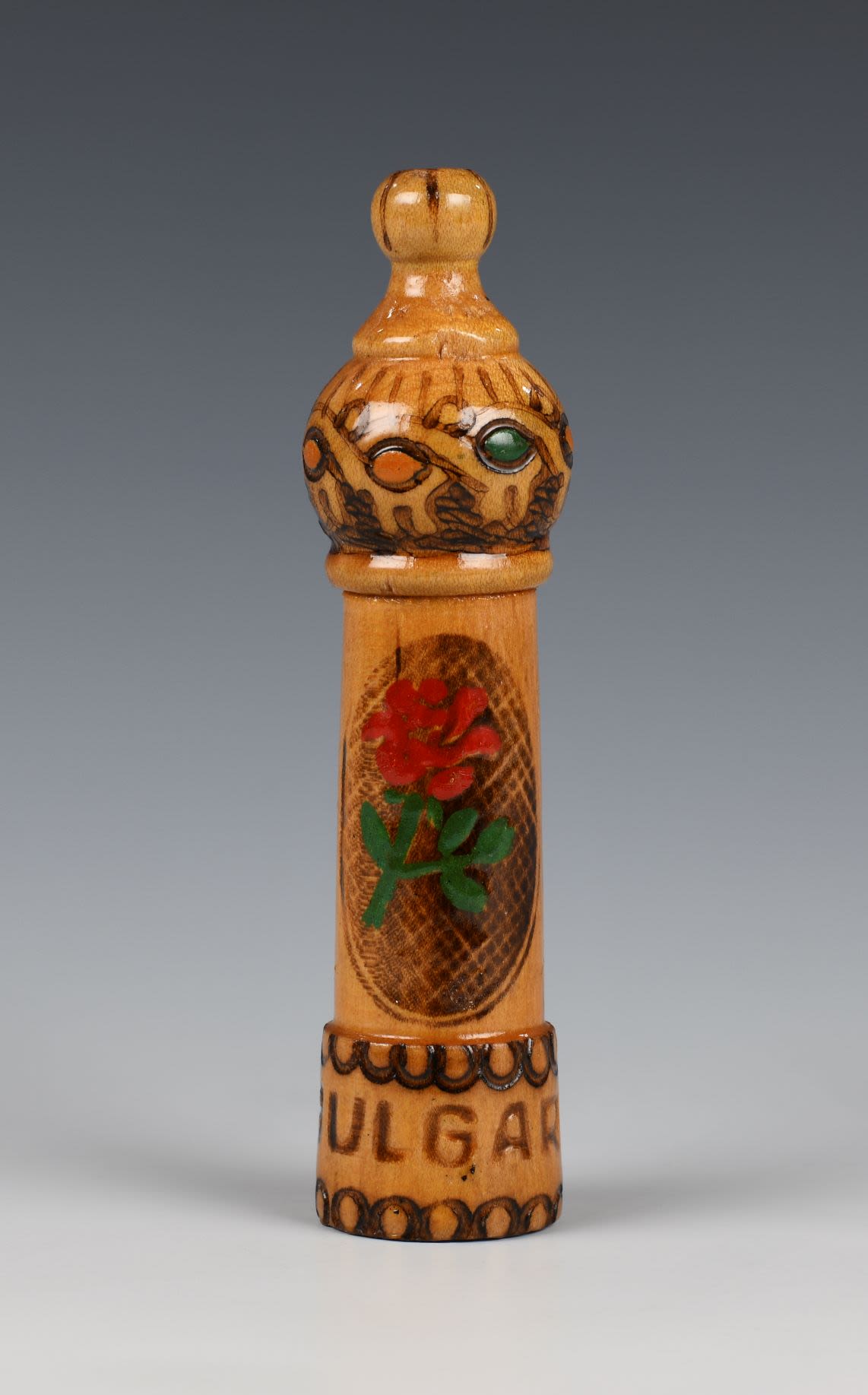
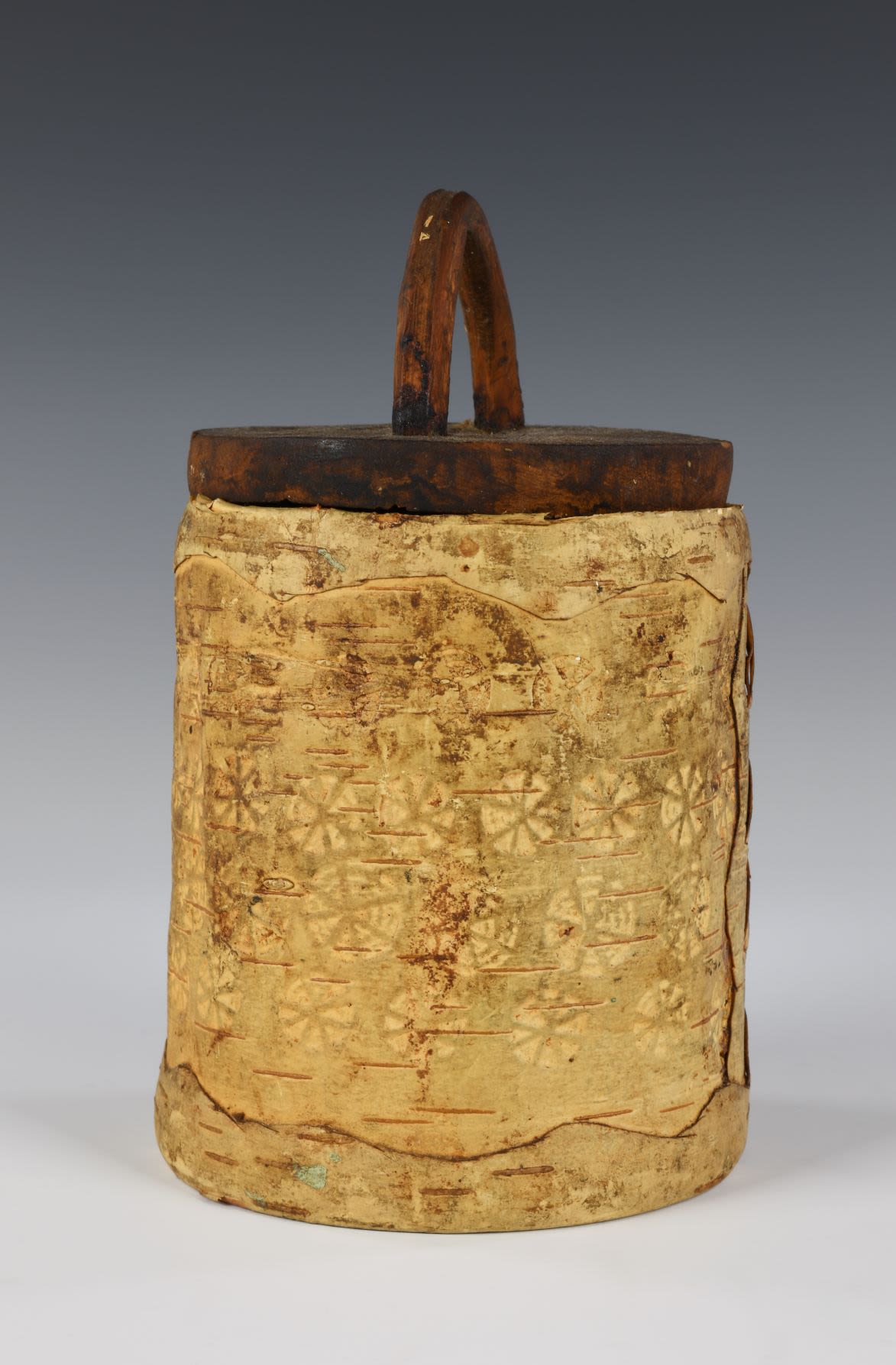

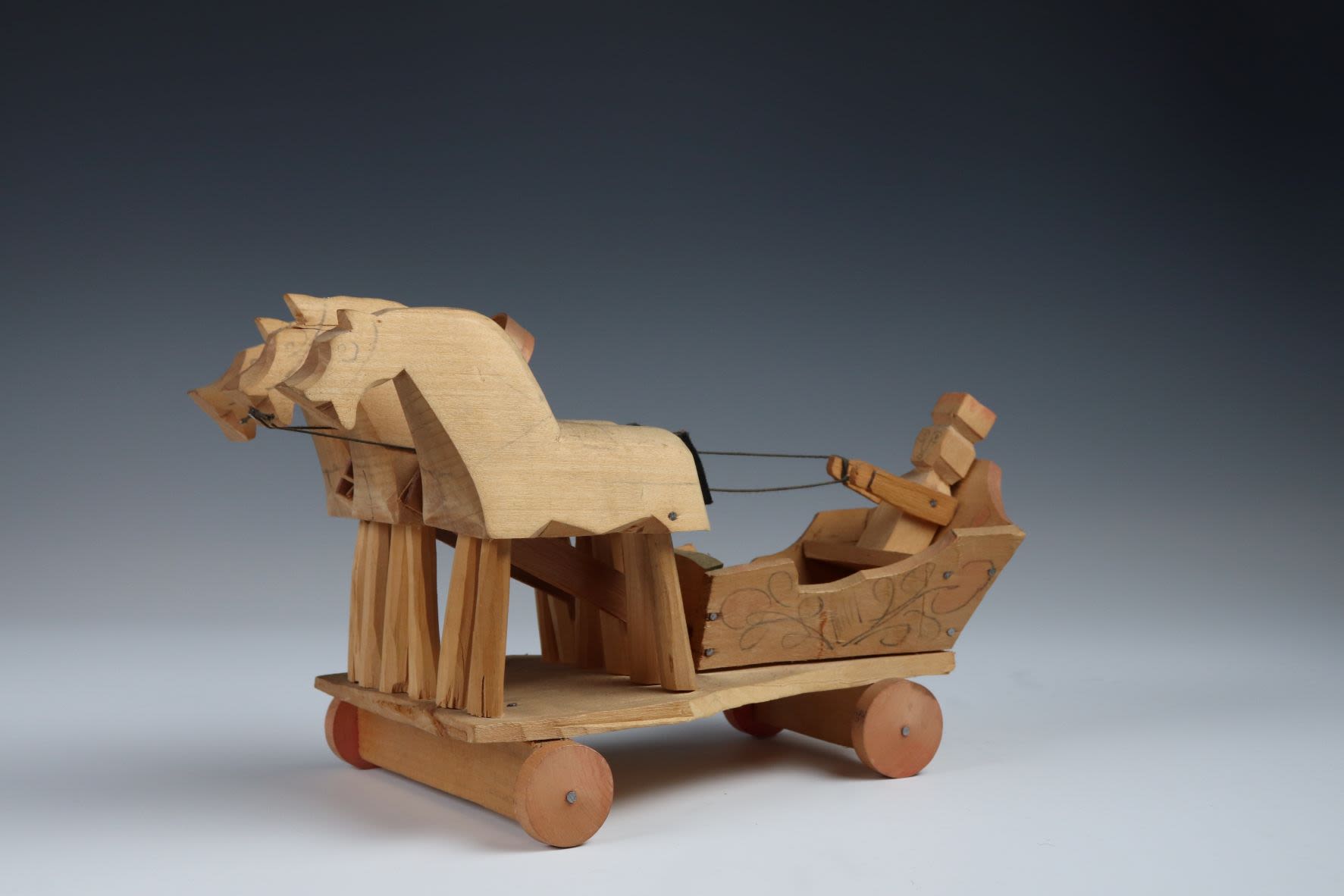
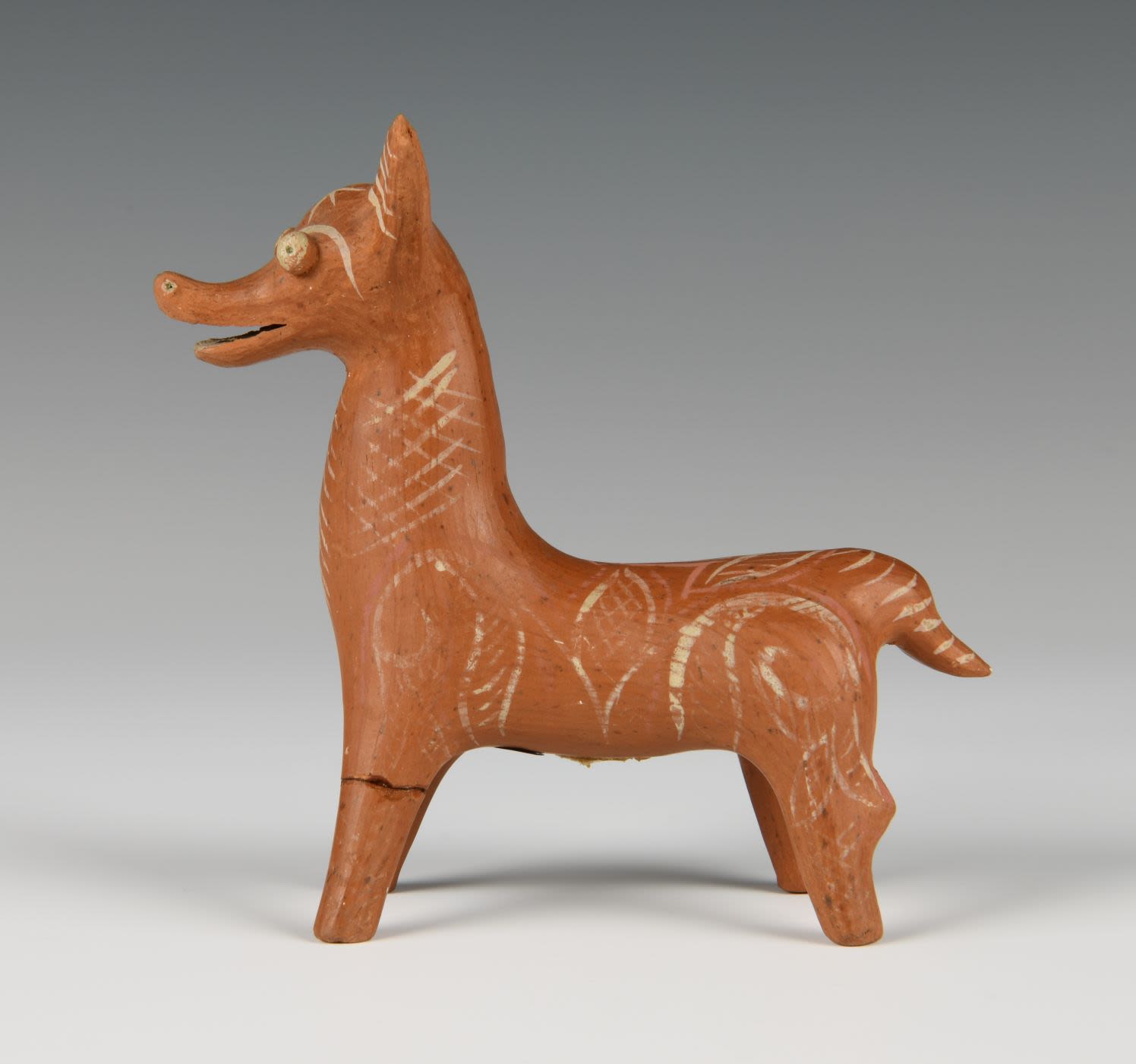
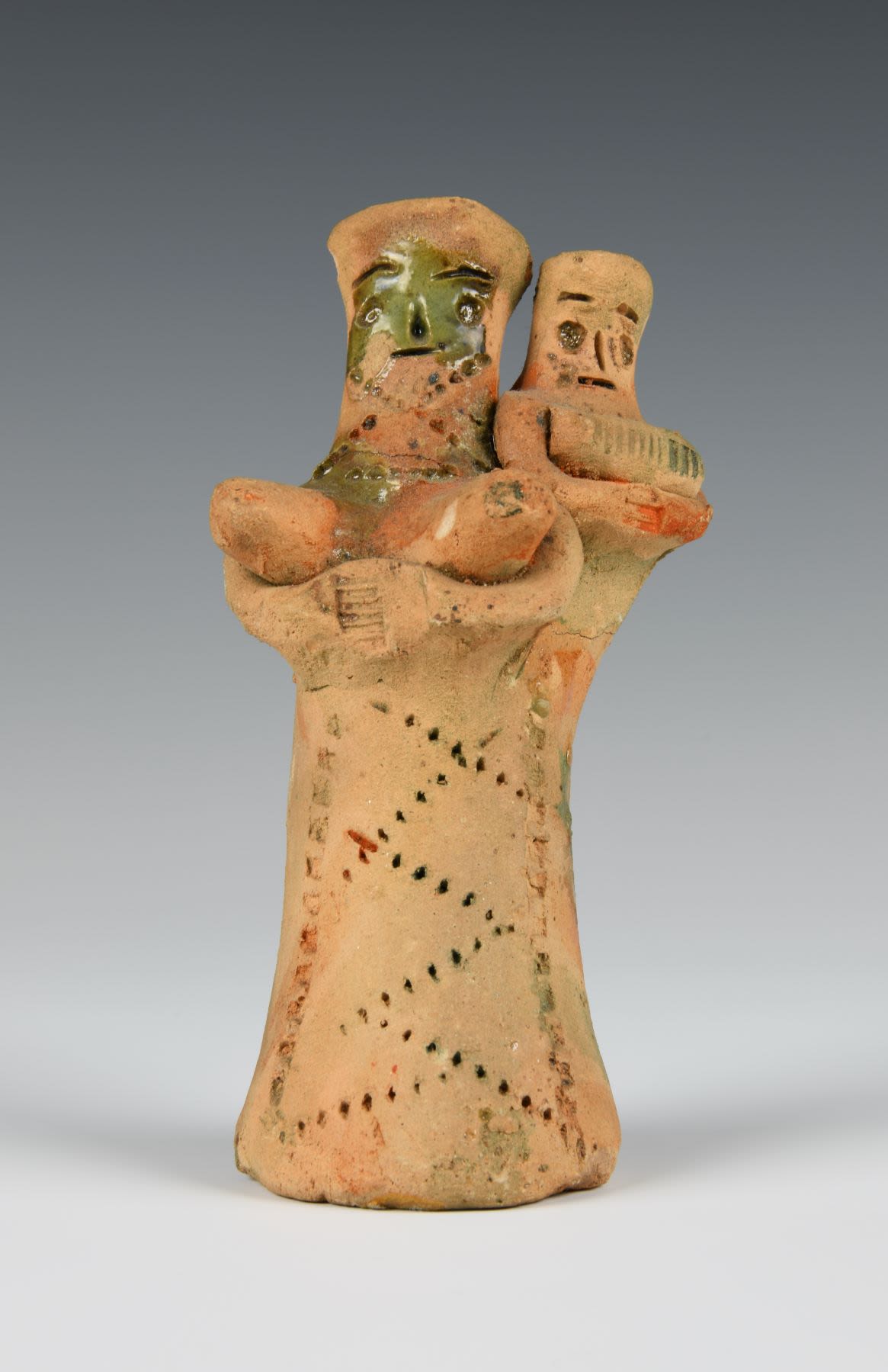
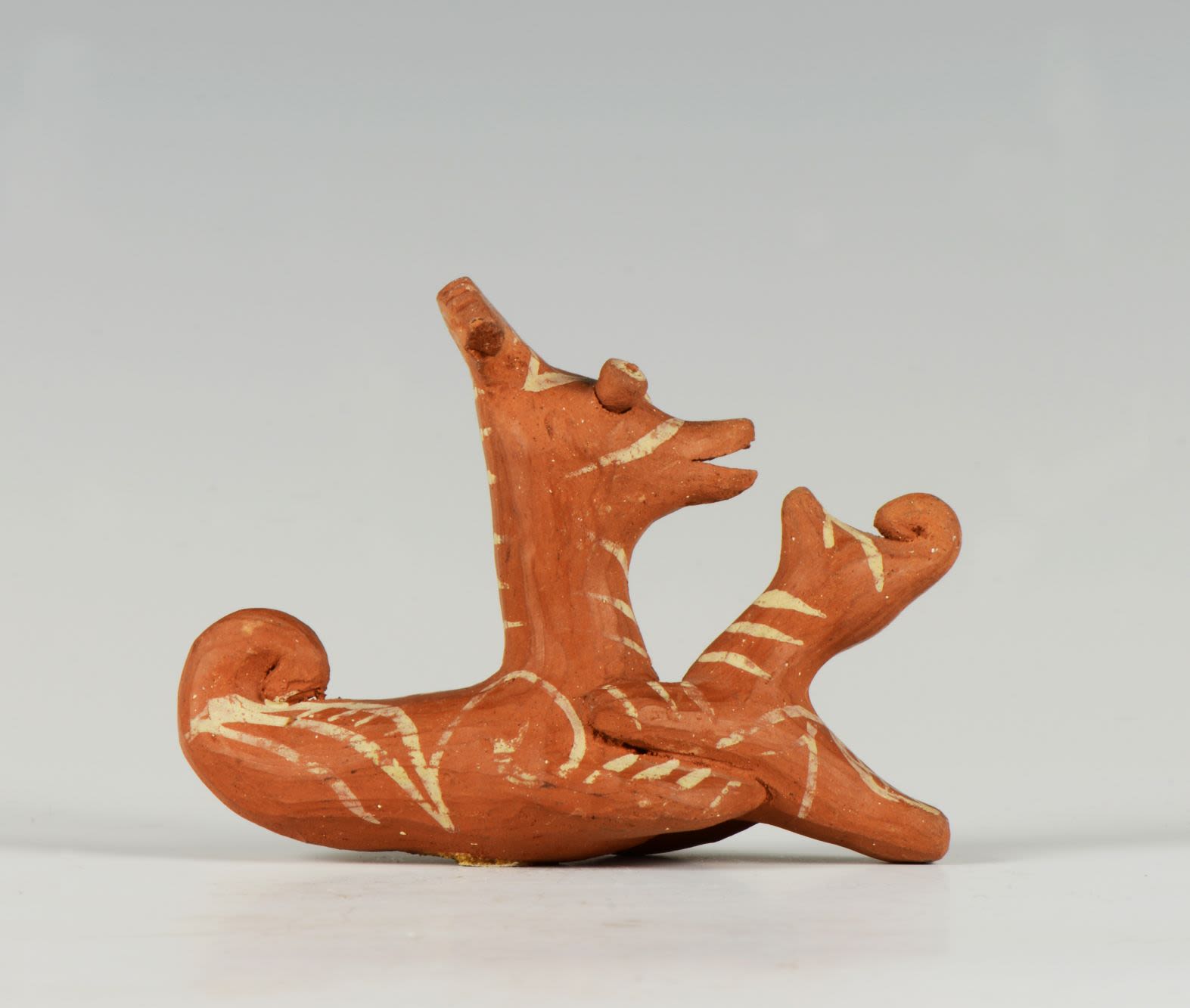
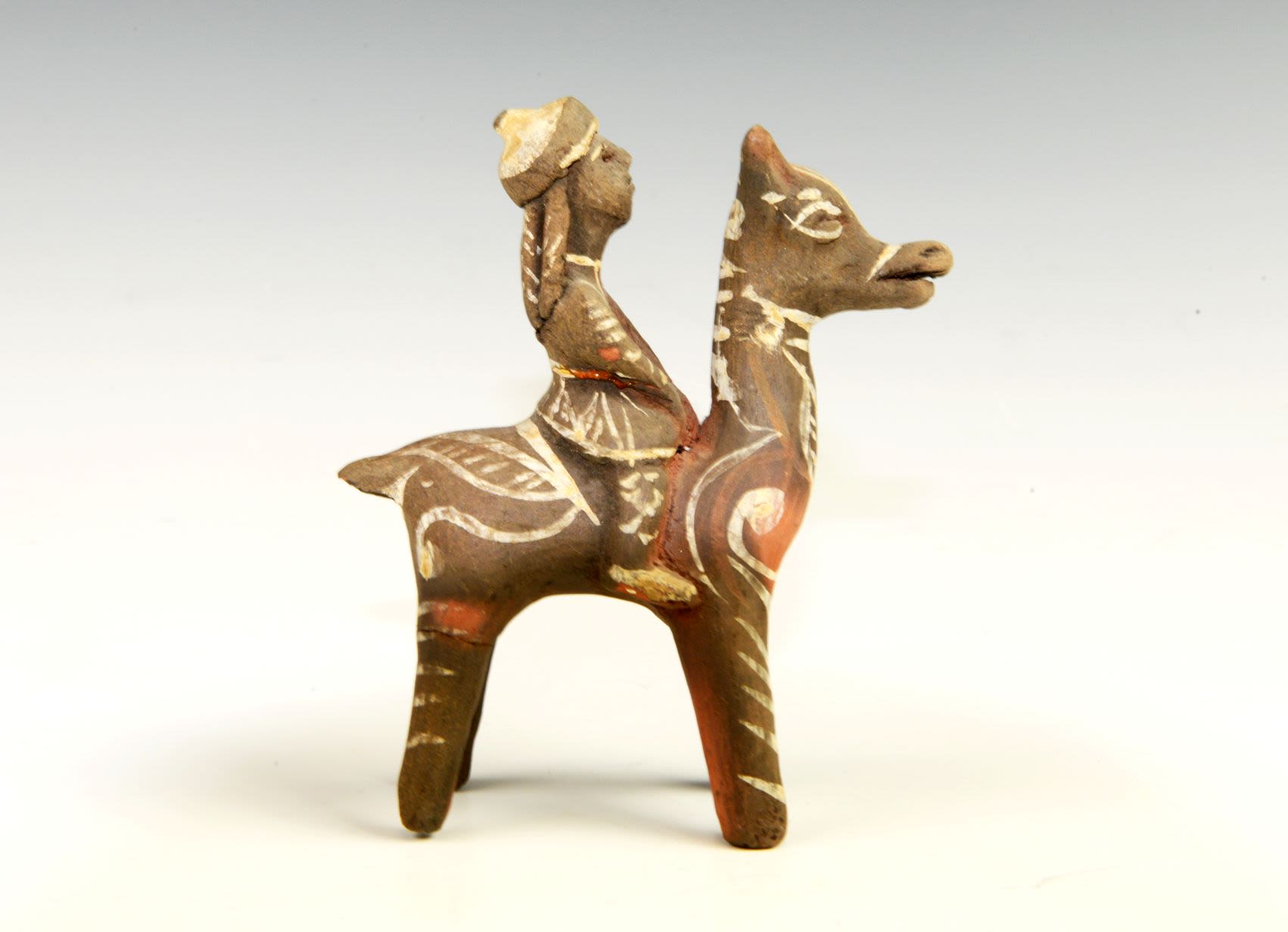


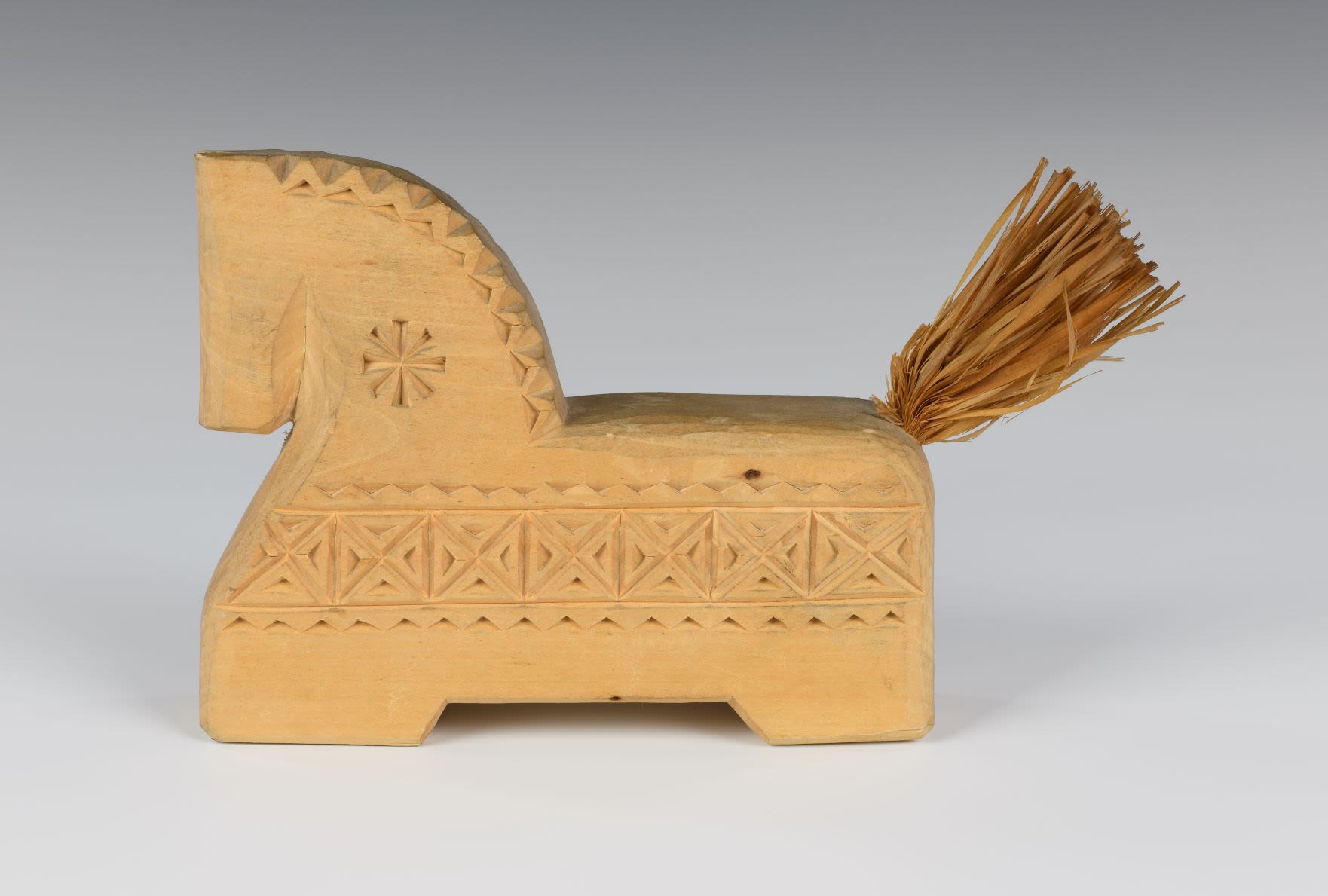
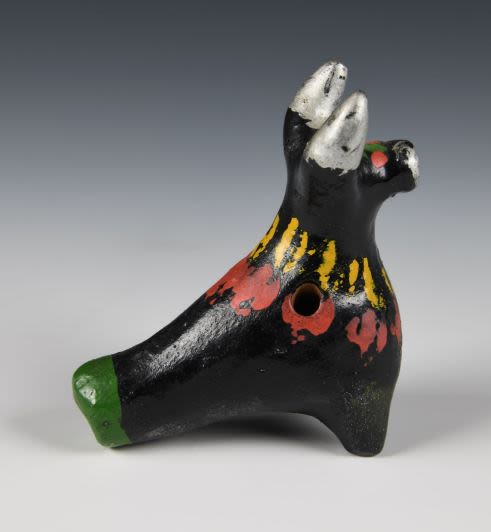
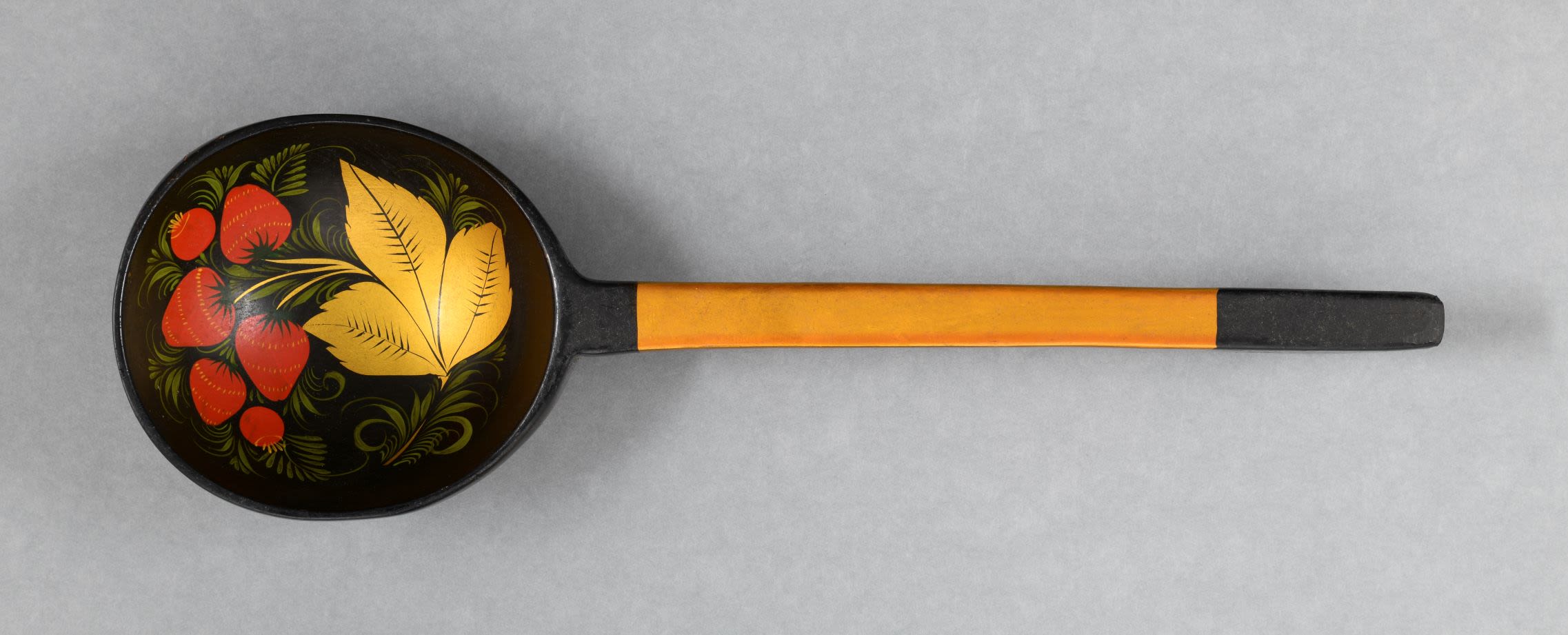
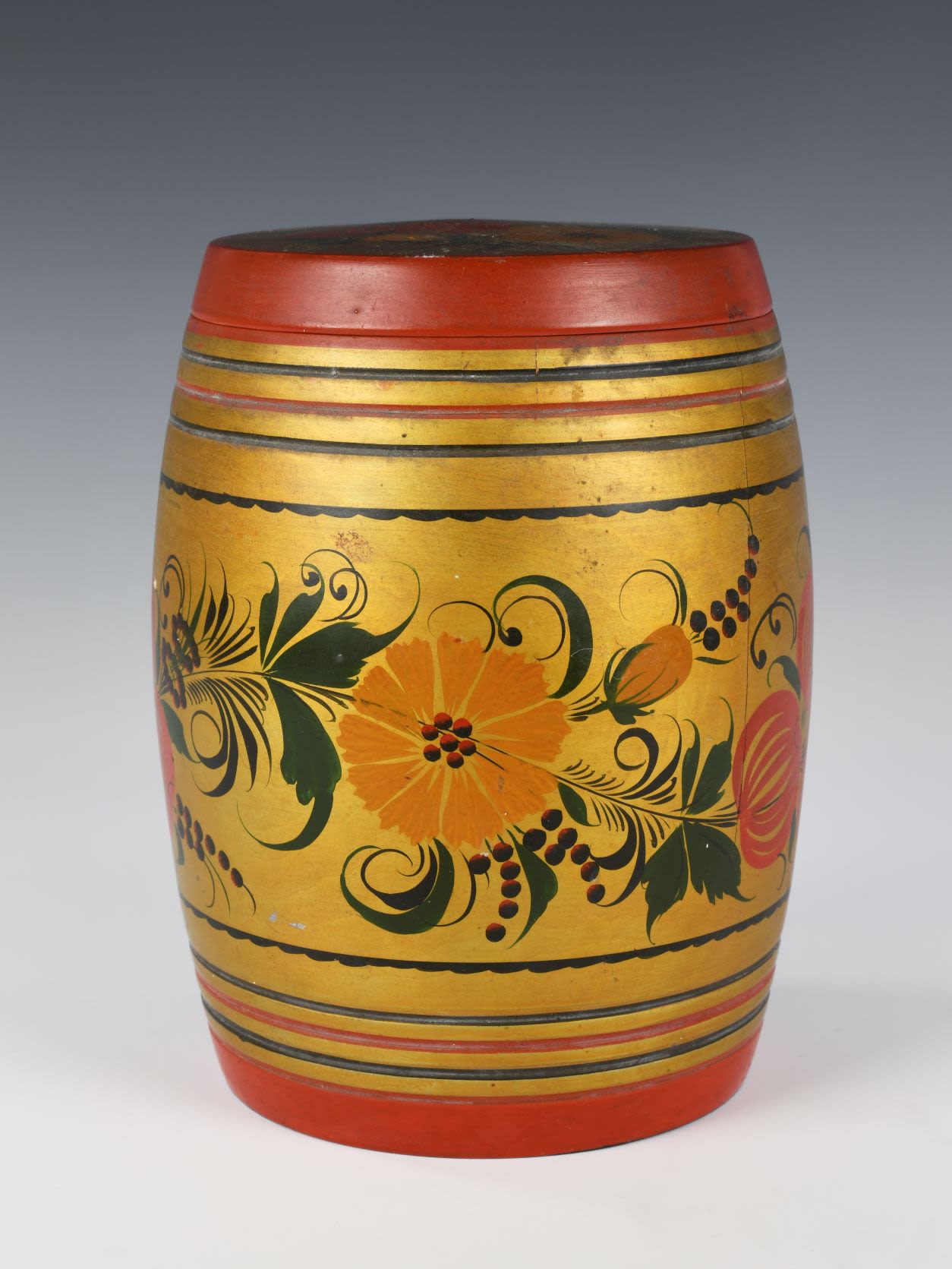
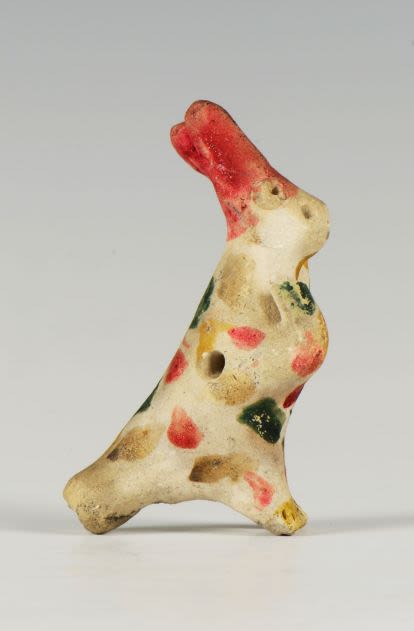

DUROM.2015.43 Clay toy from unknown region, moulded clay figure of a mysterious animal with painted geometric patterns.
DUROM.2015.43 Clay toy from unknown region, moulded clay figure of a mysterious animal with painted geometric patterns.

DUROM.2015.4 Khokhloma spoon, lacquered wooden spoon with painted floral design, possibly for serving soup.
DUROM.2015.4 Khokhloma spoon, lacquered wooden spoon with painted floral design, possibly for serving soup.

DUROM.2015.15 Birch bark tray from unknown region, lacquered wooden tray with inscribed floral and geometric patterns, commonly used in the household.
DUROM.2015.15 Birch bark tray from unknown region, lacquered wooden tray with inscribed floral and geometric patterns, commonly used in the household.

DUROM.2015.43 clay toy from unknown region, moulded clay figure of a mysterious animal with painted geometric patterns
DUROM.2015.43 clay toy from unknown region, moulded clay figure of a mysterious animal with painted geometric patterns

DUROM.2015.13 Lacquered wooden container from unknown region with painted floral and geometric design, possibly for culinary spice storage
DUROM.2015.13 Lacquered wooden container from unknown region with painted floral and geometric design, possibly for culinary spice storage

DUROM.2015.20 Khokhloma ceramic glazed jug possibly used for serving soup or drink. The jug is decorated with flowers, possibly leaves and geometric patterns painted in green, yellow and brown on a faded yellow background.
DUROM.2015.20 Khokhloma ceramic glazed jug possibly used for serving soup or drink. The jug is decorated with flowers, possibly leaves and geometric patterns painted in green, yellow and brown on a faded yellow background.

DUROM.2015.101 Balkhar clay jug, called an ursha jug with painted floral and geometric patterns, possibly used for carrying water.
DUROM.2015.101 Balkhar clay jug, called an ursha jug with painted floral and geometric patterns, possibly used for carrying water.

DUROM.2015.1 Khokhloma spoon, lacquered wooden spoon with painted floral design, possibly for serving soup.
DUROM.2015.1 Khokhloma spoon, lacquered wooden spoon with painted floral design, possibly for serving soup.

DUROM.2015.26 Possibly a wooden pepper or salt shaker, rose design on the main body with the word Bulgaria on the bottom.
DUROM.2015.26 Possibly a wooden pepper or salt shaker, rose design on the main body with the word Bulgaria on the bottom.

DUROM.2015.17 Birch bark jar called a tuesok or tues. The jar is decorated with geometric patterns and is possibly used for storing rice or grain.
DUROM.2015.17 Birch bark jar called a tuesok or tues. The jar is decorated with geometric patterns and is possibly used for storing rice or grain.

DUROM.2015.26 Possibly a wooden pepper or salt shaker, rose design on the main body, with the word Bulgaria on the bottom.
DUROM.2015.26 Possibly a wooden pepper or salt shaker, rose design on the main body, with the word Bulgaria on the bottom.

DUROM.2015.48 Fedoseyevo wooden toy, carved wooden troika (sledge) with three horses and a driver.
DUROM.2015.48 Fedoseyevo wooden toy, carved wooden troika (sledge) with three horses and a driver.

DUROM.2015.94 Balkhar clay toy, moulded clay toy of a mysterious animal decorated with geometric patterns.
DUROM.2015.94 Balkhar clay toy, moulded clay toy of a mysterious animal decorated with geometric patterns.

DUROM.2015.88 moulded clay figure of a woman with a green-glazed face holding a child, decorated with geometric motifs and blue and red pigments.
DUROM.2015.88 moulded clay figure of a woman with a green-glazed face holding a child, decorated with geometric motifs and blue and red pigments.

DUROM.2015.95 Balkhar clay toy, moulded in the shape of a mysterious animal and painted with stripes.
DUROM.2015.95 Balkhar clay toy, moulded in the shape of a mysterious animal and painted with stripes.

DUROM.2015.93 Made in the Russian village of Balkhar. The rider and animal, which may be an antelope, are decorated with stripes and swirls using white paint.
DUROM.2015.93 Made in the Russian village of Balkhar. The rider and animal, which may be an antelope, are decorated with stripes and swirls using white paint.

DUROM.2015.20 Khokhloma ceramic glazed jug possibly used for serving soup or drink. The jug is decorated with flowers, possibly leaves and geometric patterns painted in green, yellow and brown on a faded yellow background.
DUROM.2015.20 Khokhloma ceramic glazed jug possibly used for serving soup or drink. The jug is decorated with flowers, possibly leaves and geometric patterns painted in green, yellow and brown on a faded yellow background.

DUROM.2015.8 Khokhloma hand-painted cup decorated with gold painted leaves, red Rowan berries and green leaves. Likely used for drinking from.
DUROM.2015.8 Khokhloma hand-painted cup decorated with gold painted leaves, red Rowan berries and green leaves. Likely used for drinking from.

DUROM.2015.65 toy horse made from wood with geometric patterns and a tail that is possibly made of straw. The neck of the horse has an image that is probably the sun.
DUROM.2015.65 toy horse made from wood with geometric patterns and a tail that is possibly made of straw. The neck of the horse has an image that is probably the sun.

DUROM.2015.79 Zhbannikov clay whistle, moulded clay in the shape of a cow, decorated with coffee-bean-like pattern in yellow and red.
DUROM.2015.79 Zhbannikov clay whistle, moulded clay in the shape of a cow, decorated with coffee-bean-like pattern in yellow and red.

DUROM.2015.5 Khokhloma spoon, lacquered wooden spoon with painted floral design, possibly for serving soup.
DUROM.2015.5 Khokhloma spoon, lacquered wooden spoon with painted floral design, possibly for serving soup.

DUROM.2015.10 Khokhloma wooden jar with a lid, lacquered golden surface with floral patterns on it, possibly a container of rice or grain.
DUROM.2015.10 Khokhloma wooden jar with a lid, lacquered golden surface with floral patterns on it, possibly a container of rice or grain.

DUORM.2015.38 Clay whistle from unknown region, moulded clay in the shape of a rabbit, decorated with splashes of green, red, black and yellow on the unpainted dirty white surface.
DUORM.2015.38 Clay whistle from unknown region, moulded clay in the shape of a rabbit, decorated with splashes of green, red, black and yellow on the unpainted dirty white surface.
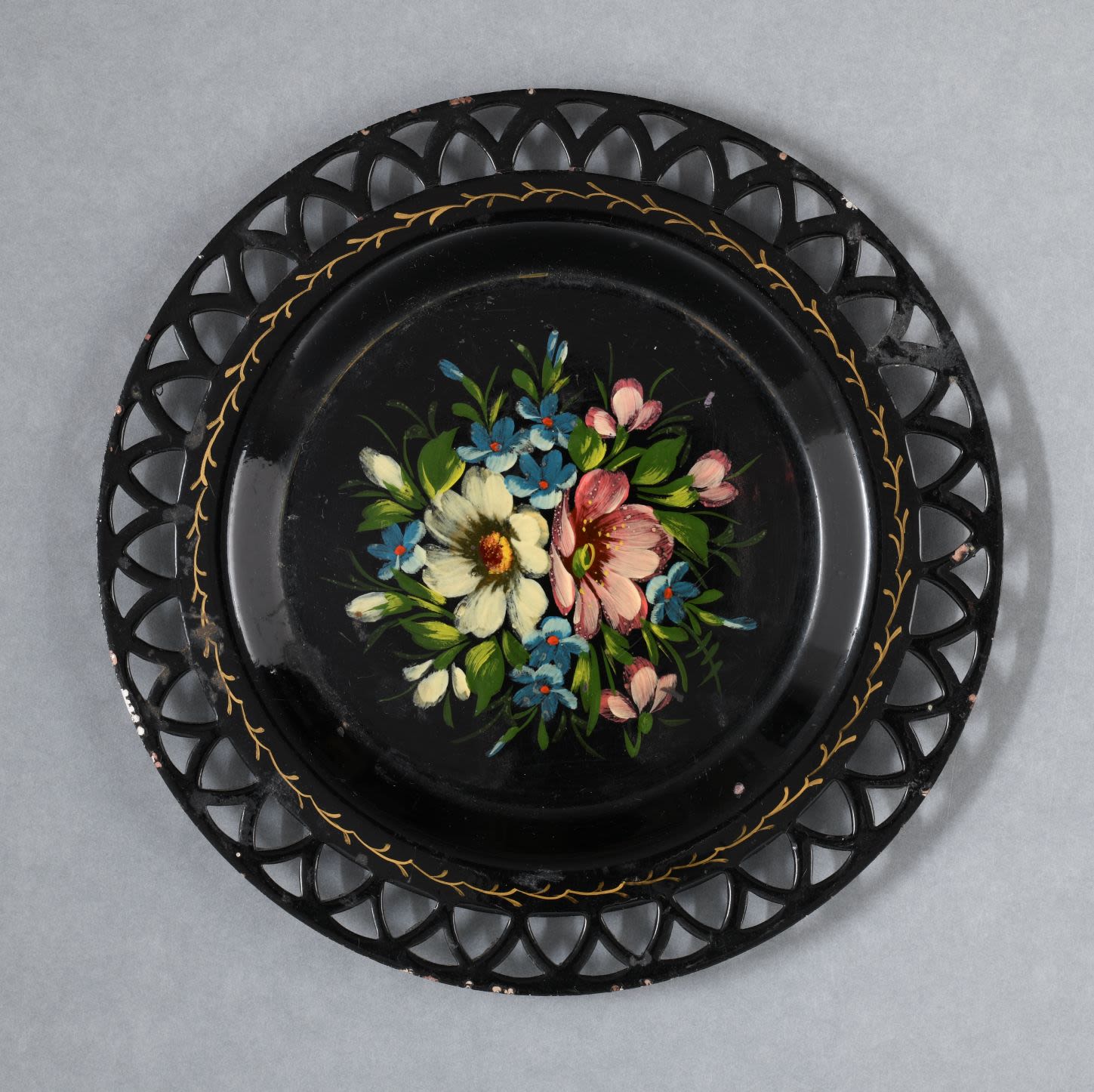
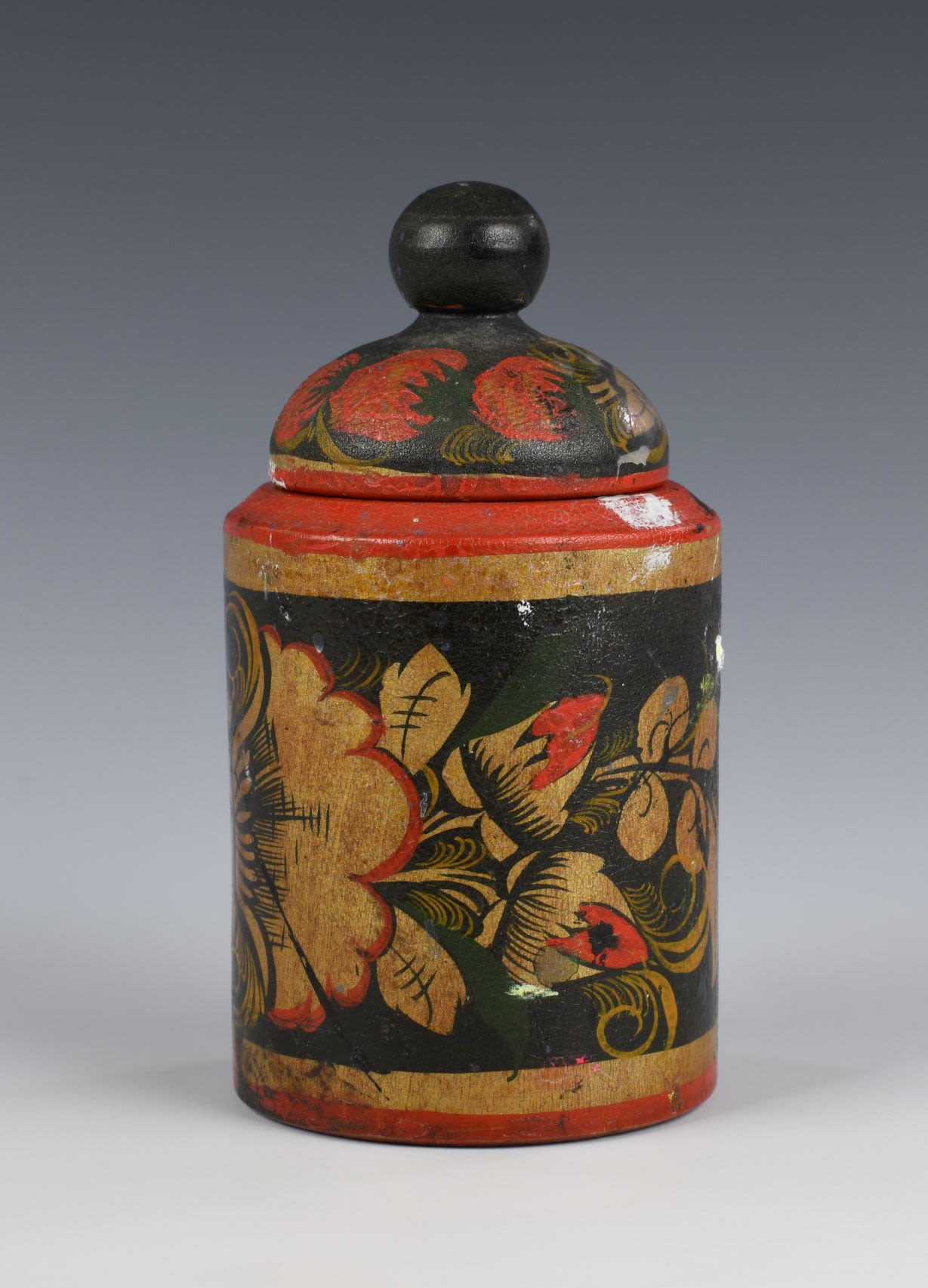

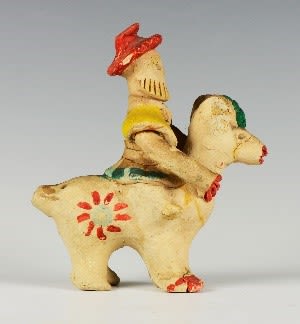
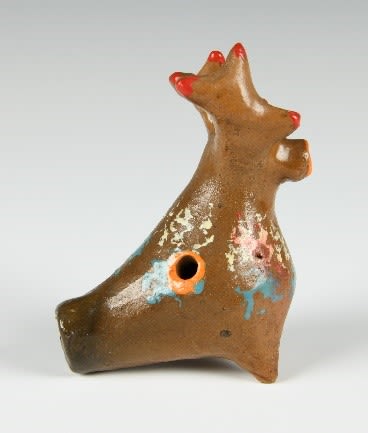
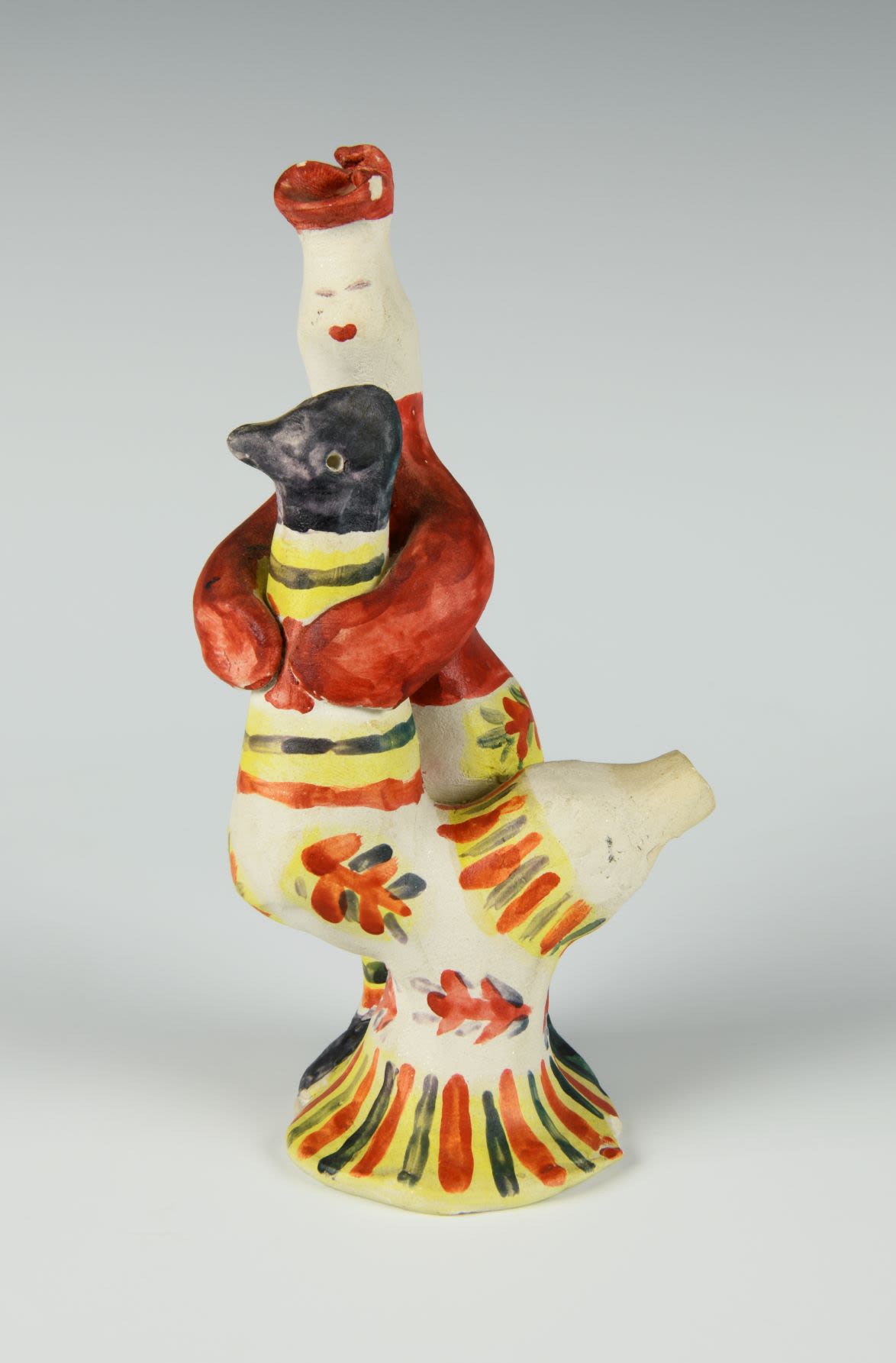

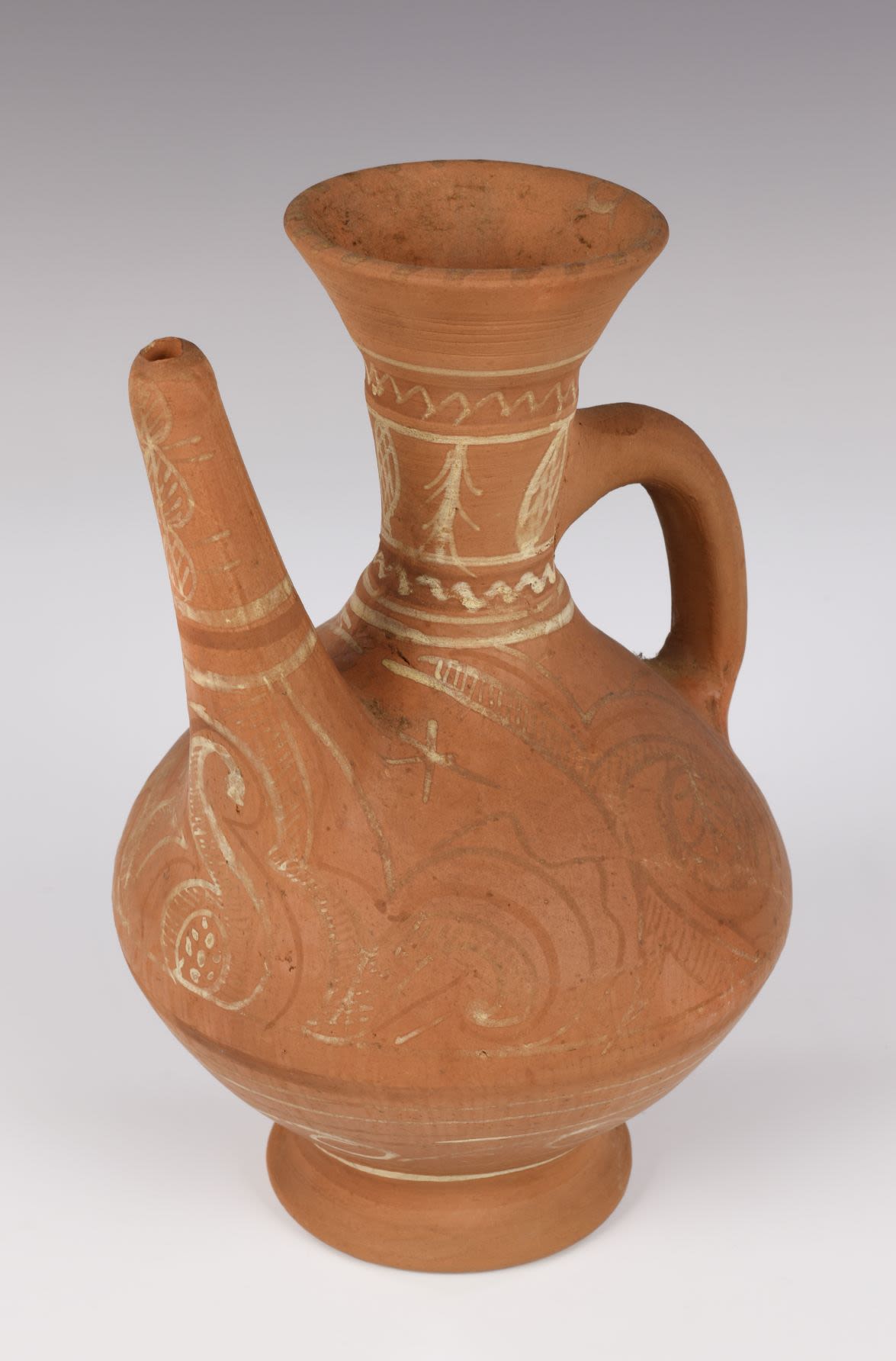
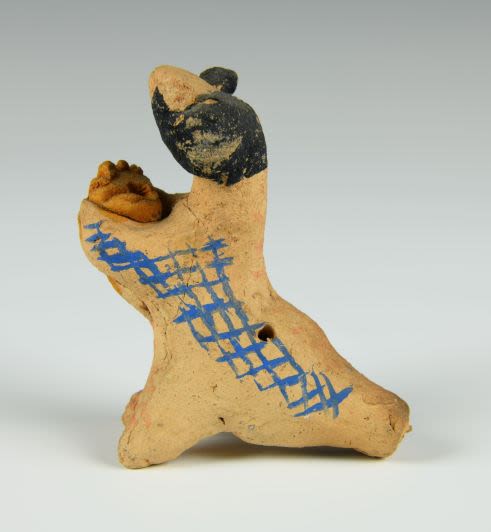

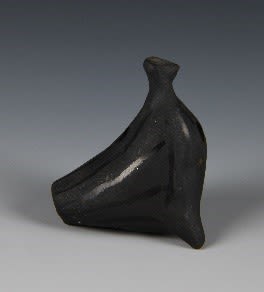
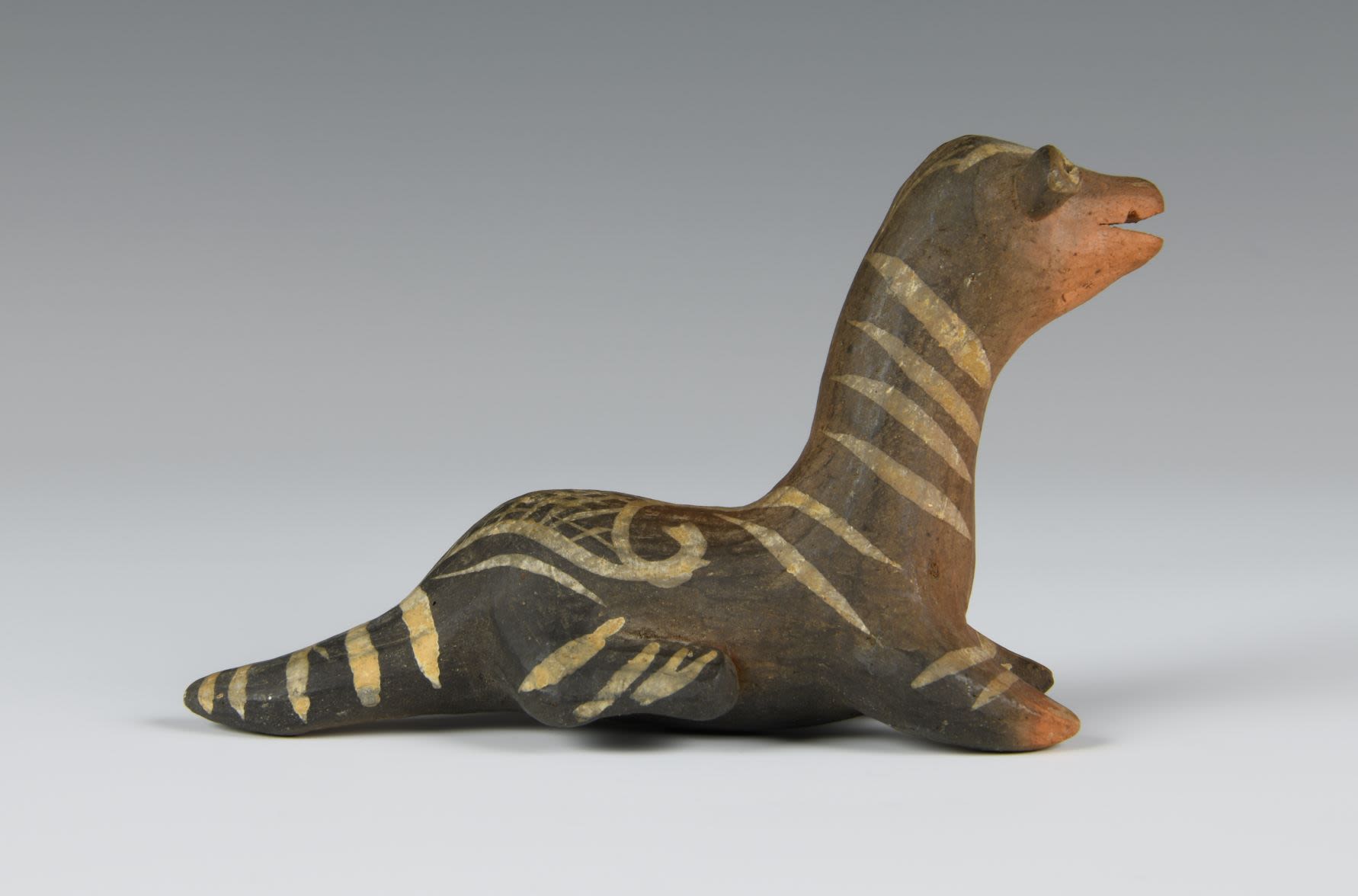

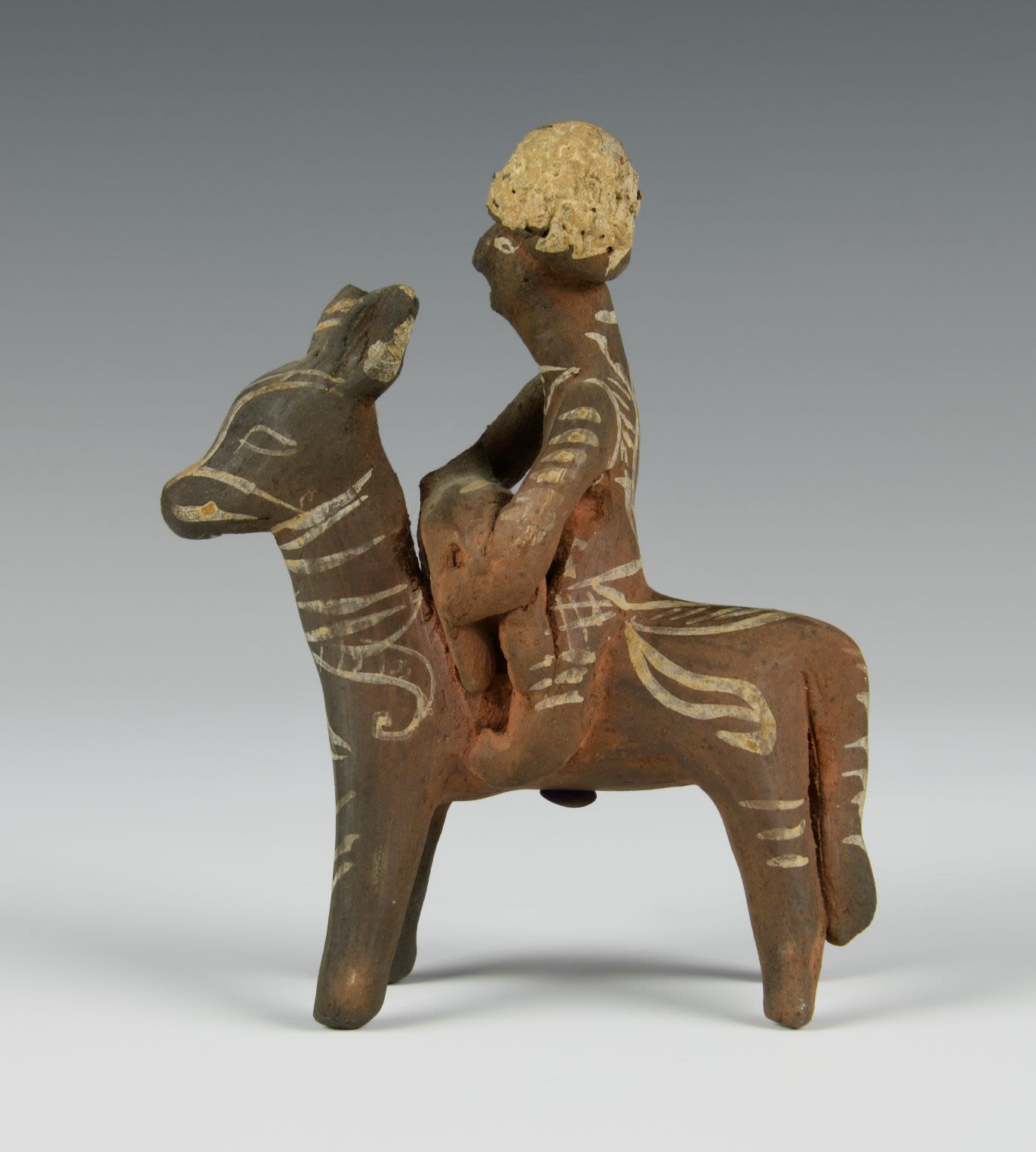
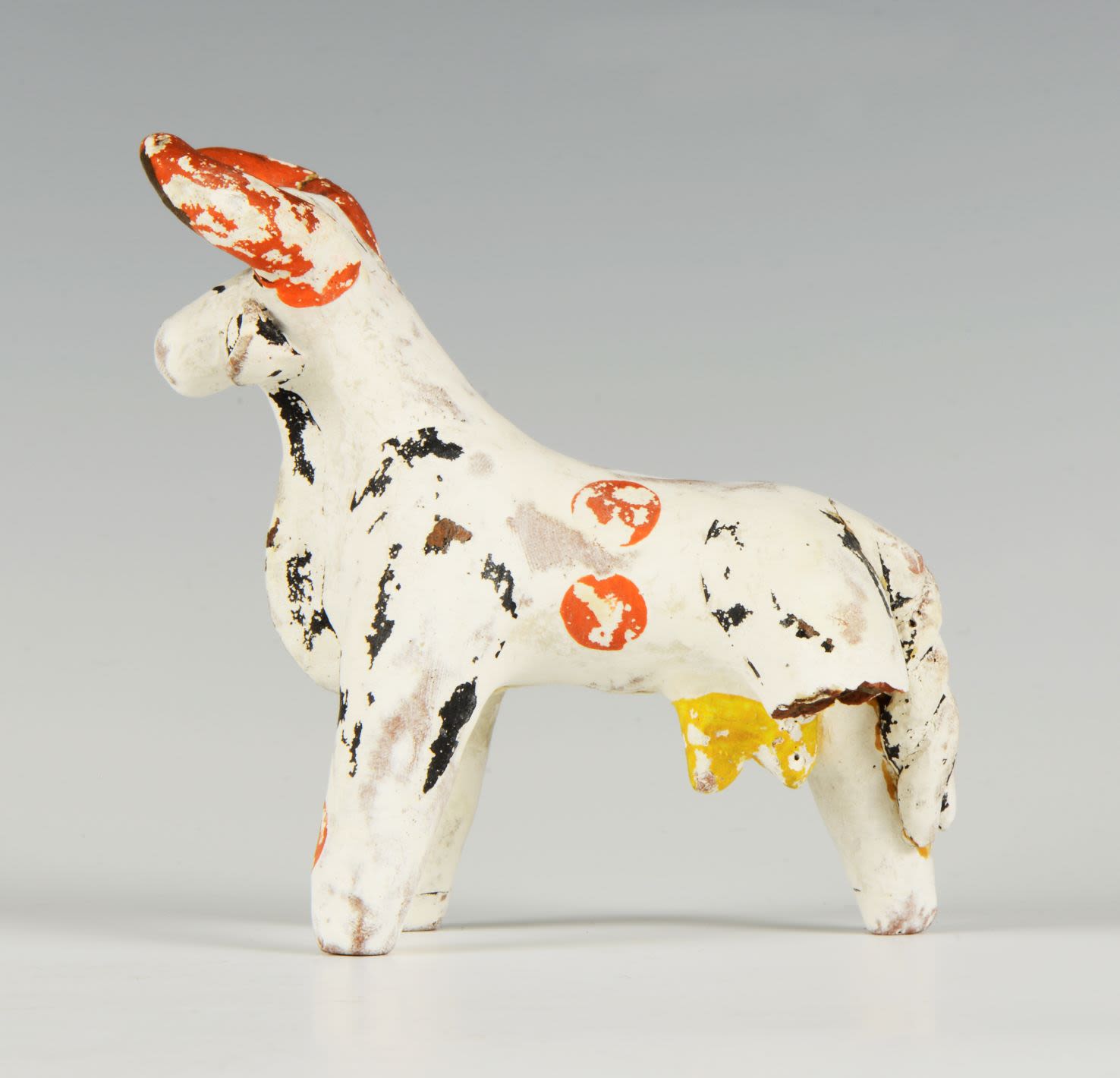
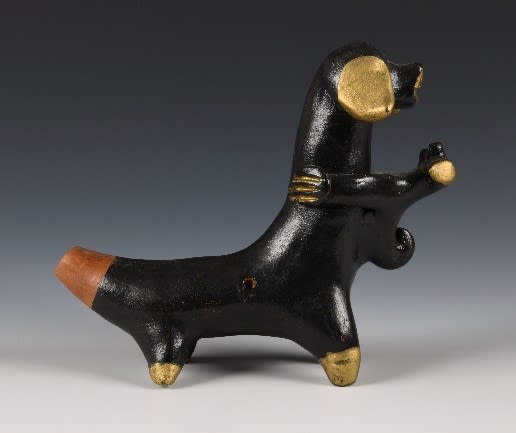
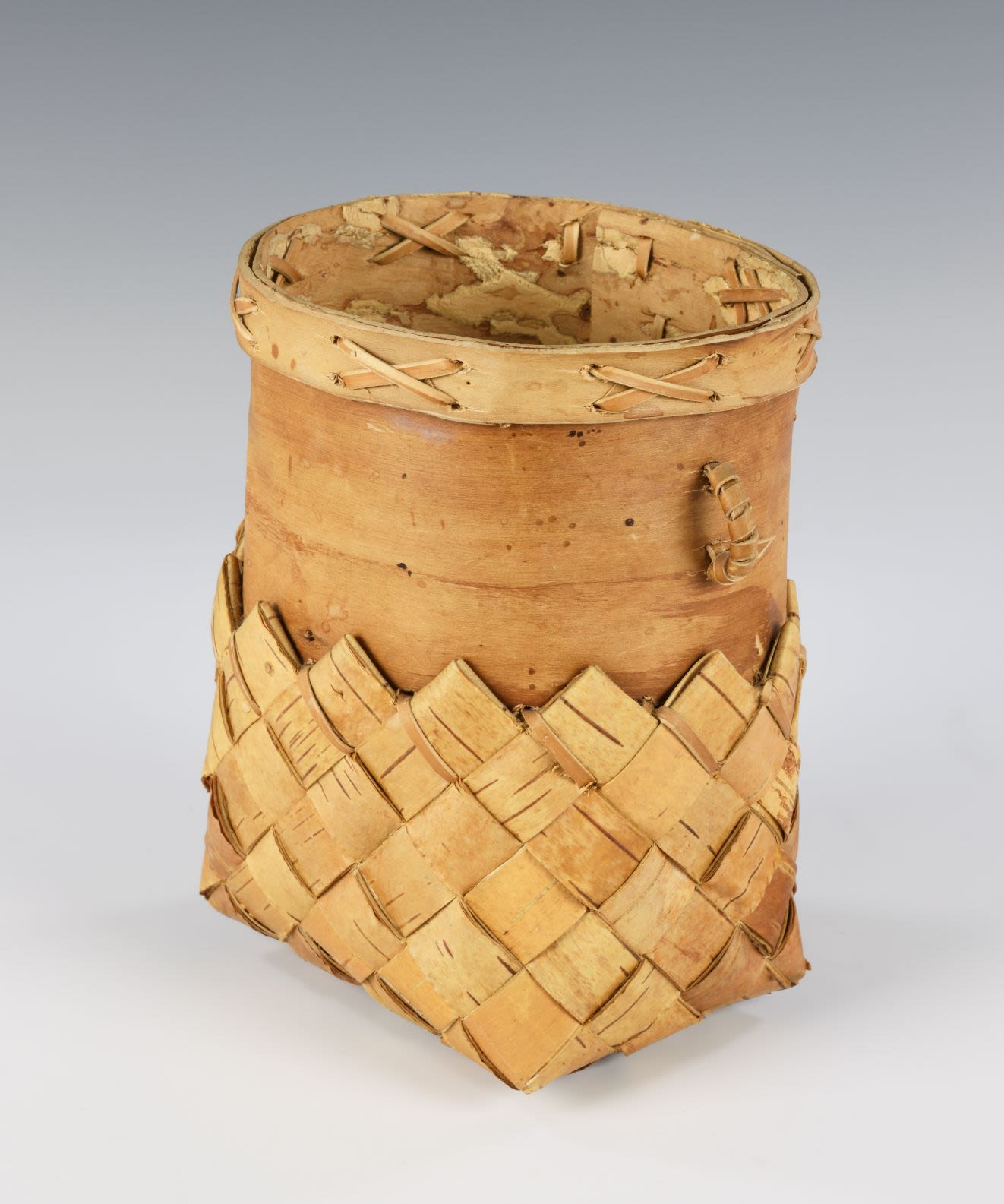
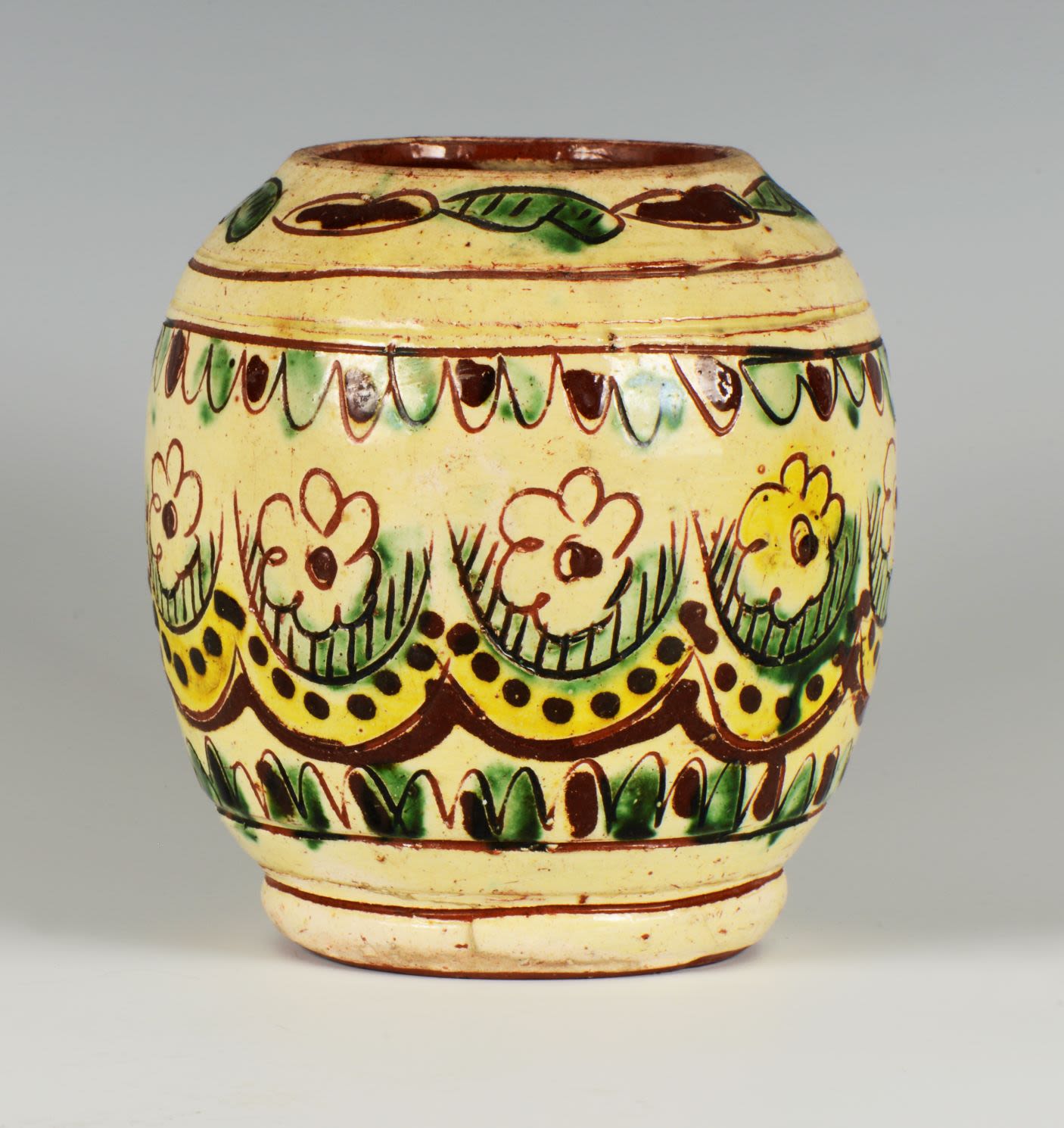
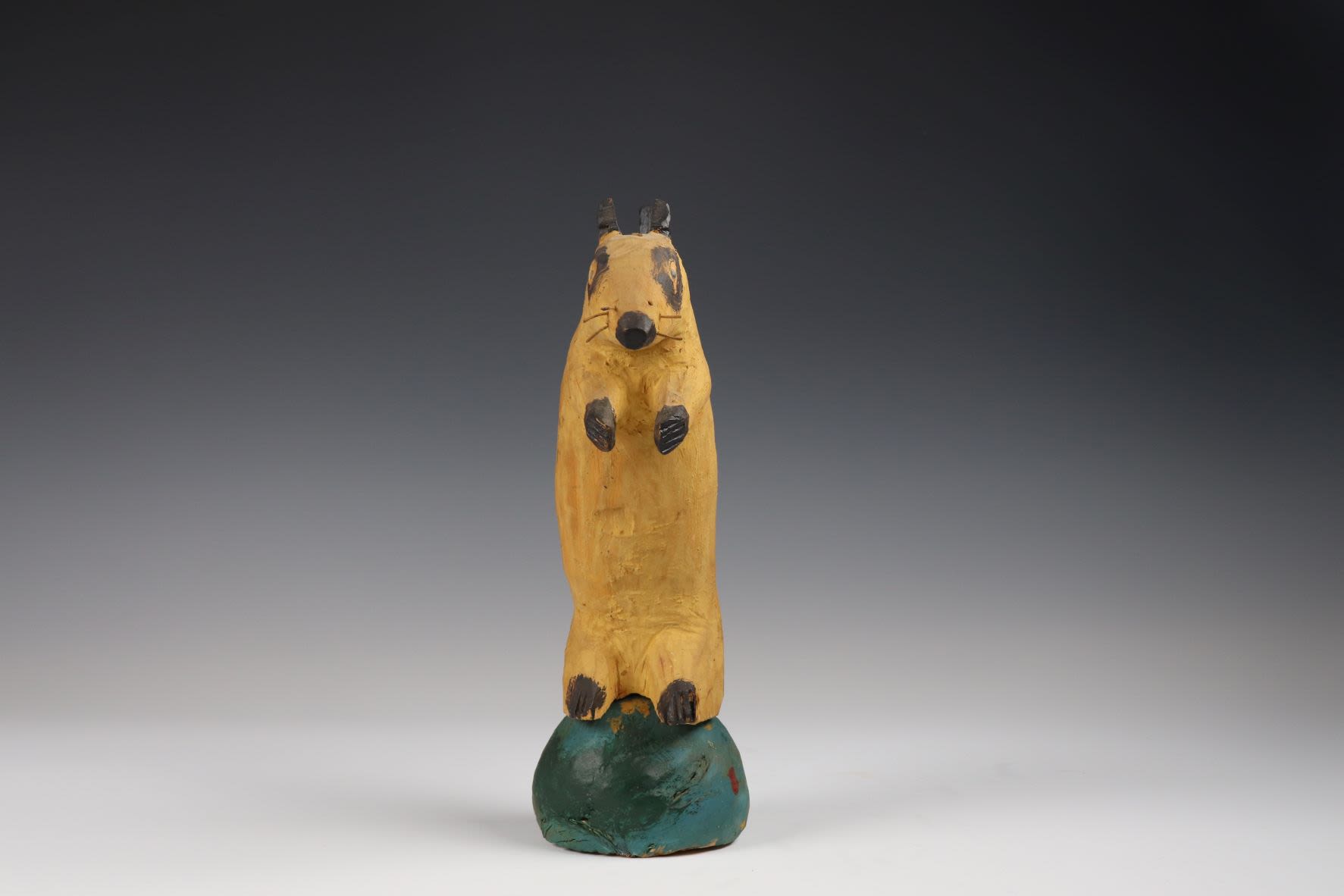
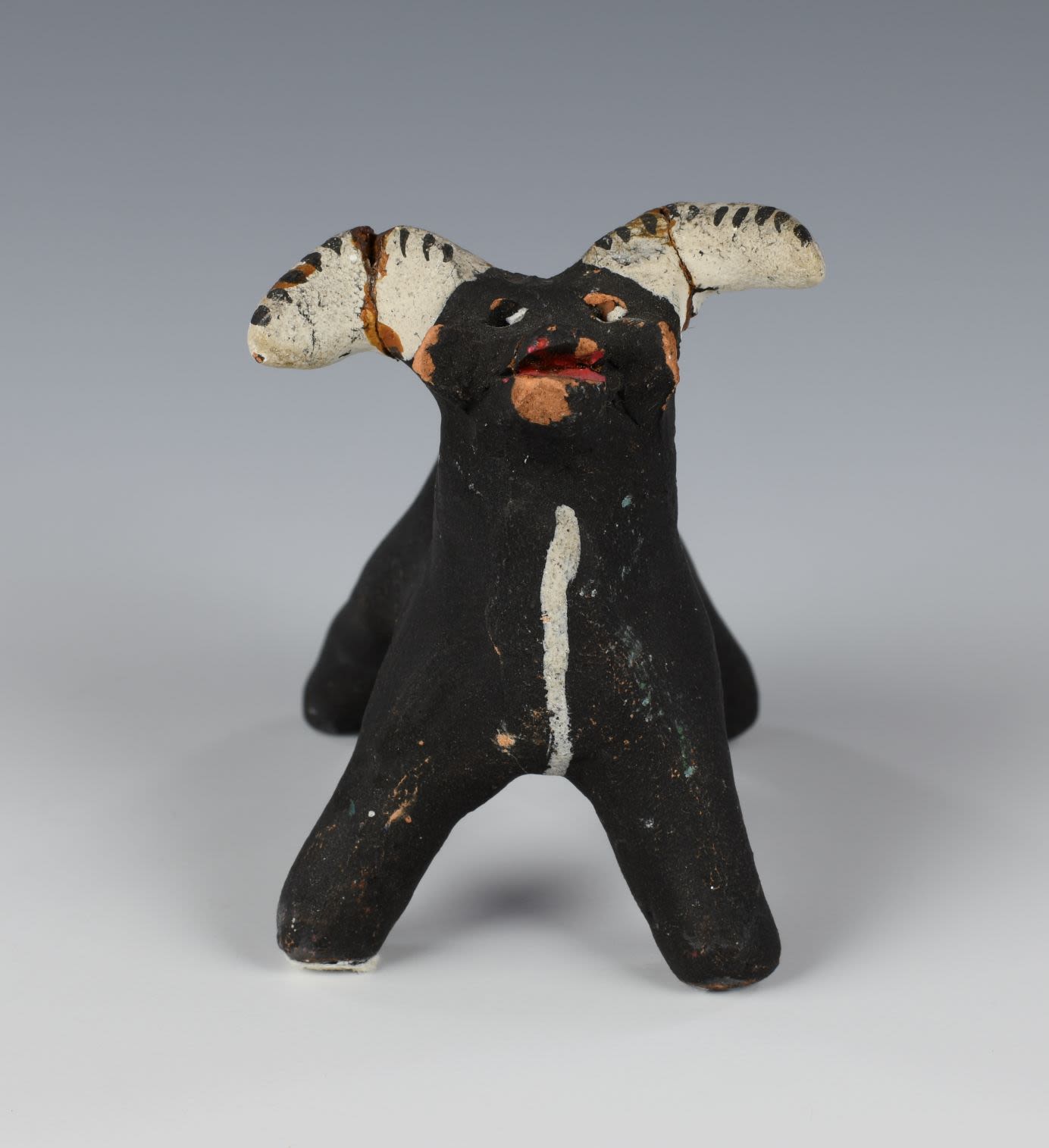
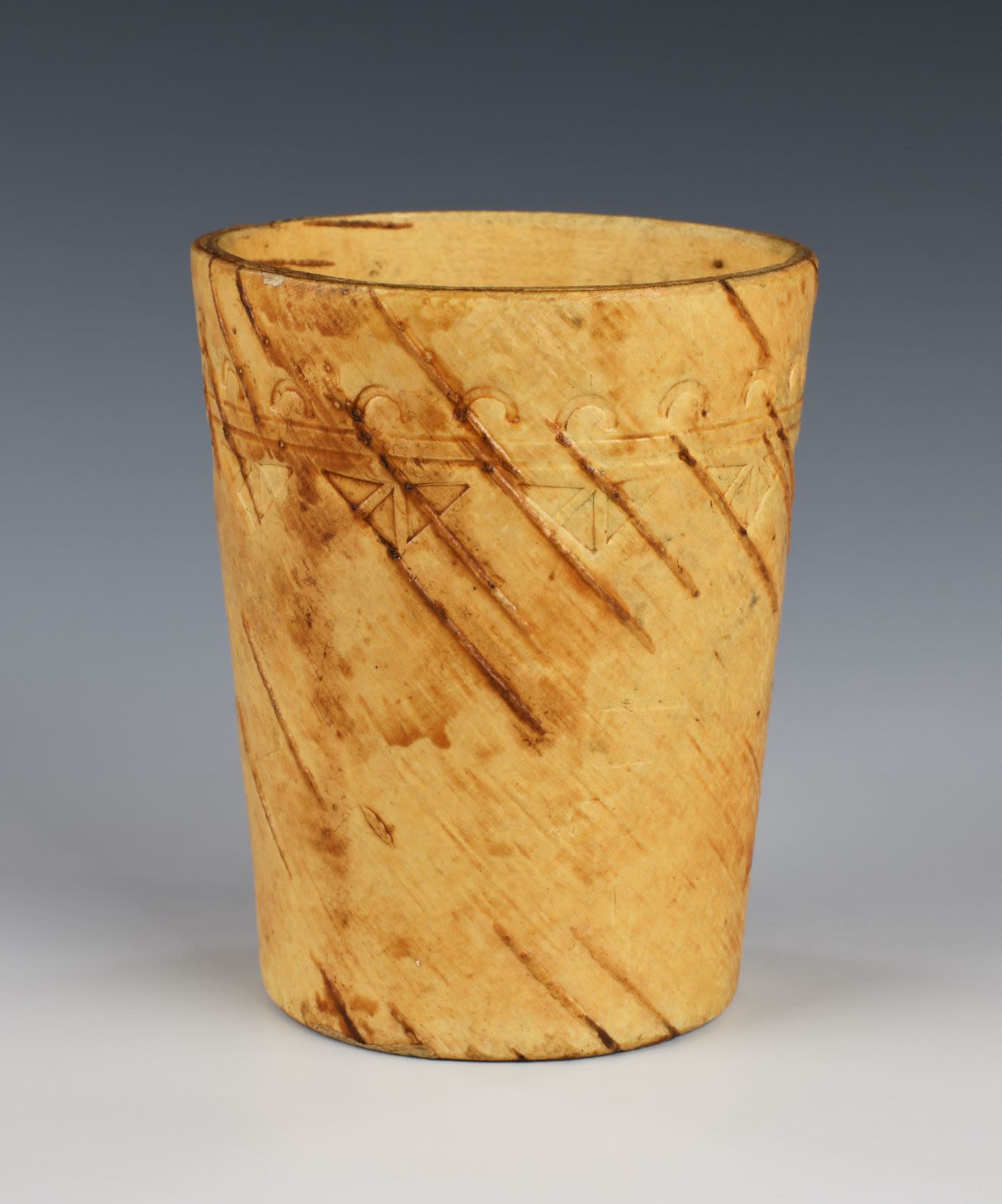
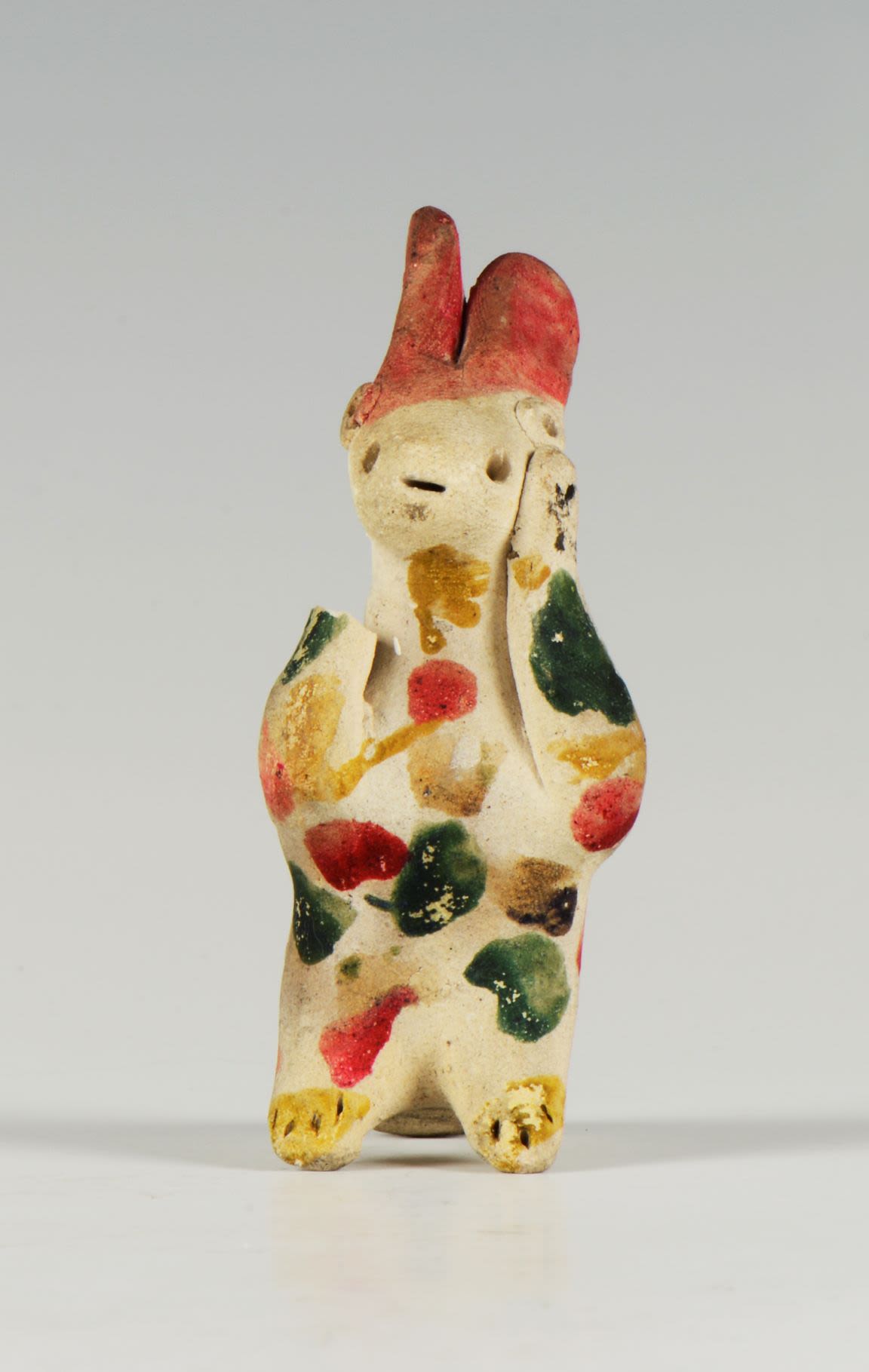
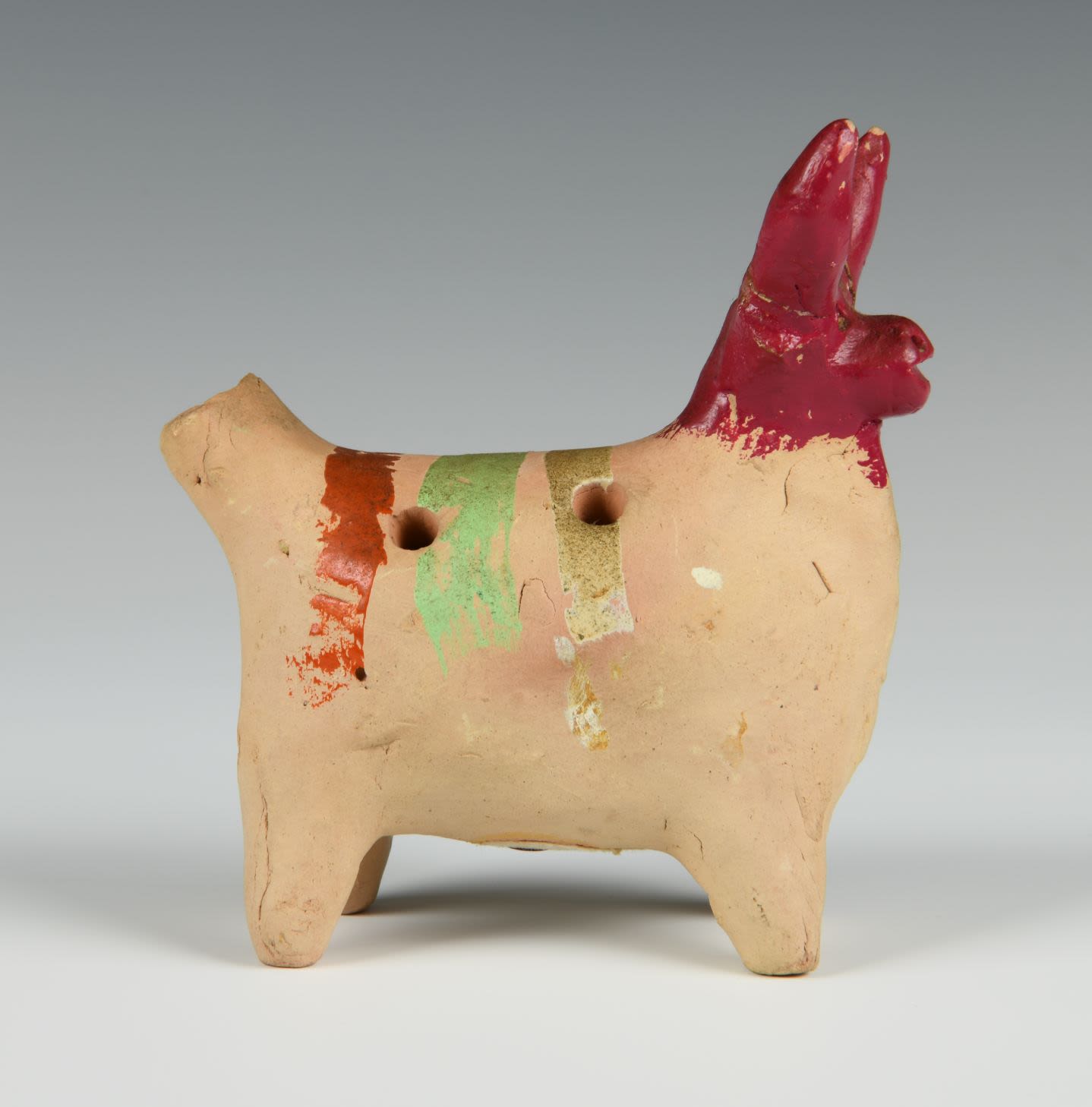
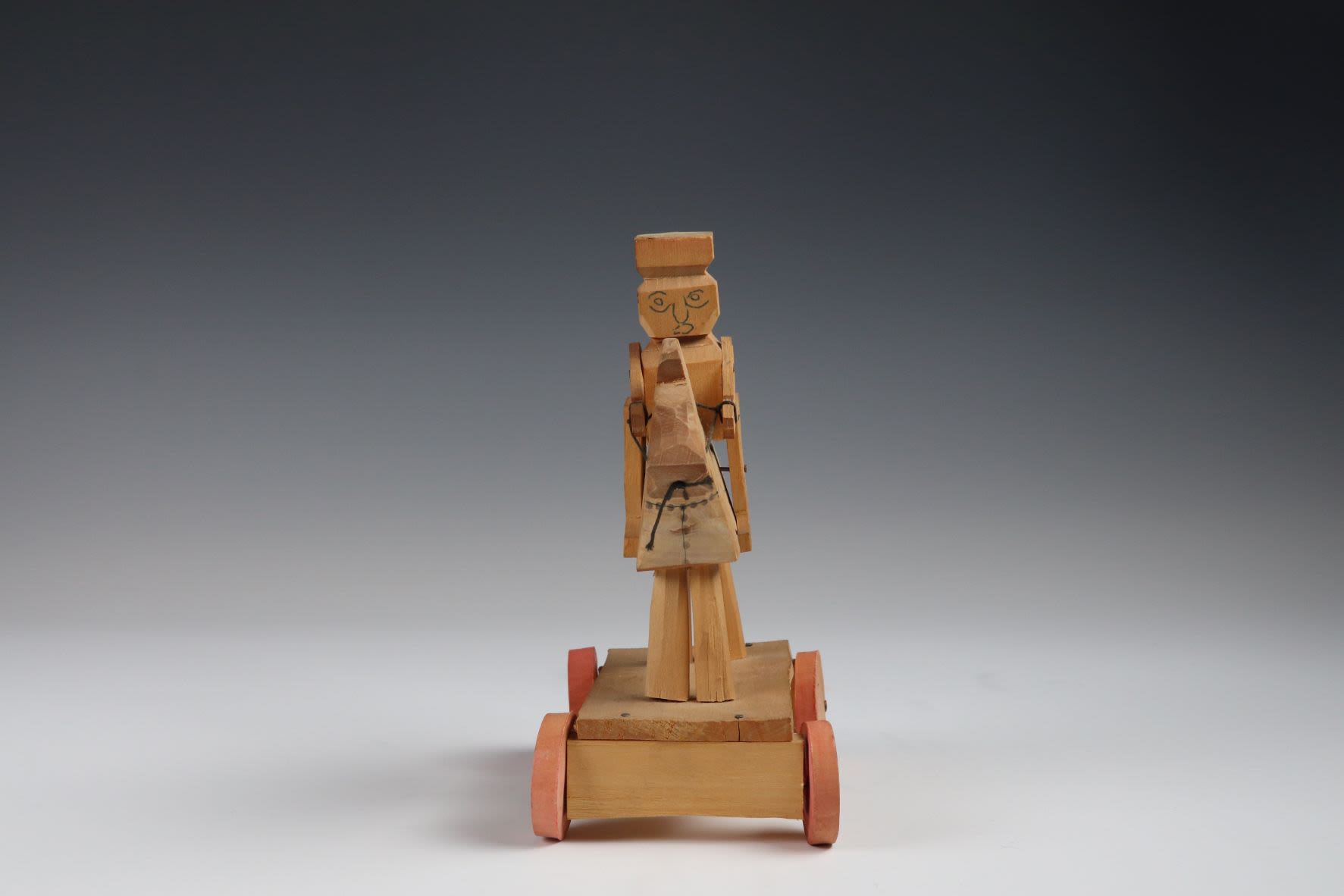

DUROM.2015.14 Zhostovo lacquer tray-plate with hand-painted floral designs, often used for serving tea and desserts.
DUROM.2015.14 Zhostovo lacquer tray-plate with hand-painted floral designs, often used for serving tea and desserts.

DUROM.2015.11 Khokhloma wooden jar with a lid, lacquered black surface with gold and red floral patterns on it, possibly container for rice or grain.
DUROM.2015.11 Khokhloma wooden jar with a lid, lacquered black surface with gold and red floral patterns on it, possibly container for rice or grain.

DUROM.2015.17 Birch bark jar called a tuesok or tues. The jar is decorated with geometric patterns and is possibly used for storing rice or grain.
DUROM.2015.17 Birch bark jar called a tuesok or tues. The jar is decorated with geometric patterns and is possibly used for storing rice or grain.

DUROM.2015.46 Clay whistle from unknown region, moulded clay in the shape of a man riding a ram, painted with green, yellow and red.
DUROM.2015.46 Clay whistle from unknown region, moulded clay in the shape of a man riding a ram, painted with green, yellow and red.

DUROM.2015.77 Zhbannikov clay whistle, moulded clay deer, decorated with white, blue and red spotted patterns.
DUROM.2015.77 Zhbannikov clay whistle, moulded clay deer, decorated with white, blue and red spotted patterns.

DUROM.2015.64 Clay toy of a figure with a hen. The toy is painted with white colour and is highly decorated with a linear pattern of yellow, red, grey stripes and other patterns. The figure wears a red jacket.
DUROM.2015.64 Clay toy of a figure with a hen. The toy is painted with white colour and is highly decorated with a linear pattern of yellow, red, grey stripes and other patterns. The figure wears a red jacket.

DUROM.2015.6 Khokhloma spoon, lacquered wooden spoon with painted floral design, possibly for serving soup.
DUROM.2015.6 Khokhloma spoon, lacquered wooden spoon with painted floral design, possibly for serving soup.

DUROM.2015.97 Balkhar clay jug, painted with floral and geometric patterns, possibly used for carrying water.
DUROM.2015.97 Balkhar clay jug, painted with floral and geometric patterns, possibly used for carrying water.

DUROM.2015.85 Clay whistle from unknown region, moulded clay in the shape of a ram holding an unknown object using its front legs, decorated with painted mesh pattern.
DUROM.2015.85 Clay whistle from unknown region, moulded clay in the shape of a ram holding an unknown object using its front legs, decorated with painted mesh pattern.

DUROM.2015.7.1 Khokhloma spoon, lacquered wooden spoon with painted floral design, possibly for serving soup.
DUROM.2015.7.1 Khokhloma spoon, lacquered wooden spoon with painted floral design, possibly for serving soup.

DUROM.2015.72 Clay whistle from unknown region, moulded painted figures depicts an unrecognisable creature, probably a bird.
DUROM.2015.72 Clay whistle from unknown region, moulded painted figures depicts an unrecognisable creature, probably a bird.

DUROM.2015.96 Balkhar clay toy, moulded clay toy of a mysterious animal, decorated with geometric patterns.
DUROM.2015.96 Balkhar clay toy, moulded clay toy of a mysterious animal, decorated with geometric patterns.

Wooden painted and lacquered container on loan from the Sokolov family, decorated with floral designs. The Sokolovs use it to store needlework.
Wooden painted and lacquered container on loan from the Sokolov family, decorated with floral designs. The Sokolovs use it to store needlework.

DUROM.2015.90 Made in the Russian village of Balkhar. The rider and animal, which may be a donkey, are decorated with stripes and swirls using white pigment.
DUROM.2015.90 Made in the Russian village of Balkhar. The rider and animal, which may be a donkey, are decorated with stripes and swirls using white pigment.

DUROM.2015.45 Dymkovo moulded clay toy in the shape of a cow. The toy has a white background painted with orange, black and yellow pigments.
DUROM.2015.45 Dymkovo moulded clay toy in the shape of a cow. The toy has a white background painted with orange, black and yellow pigments.

DUROM.2015.76 Abashevo clay whistle, moulded clay in the shape of a dog with a puppy, black surface with golden paint.
DUROM.2015.76 Abashevo clay whistle, moulded clay in the shape of a dog with a puppy, black surface with golden paint.

DUROM.2015.27 birch bark container with two separate parts that was possibly used for storing rice or grain in the household.
DUROM.2015.27 birch bark container with two separate parts that was possibly used for storing rice or grain in the household.

DUROM.2015.19 Khokhloma jar painted with floral patterns and geometric designs in brown, yellow and green pigments on a faded yellow background.
DUROM.2015.19 Khokhloma jar painted with floral patterns and geometric designs in brown, yellow and green pigments on a faded yellow background.

DUROM.2015.53 Wooden squirrel standing on a green-painted base in a leaning pose. The tail is attached with nails.
DUROM.2015.53 Wooden squirrel standing on a green-painted base in a leaning pose. The tail is attached with nails.

DUROM.2015.40 The clay figure is in the shape of a cow. The cow has white horns with black stripes. Clay toys such as this were made in the Russian town of Kargopol.
DUROM.2015.40 The clay figure is in the shape of a cow. The cow has white horns with black stripes. Clay toys such as this were made in the Russian town of Kargopol.

DUROM.2015.16 Birch wood container possibly used for storing grain or rice in the household. The container has geometric decorations all around the top.
DUROM.2015.16 Birch wood container possibly used for storing grain or rice in the household. The container has geometric decorations all around the top.

DUROM.2015.38 Clay whistle from unknown region, moulded clay in the shape of a rabbit. The whistle is decorated with green, red, black and yellow pigments on an unpainted white surface.
DUROM.2015.38 Clay whistle from unknown region, moulded clay in the shape of a rabbit. The whistle is decorated with green, red, black and yellow pigments on an unpainted white surface.

DUROM.2015.84 the figure is made of clay and is possibly a cow. The holes suggest that it was a whistle. The head and ears are painted red and the body has three painted stripes in orange, green and gold.
DUROM.2015.84 the figure is made of clay and is possibly a cow. The holes suggest that it was a whistle. The head and ears are painted red and the body has three painted stripes in orange, green and gold.

DUROM.2015.47 Wooden horse and rider on painted red wheels made in Fedoseyevo.
DUROM.2015.47 Wooden horse and rider on painted red wheels made in Fedoseyevo.
Further Reading ...
Afanasyev, Alexander (2020) 'Tales from Russian Folklore' , Richmond, Surrey: Alma Books Ltd. First published in Russian between 1855-1863.
Hilton, Alison (2011) 'Russian Folk Art', Bloomington, Indiana: Indiana University Press.
Freeze, Gregory L. (2002) 'Russia a History,' Oxford: Oxford Press
Gilchrist, Cherry (2009) 'Russian Magic, Living Folk traditions of an Enchanted Landscape' Wheaton, IL: Quest Books
State Russian Museum (2002) 'Russian Folk Toys in the collection of the Russian Museum.' St Petersburg: Palace Editions
The Museum of Russian Art (2010). Online Exhibit, 'A Homespun Life: Textiles of Old Russia.'
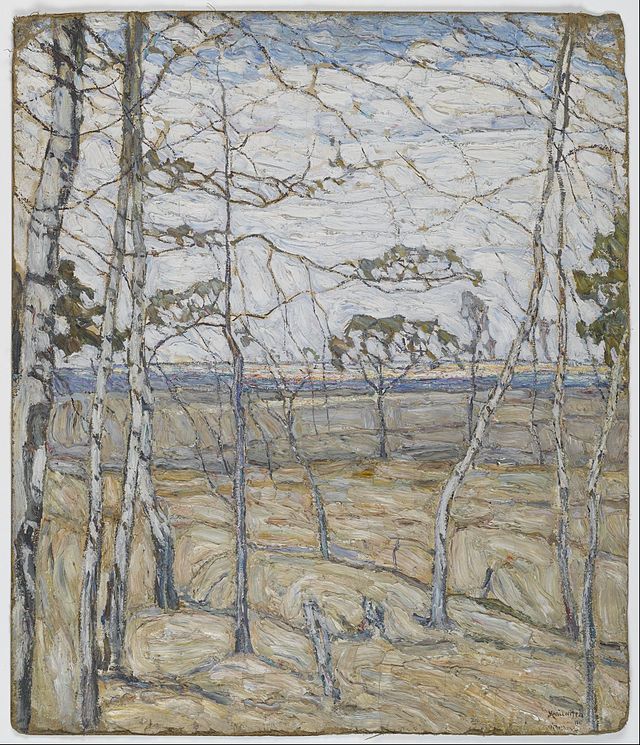
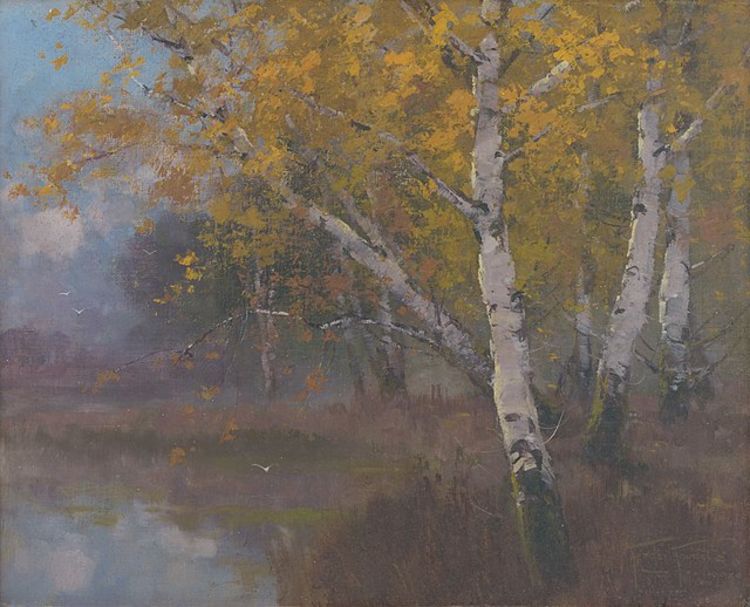
Interviewing the Sokolov family about Kirill Sokolov's collection


Click below to explore the Sokolov Collection further ...
The link will bring you to a search result page. Click on the object name to learn more information.

If you use the search term of 'Kirill Sokolov,' you will find a full listing of all of Sokolov's works in the university's collections in addition to the Russian folk art.

Thank you for completing our online evaluation form!
Meet the Russian Folk Art group
We are from all over the world; China, England, Italy, Belgium and the United States.
This is us in front of 'The Angel of the North' by Antony Gormley in Gateshead.
